Japan’s cultural capital, Kyoto, is a popular destination for domestic and international tourists alike.
The Ritz-Carlton, Kyoto, has long been exalted as one of the best properties in Japan, and even in the entire chain. I was very eager to experience it for myself during a Summer 2019 visit to Asia, as it had been at the top of my must-stay list for quite some time.
Amy also visited this property with her family on a Spring Break 2023 trip to Japan, and we’ve updated this review to reflect her experience.
In This Post
The Ritz-Carlton, Kyoto – Booking
At the time, I had the opportunity to take advantage of a sweet spot of redeeming 60,000 Bonvoy points per night for top-tier hotels (which lasted until March 2019). I knew this would be the golden opportunity to slot in a three-night stay at The Ritz-Carlton, Kyoto and kick off our summer trip to Asia in style.
Since I was making bookings at these high-end Bonvoy hotels rather speculatively back in early 2019, I had actually booked two separate reservations at the Ritz-Carlton for two nights and one night, respectively, but I had no problem getting them combined into a three-night stay for 180,000 Bonvoy points in total.
Nowadays, Marriott Bonvoy uses a dynamic pricing model, and you can expect to pay 88,000–126,000 points per night. It goes to show how much has shifted with the program in the past four years.
That’s certainly a lot of points to spend, but could still prove worthwhile compared to the cash rates, which usually hover around ¥120,000–175,000 ($1,200–1,750 CAD) per night, but can shoot up to ¥250,000 ($2,500 CAD) or more during popular seasons.
I actually booked two rooms for my stay. The Ritz-Carlton, Kyoto, and many hotels in Japan for that matter, have a maximum occupancy of four guests per room. As we were travelling as a family of five, we had to book two rooms here, but we decided to go for the splurge to see what the hype was all about.
Each room cost 92,000 points, which was at least towards the lower end of the dynamic pricing. We booked one using points, and the other using a Free Night Award worth 85,000 points from our Marriott Bonvoy Brilliant American Express Card, topped up with 7,000 points.
If booking the property isn’t possible using points, be sure to get in touch with us for quote. The Ritz-Carlton, Kyoto participates in Marriott STARS, a preferred partner program.
You’ll receive a suite of extra perks and benefits during your stay, such as a $100 (USD) credit and priority for upgrades, while still paying the same as the best available flexible rate for the hotel.
Book a hotel stay with Prince of Travel through Marriott STARS and enjoy exclusive additional benefits at no cost to you, including:
- Daily breakfast for two guests
- Room upgrade, subject to availability at check-in
- $100 (USD) property credit
- In-person welcome and personalized welcome amenity and note
- Third, Fourth, or Fifth Night Free at select properties
The Ritz-Carlton, Kyoto – Location
The Ritz-Carlton, Kyoto is located on the banks of the Kamo River, and boasts impressive views of the nearby Higashiyama mountains.
Just down the street from the hotel is the Kyoto Gyoen National Garden and the Kyoto Imperial Palace.
You’ll also have quick access to the Nishiki Market, which is just over five minutes by car or around 20 minutes away from the hotel on foot.
Kyoto Shiyakusho-mae station is the nearest Kyoto Subway station, which is less than a minute by car or just five minutes by foot. From there, you’ll have access to the rest of the city.
Kyoto Station is around 10 minutes from the hotel by car or around half an hour by transit.
Osaka Itami International Airport is the closest airport serving the area, generally handling domestic flights within Japan, and is located 60 minutes away by car or bus.
On the other hand, it’s a longer trek to Kansai International Airport, which is the major international port of entry into the Kansai region. Depending on your method of transportation, you can get to the hotel in 75 minutes by car or two hours by transit.
The Ritz-Carlton, Kyoto – Check-in
We arrived in Kyoto rather late in the day, having taken an evening flight from Tokyo Narita to Osaka Itami following our Japan Airlines business class flight from Chicago. Kyoto is served by the airports of the Osaka metro region (Itami, Kansai, and Kobe), all of which are a fair distance away from the city; Itami was the closest airport, and even from there, we only arrived in Kyoto by way of a one-hour airport limousine bus ride.
The zen-like entryway – a small covered roundabout area for vehicles, followed by a downward-sloping pathway leading to the entrance accompanied by a gently flowing stream of water – set the perfect tone for our stay, and I returned to take some photos of the hotel’s gorgeous exterior in the morning.
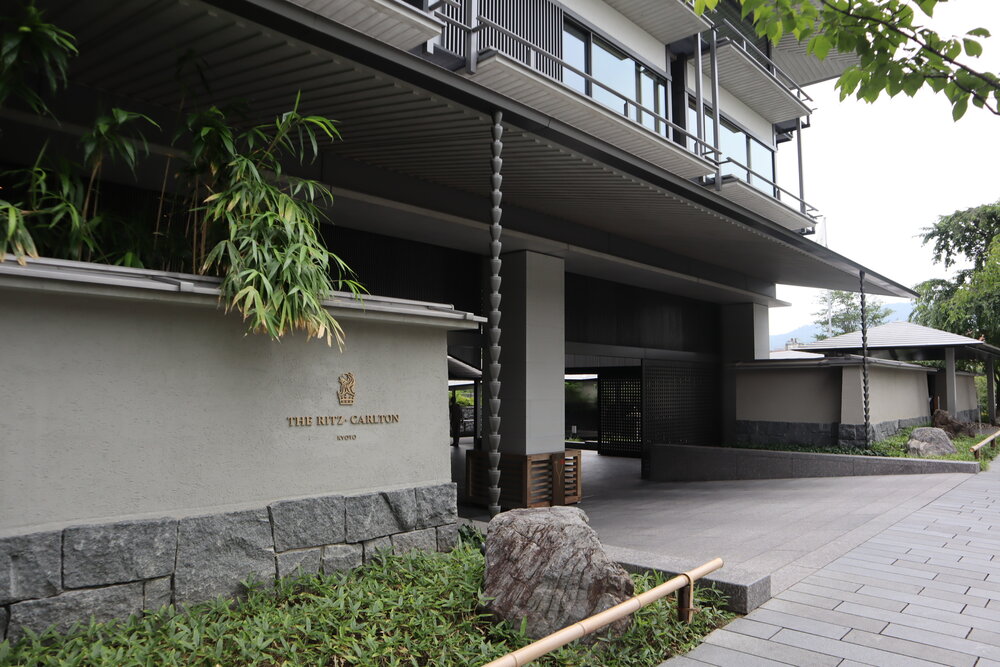
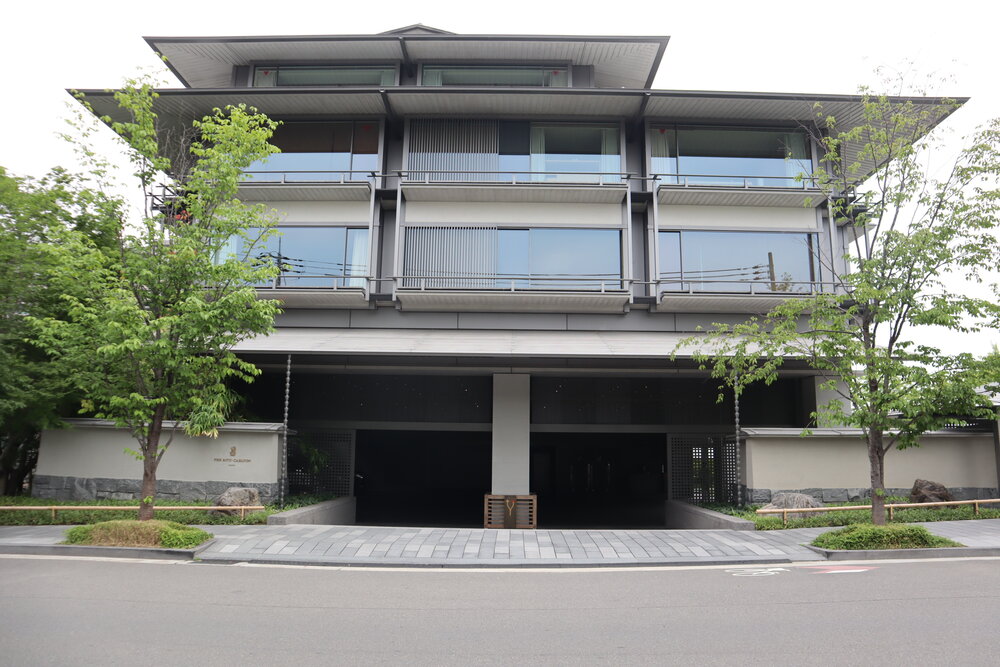
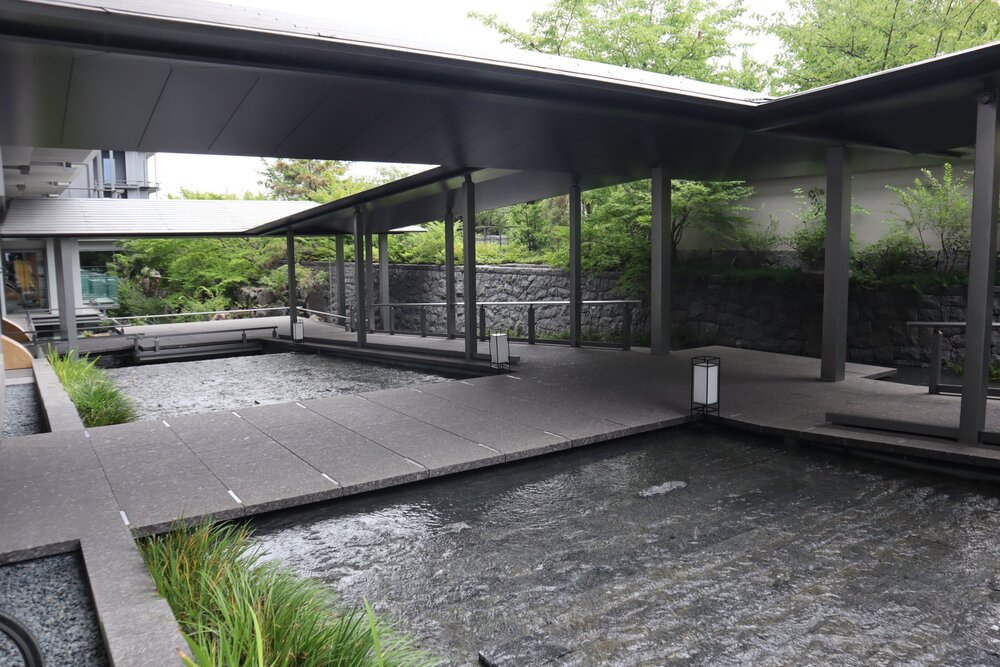
In a manner that you might not necessarily expect of the Ritz-Carlton brand, the hotel’s understated exterior – which mostly consists of simple grey stonework obscured by rows of bamboo shoots – makes it feel much more like a luxury private residence than a hotel and allows it to find its place effortlessly among the surrounding neighbourhood.
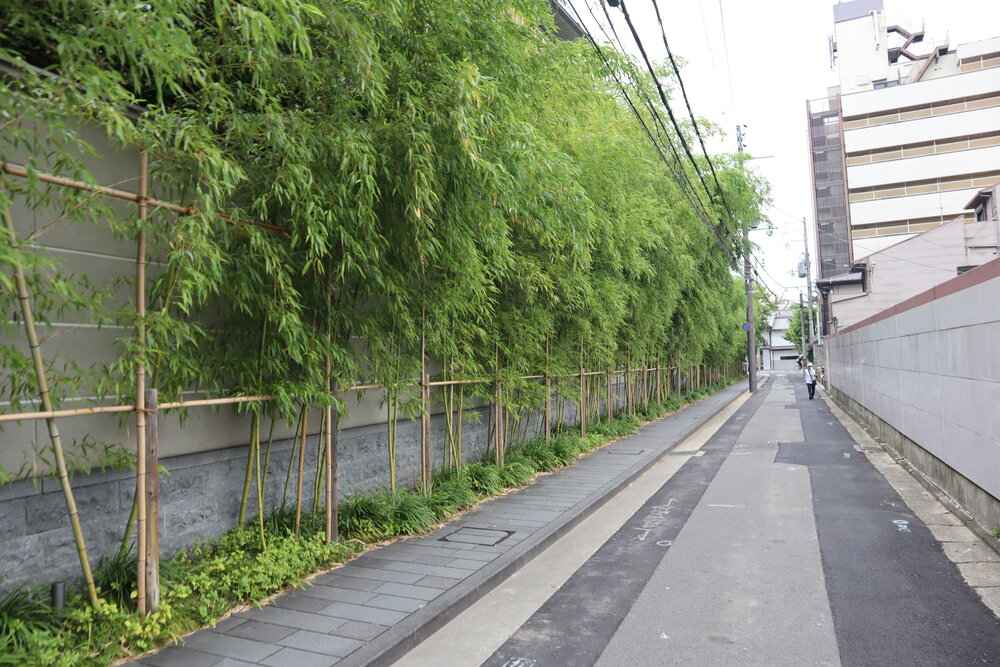
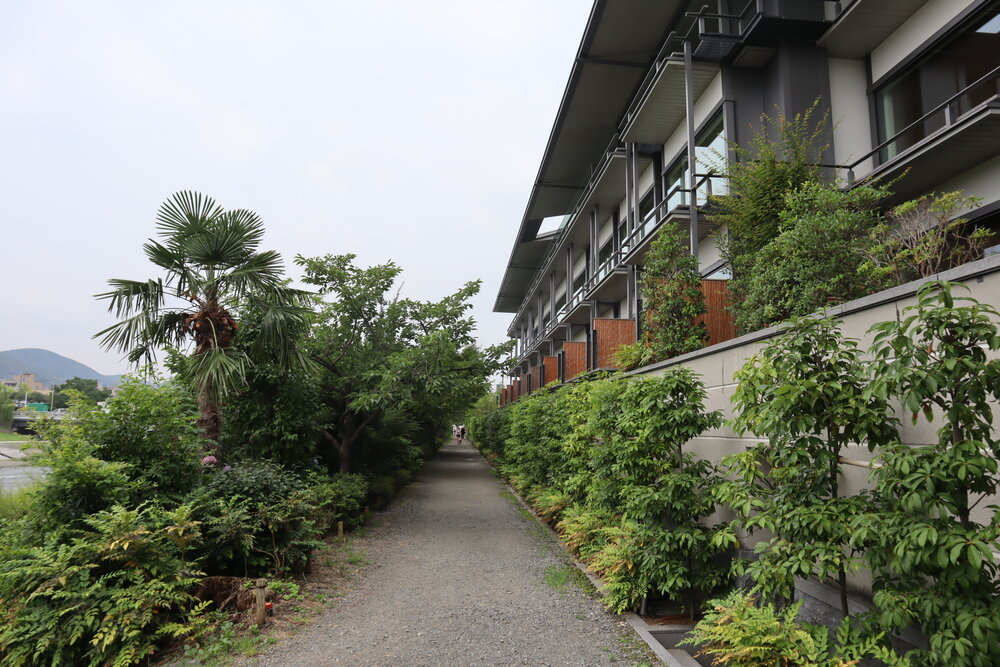
Following the stone pathway to the entrance, we step into a short hallway, which leads to the hotel’s stunning lobby.
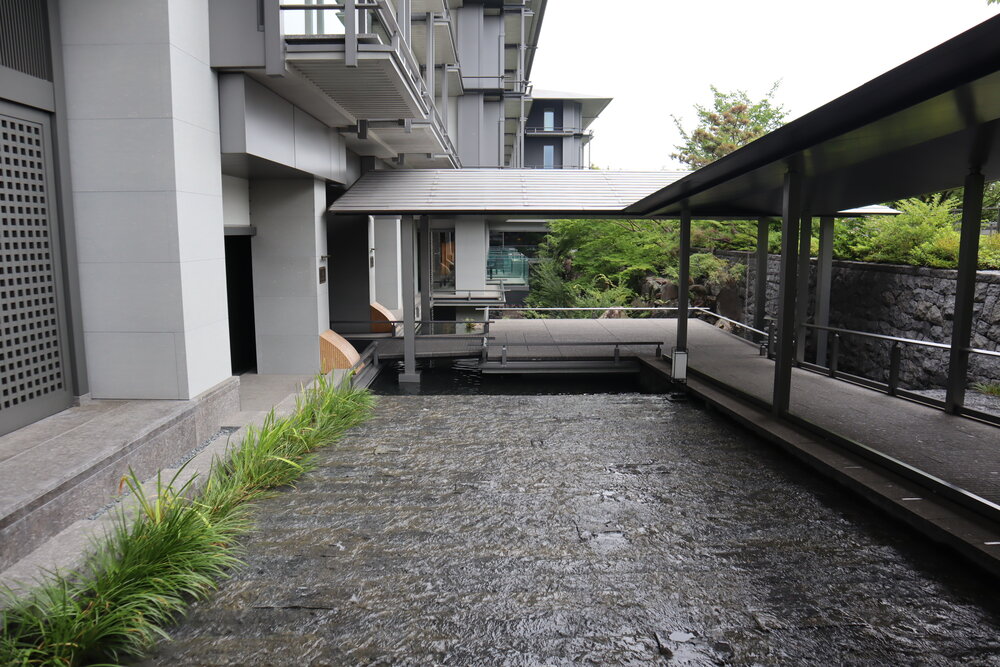
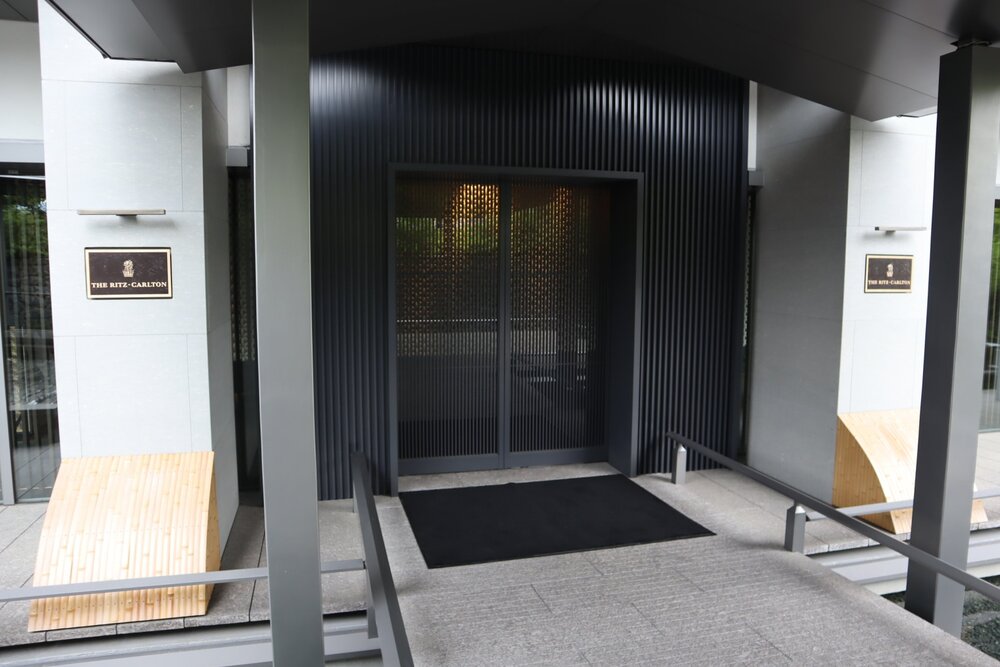
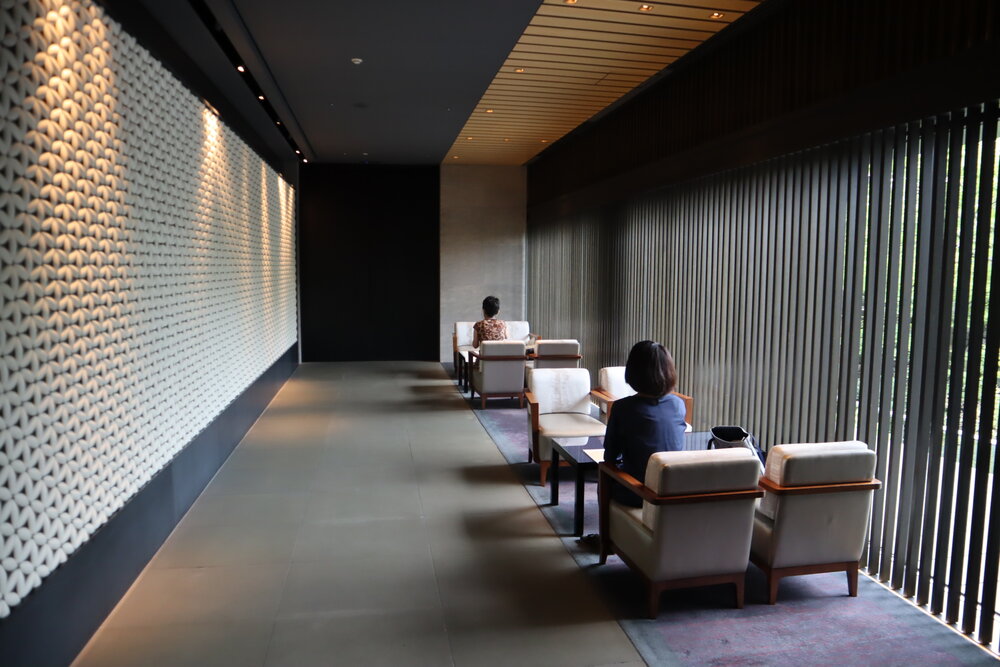
The Ritz-Carlton, Kyoto has one of the most elegantly designed lobbies and public areas that I’ve ever seen. Wood panelling, glass, and polished stone make up the principal textures, illuminated by a chorus of soft mood lighting.
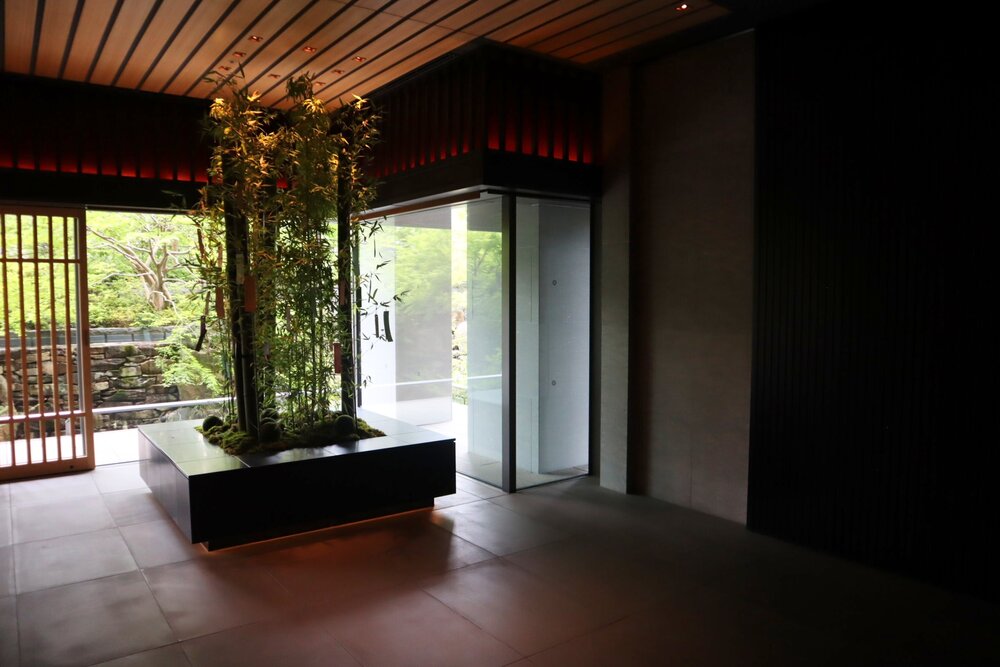
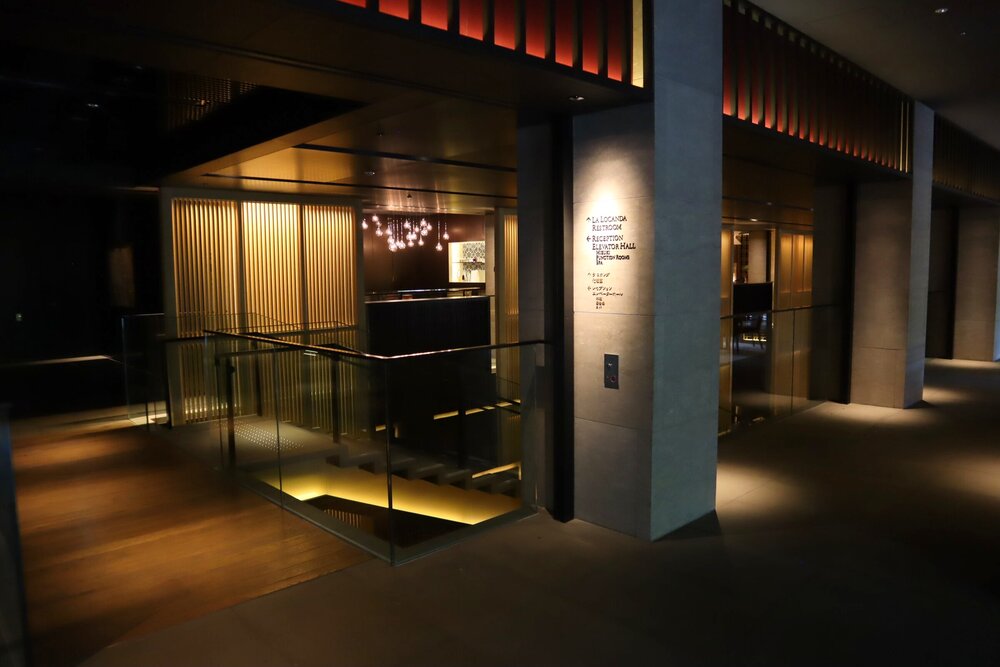
The lobby is composed of two hallways running the length of the building, each consisting of carefully-partitioned areas for the hotel’s cafe, the Pierre Hermé pastry shop, and pockets of lobby seating. The two hallways overlook a central staircase leading down to the lower level along with a beautiful modern chandelier that ties it all together.
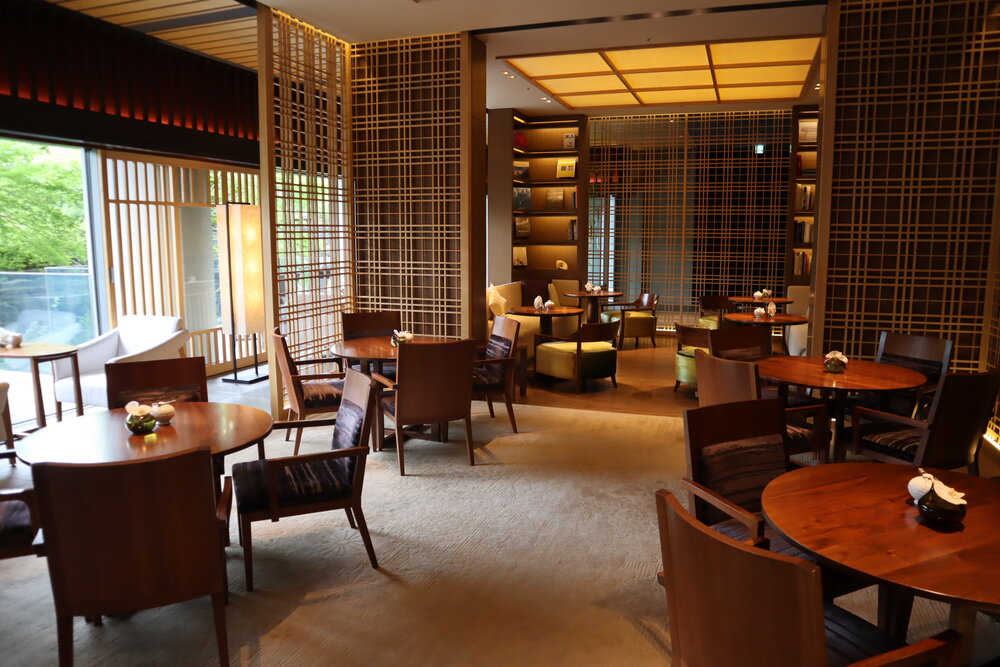
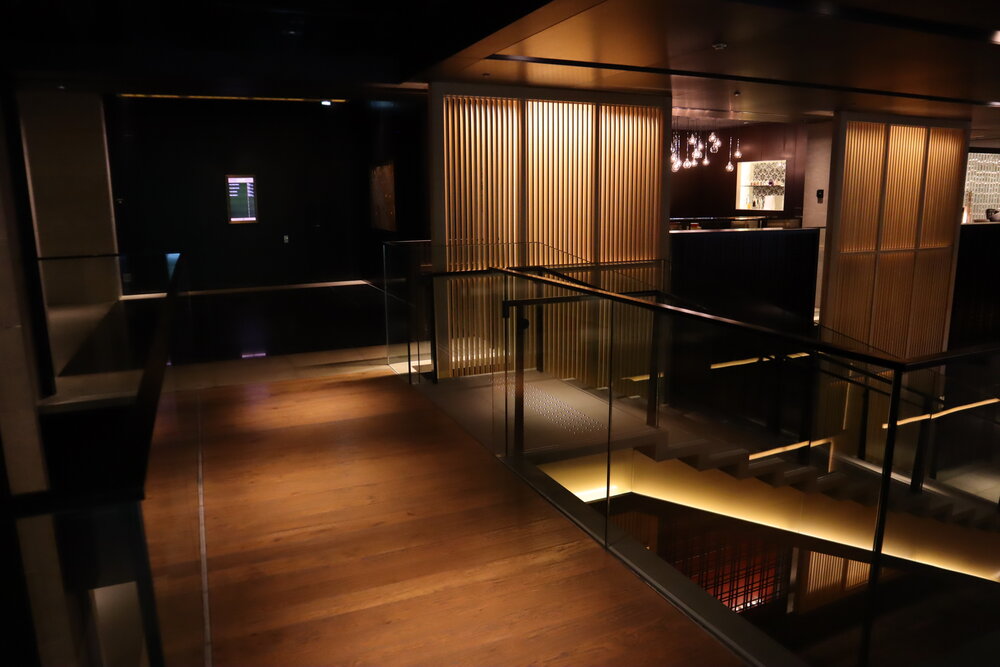
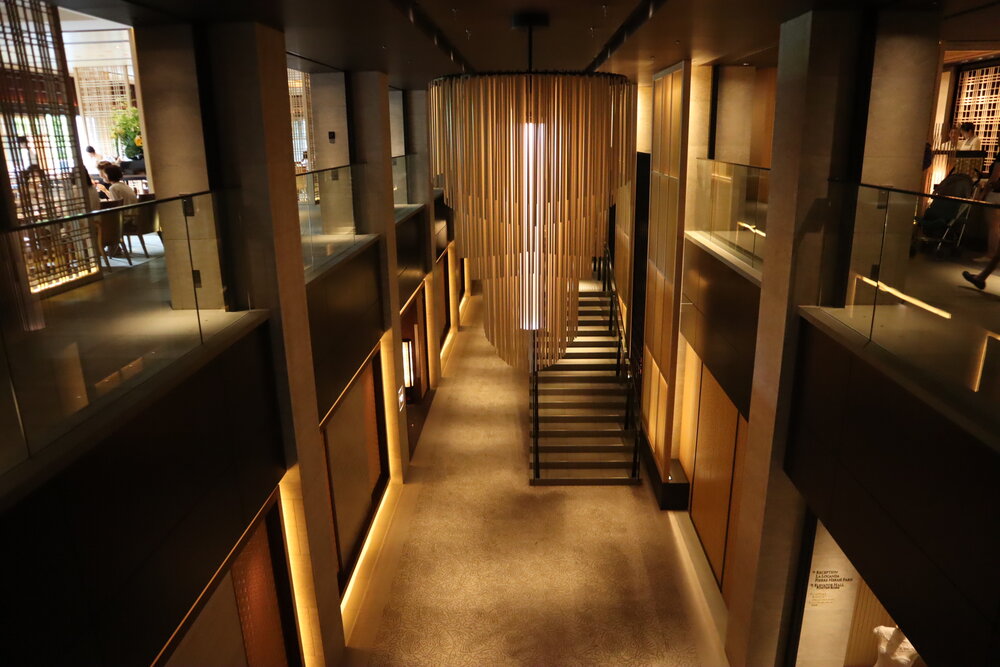
The space leaves a striking first impression with its masterful interpretation of both modern architecture and Japanese design sensibilities, and we quickly perked up from our sleepy demeanours when we first arrived.
A hotel associate sat down with us in one of the seating areas to begin the check-in process, although we would then proceed into the room itself in order to complete the “in-room check-in” – a Ritz-Carlton brand tradition that I’ve been treated to at select properties (though not all of them) in the past.
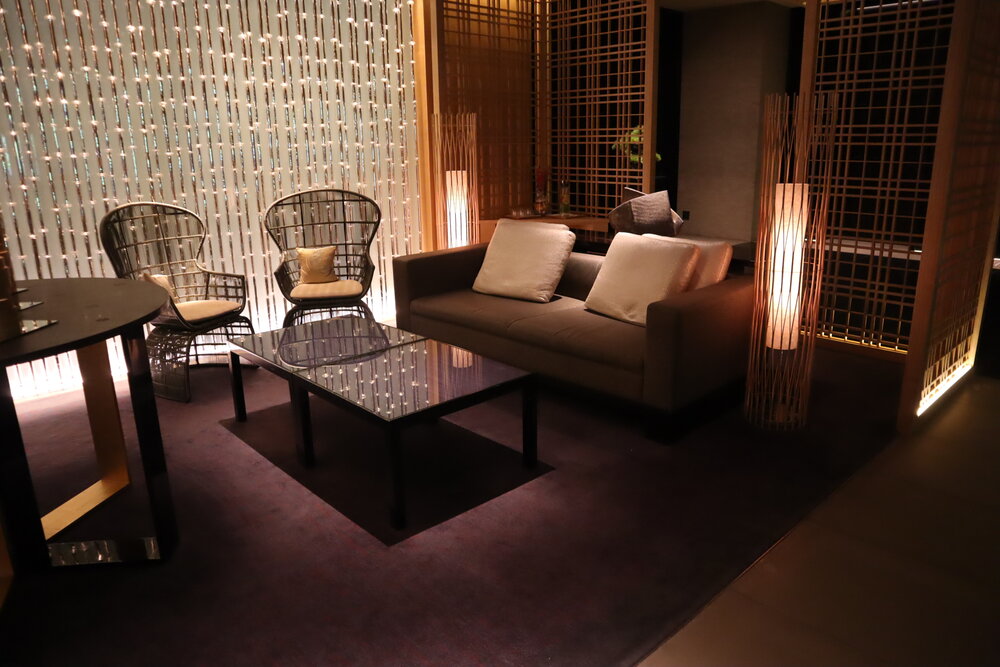
Despite my best attempts at “suite-talking” my way into an upgrade over the chat app for this stay, there was not one forthcoming in the end, and the check-in associate confirmed that we had been upgraded to a Deluxe Kyoto Room with views of the central courtyard.
I gave one more half-hearted attempt at the matter, asking “So there were no suites available as a Titanium member?” and was met with a bold-faced “sorry sir, we don’t have any suites available for this stay,” and I didn’t really have the energy to pursue it further.
Instead, we followed our associate into the elevators and made our way up to the third floor of the building.
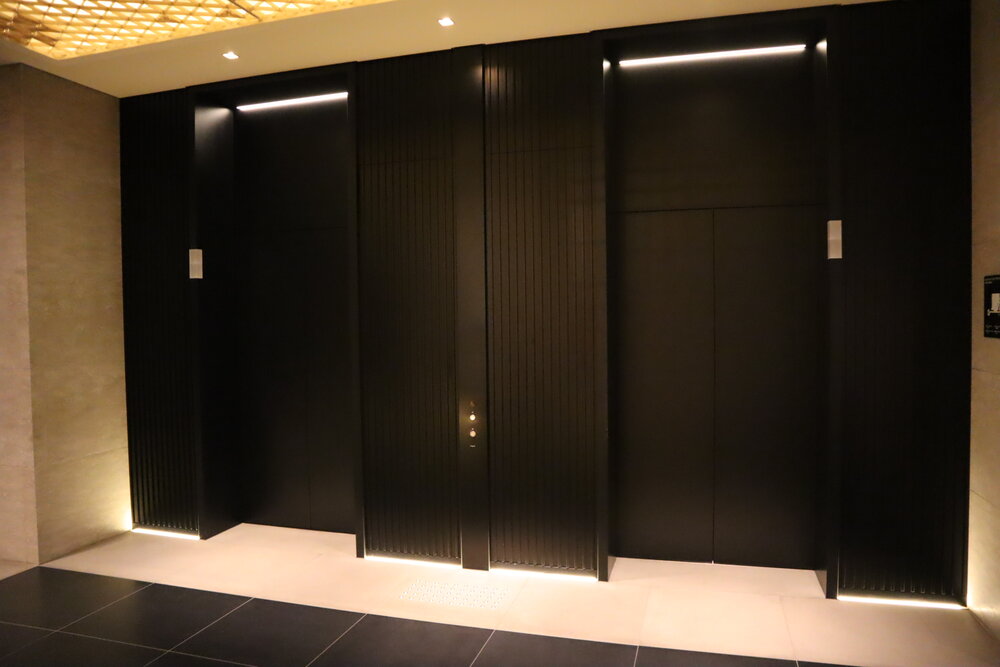
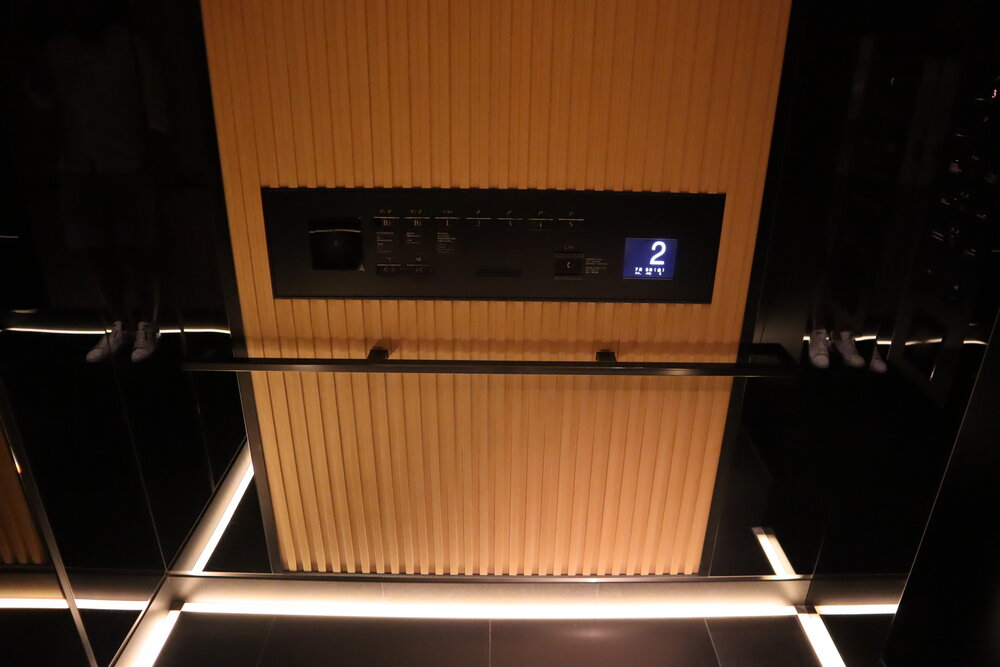
The Ritz-Carlton’s hallways retain the same sophisticated décor from the lobby, using soft warm lighting, tempered by a series of horizontal and vertical wooden screens, to create a sense of order and serenity.
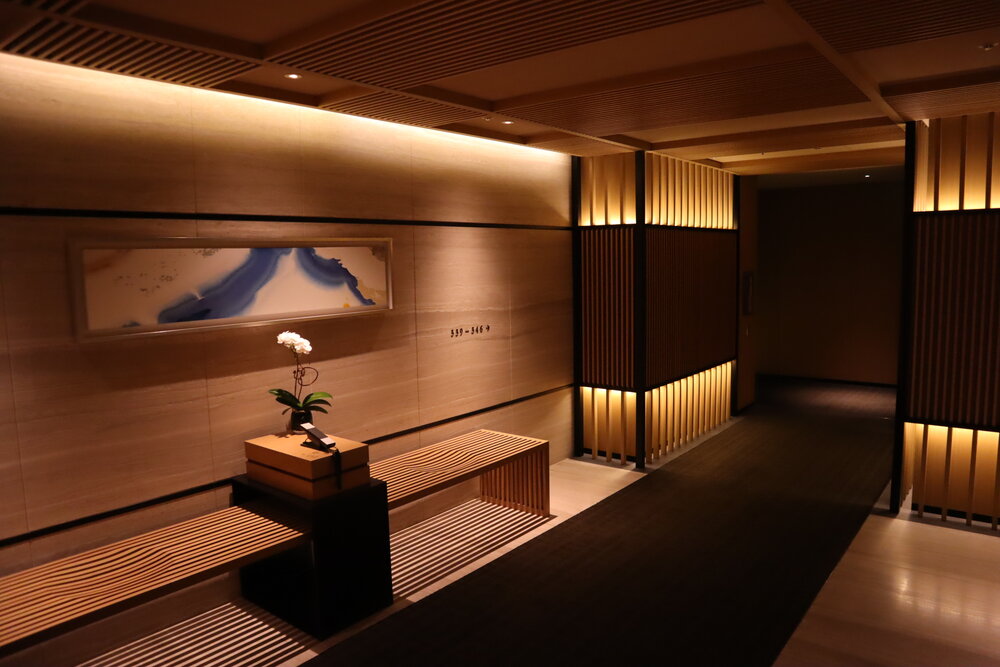
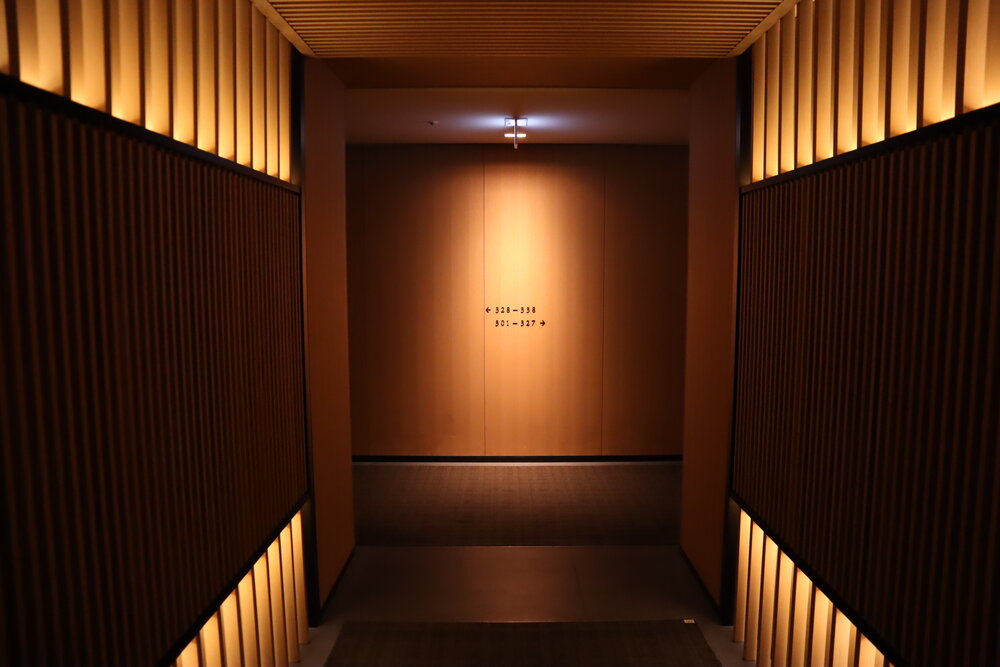

The Ritz-Carlton, Kyoto – Deluxe Kyoto Room
As you enter the room, you see in front of you two sets of hallways leading to the bedroom: one on the left side, which is a part of the open-concept bathroom, and another on the right side that serves as the walkway proper.
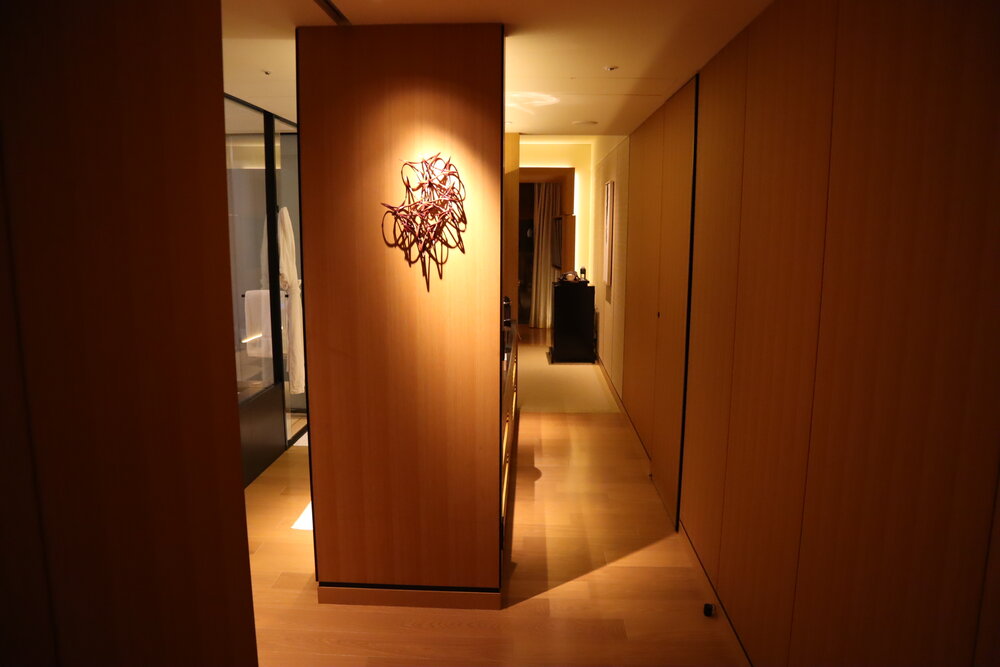
Let’s proceed down the hallway on the right, where the pantry and minibar is found along the side.
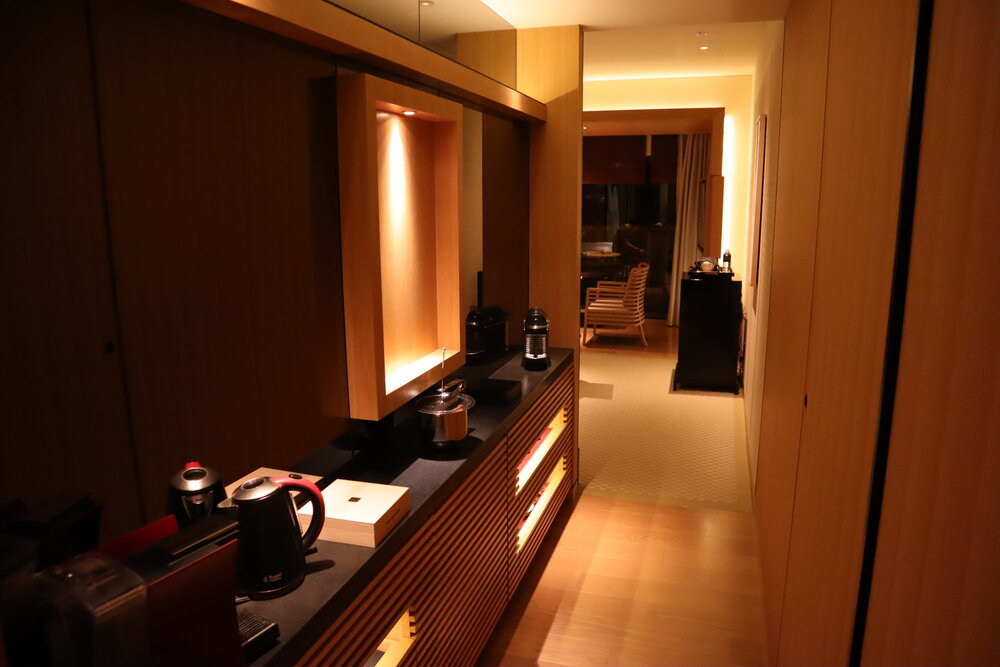
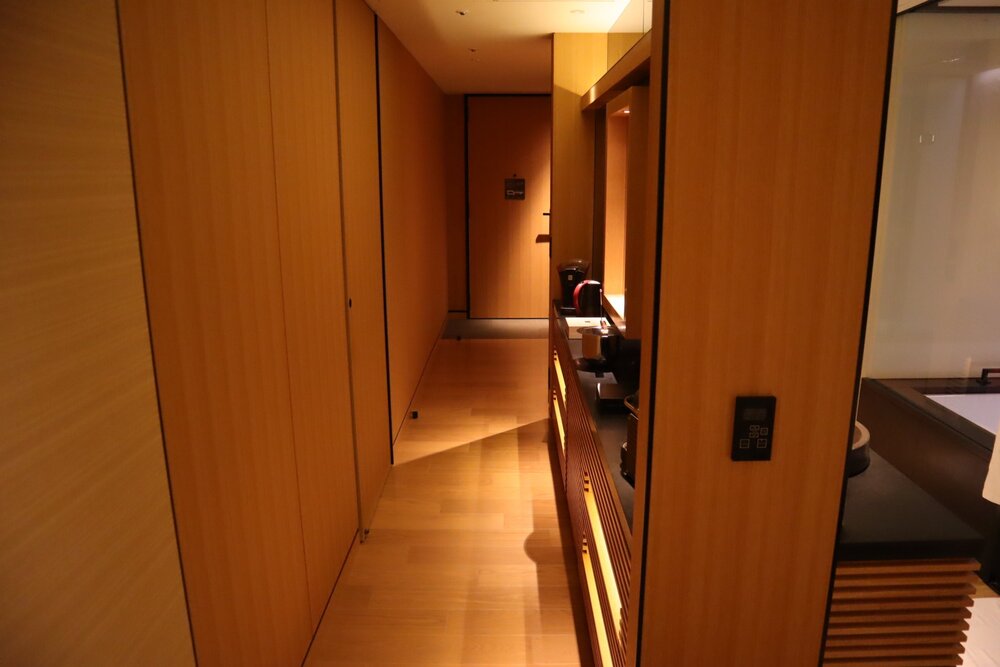
Here, there’s not one but two beverage machines: a Nespresso machine for the morning coffee, as well as a Special.T machine by Nestlé, which allows you to make tea in the same way that you would operate a Nespresso.
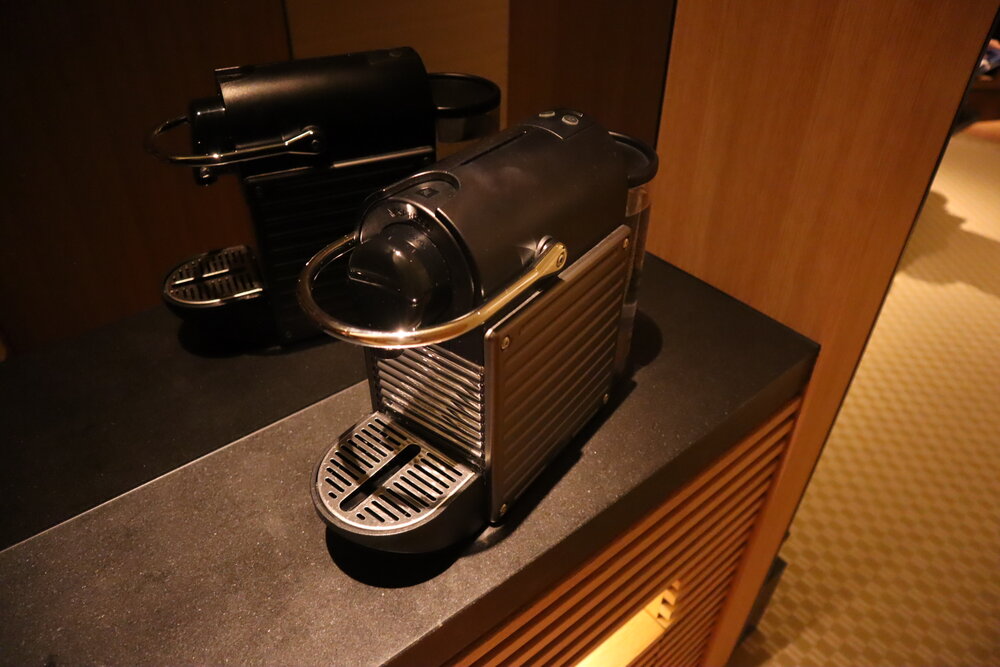
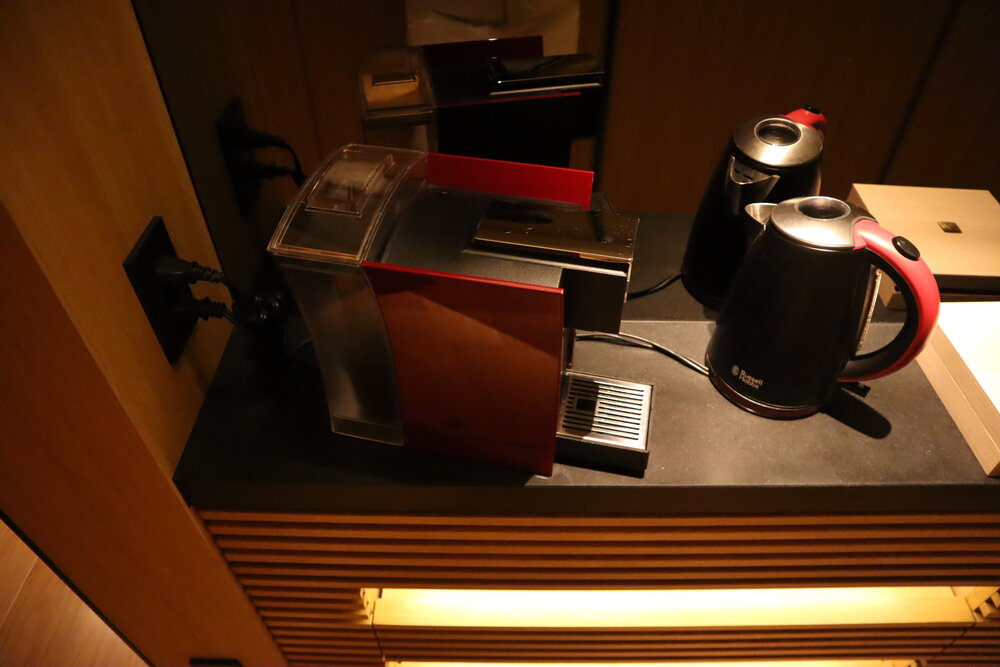
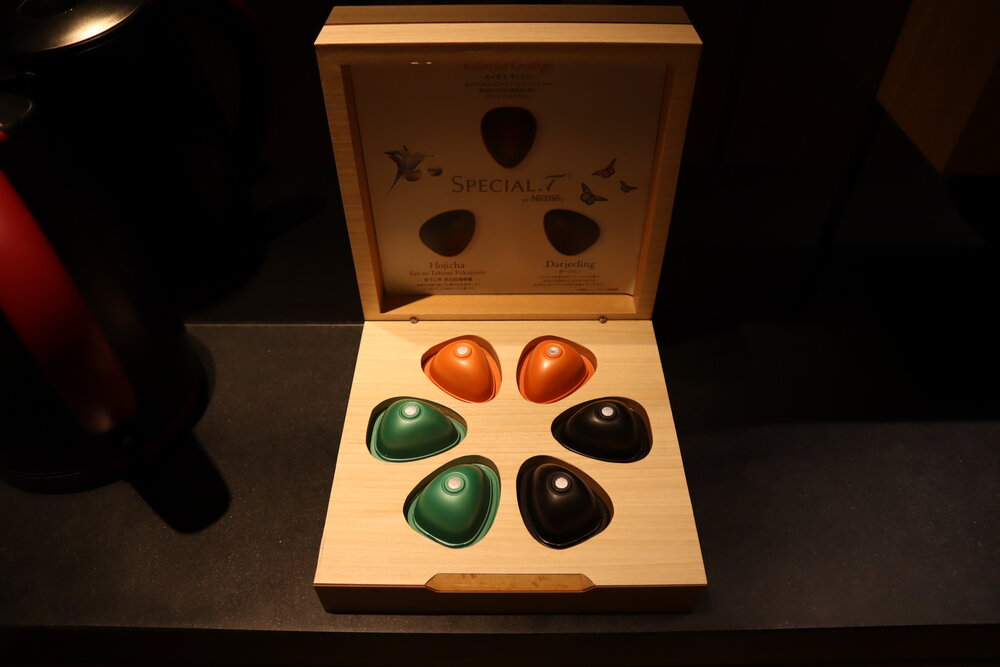
Continuing through, we arrive at the bedroom and sitting area, which I thought was relatively spacious for a non-suite room type. The king bed was a real pleasure to sleep in every night, especially given our crippling jet lag having just arrived in Asia.
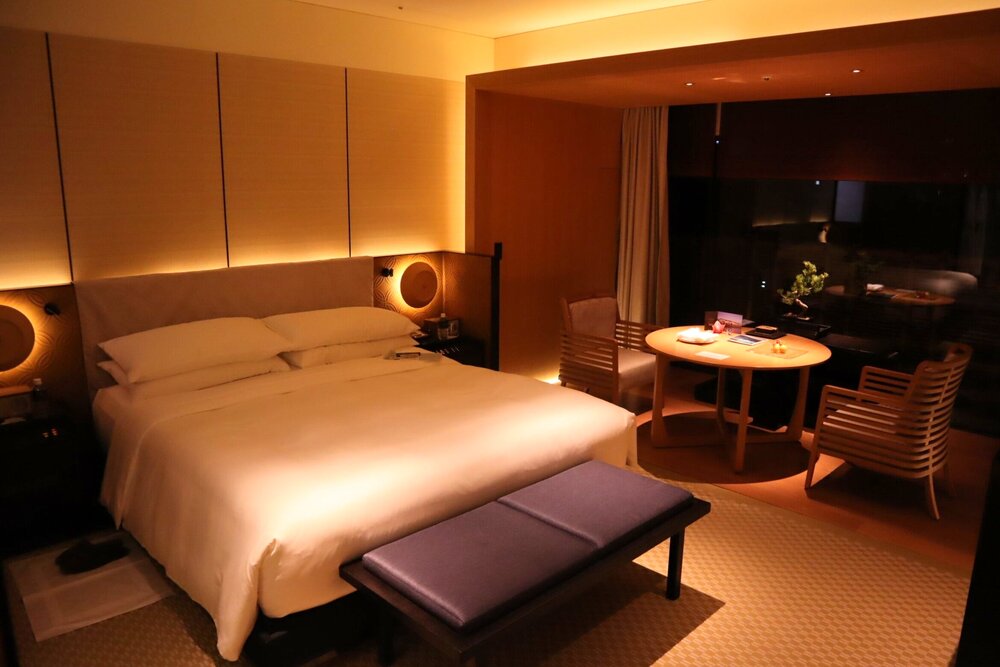
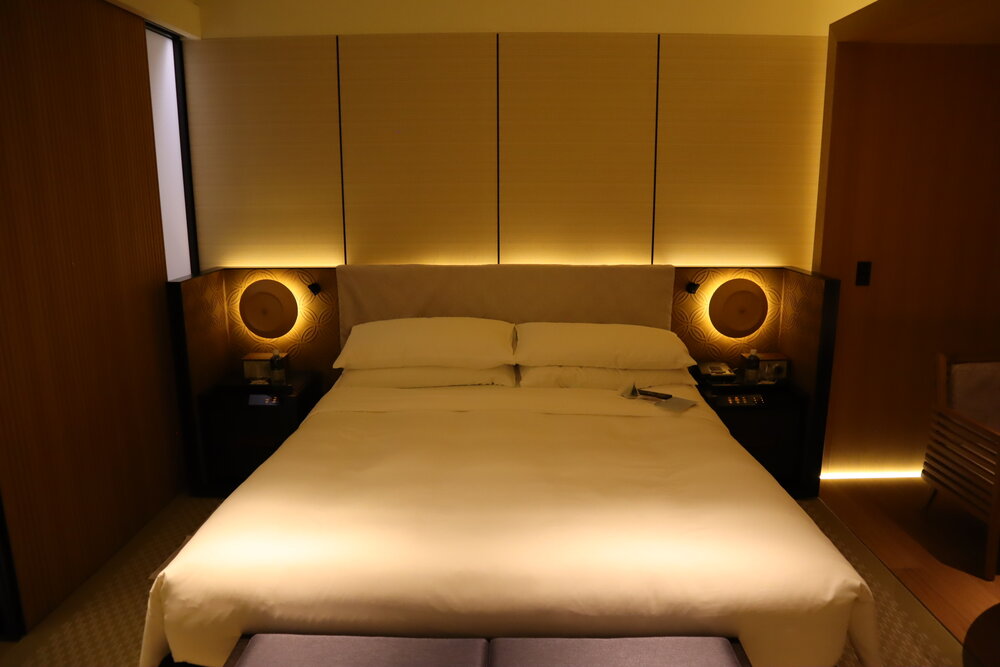
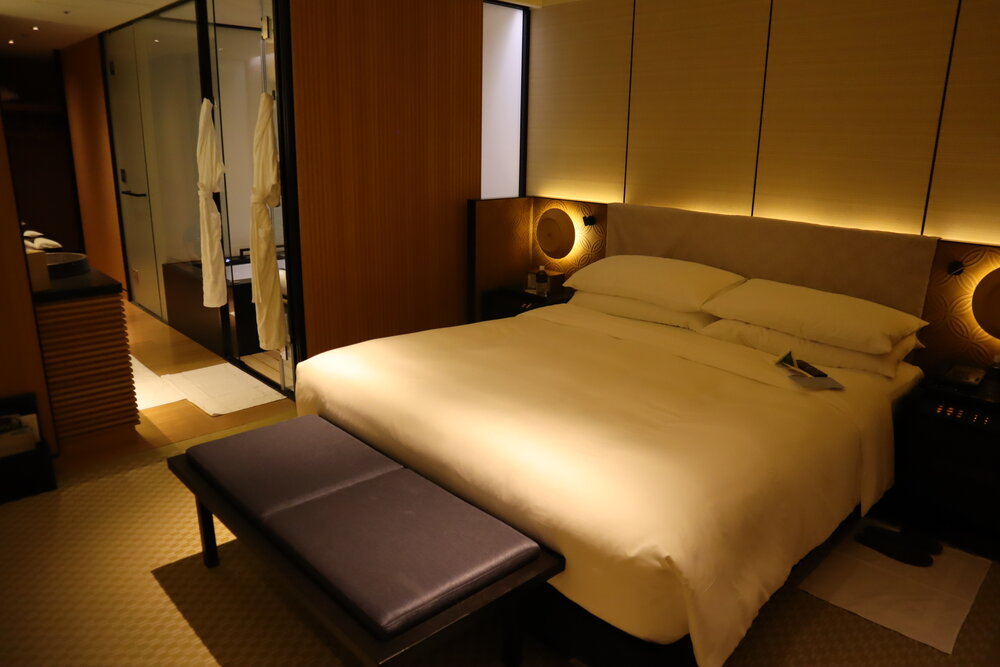
Meanwhile, the sitting area consisted of two chairs and a table, facing across from the room’s television, and flanked by a small chest-of-drawers with my very favourite feature of the room on top: a delightful little bonsai tree to finish off the room’s tasteful décor and tie it all together with an additional touch of zen.
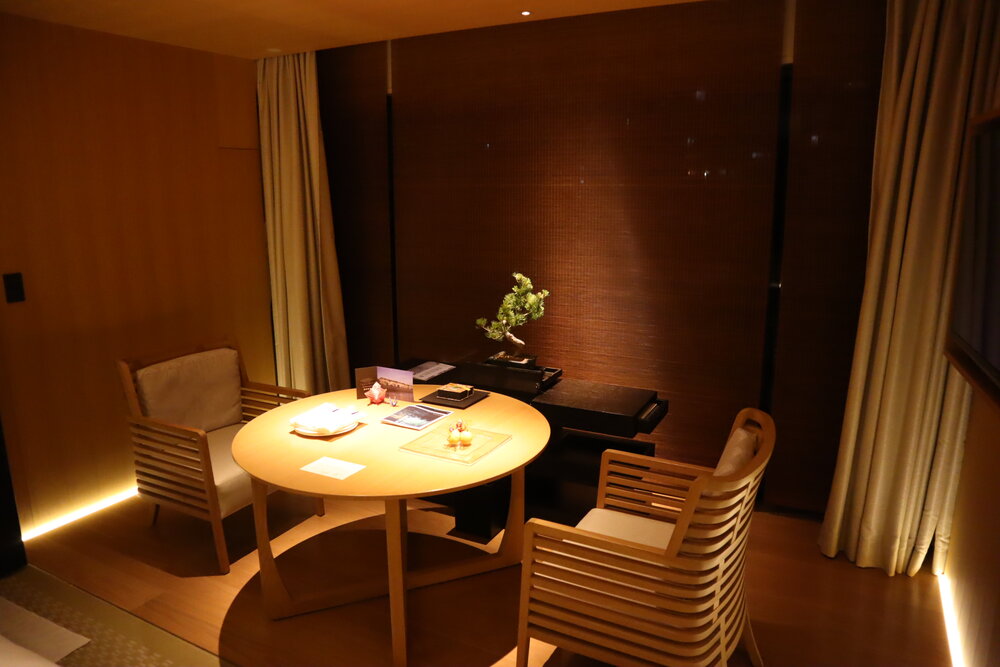
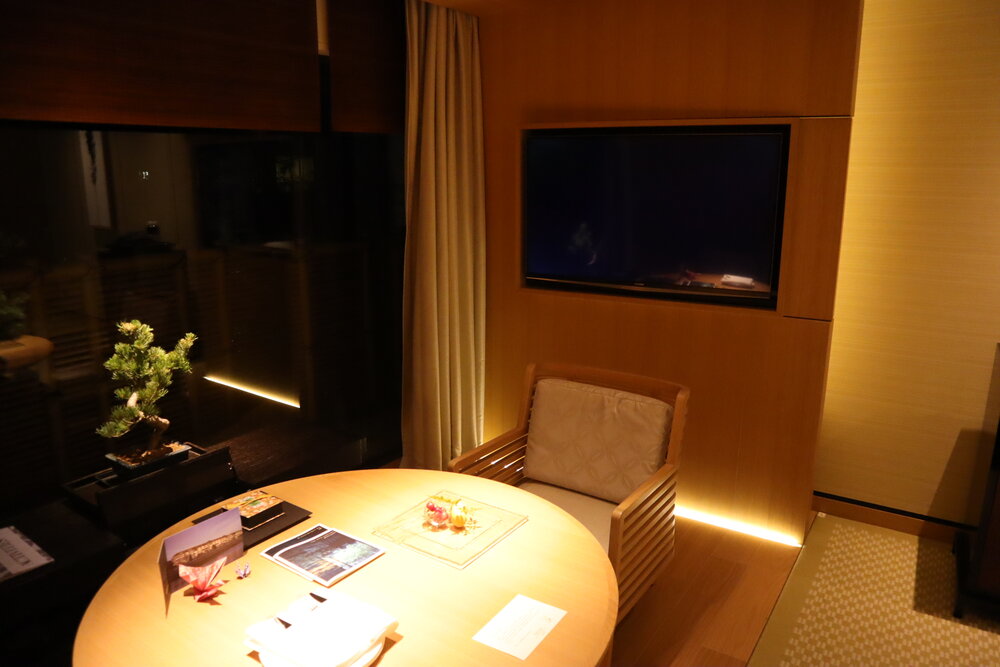
A small fruit plate had been left on the table as our welcome amenity, along with some origami cranes for decoration and a snack box with a few morsels and bites inside, which was replenished every day.

The room also featured a ceremonial tea cabinet with a simple tea set that you could use if you wanted to prepare your infusion in a more old-school way compared to the Special.T machine. The Ritz-Carlton also catered very well to our needs by providing ample bottled water in the room, and leaving us even more bottles on subsequent days after we consistently drank all of them.

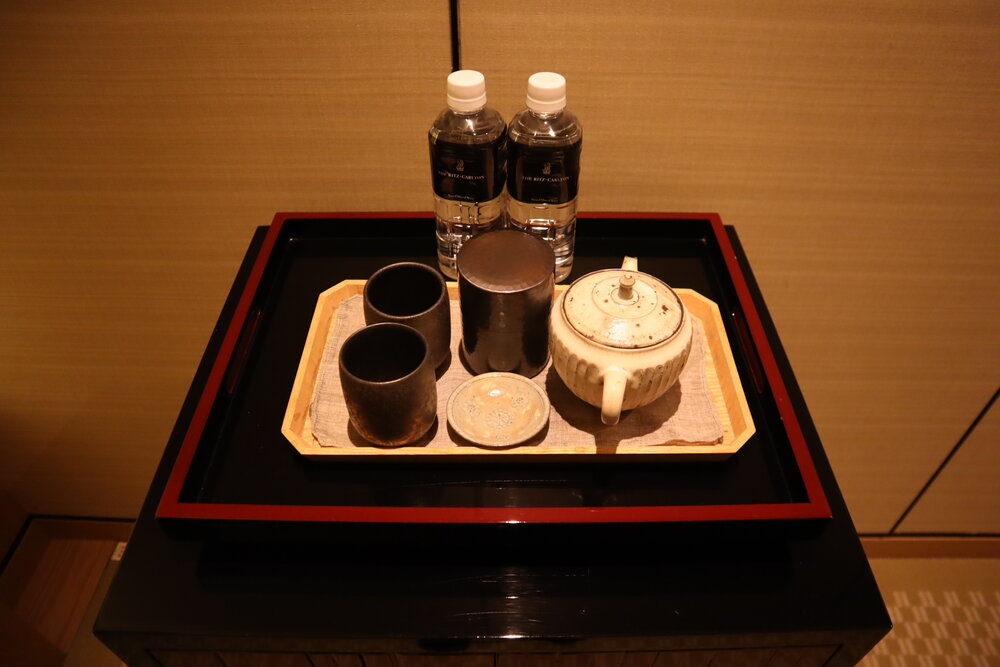
Now we’ll move on to the bathroom, which is open-concept by design, although there are a series of sliding doors to close the space off from the hallway and bedroom and create a little more privacy.
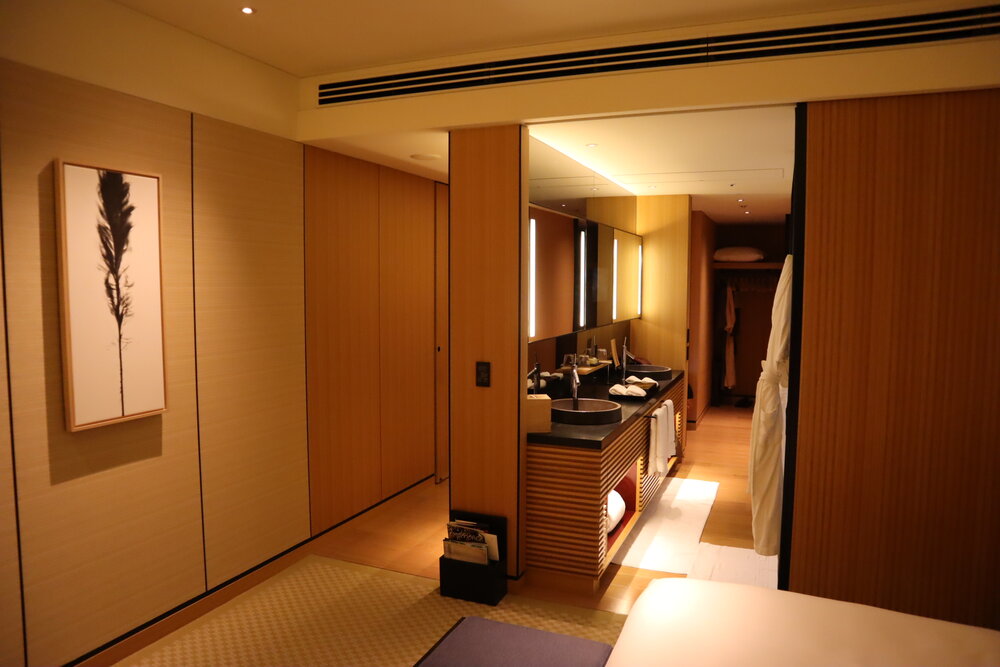
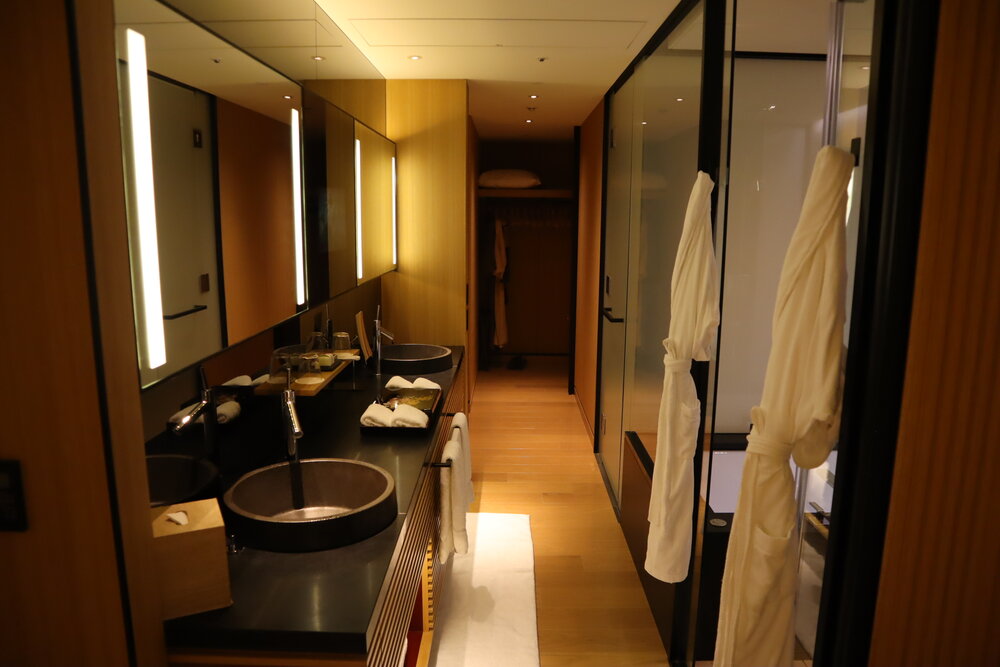
The bathroom features double sinks, each with its own mirror with LED lighting, and another television embedded within the mirrored surface that lies in-between.
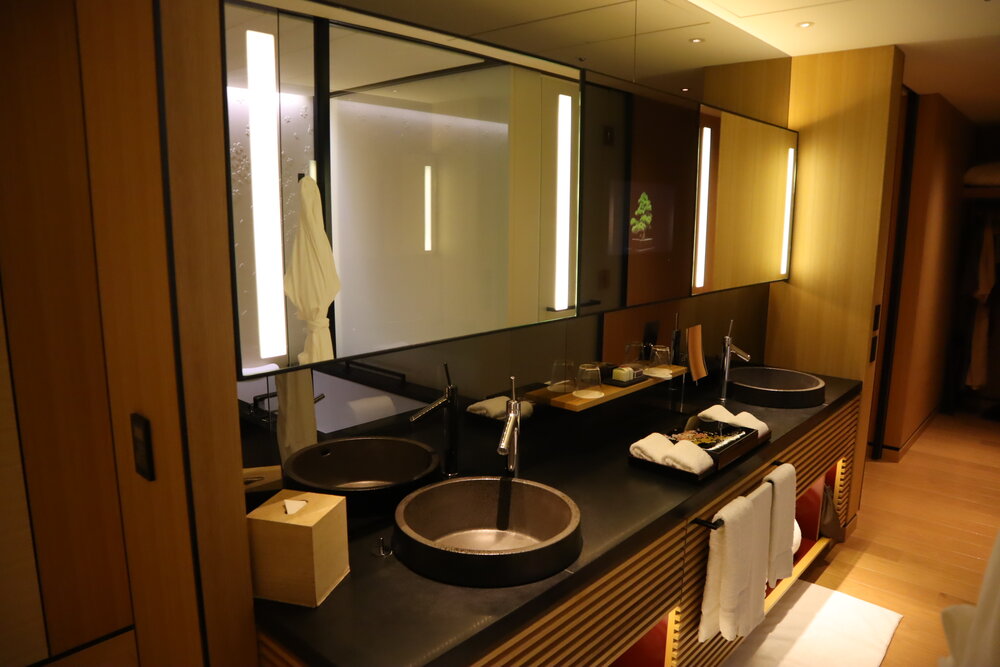
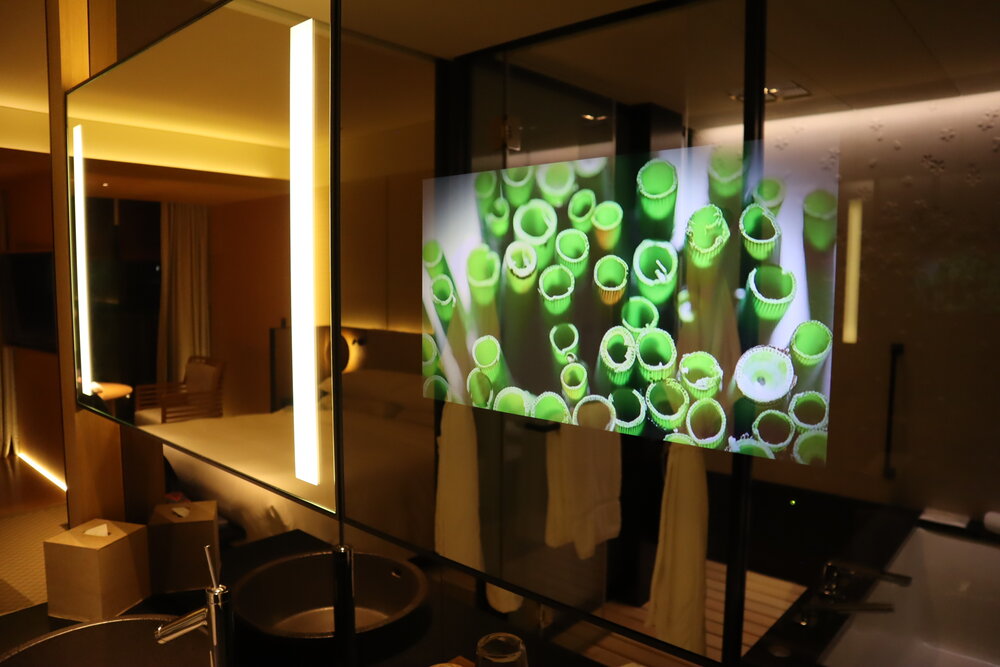
Perhaps the most exciting thing about the bathroom was the bathing area, which included both the shower and bathtub in one large “wet room”, with water from the shower draining directly through the gaps in the planks. The shower’s water pressure was also a very powerful blast – inevitably spilling water all over the bathtub as well – which made for a very satisfying shower indeed when we arrived after a long journey across the Pacific.
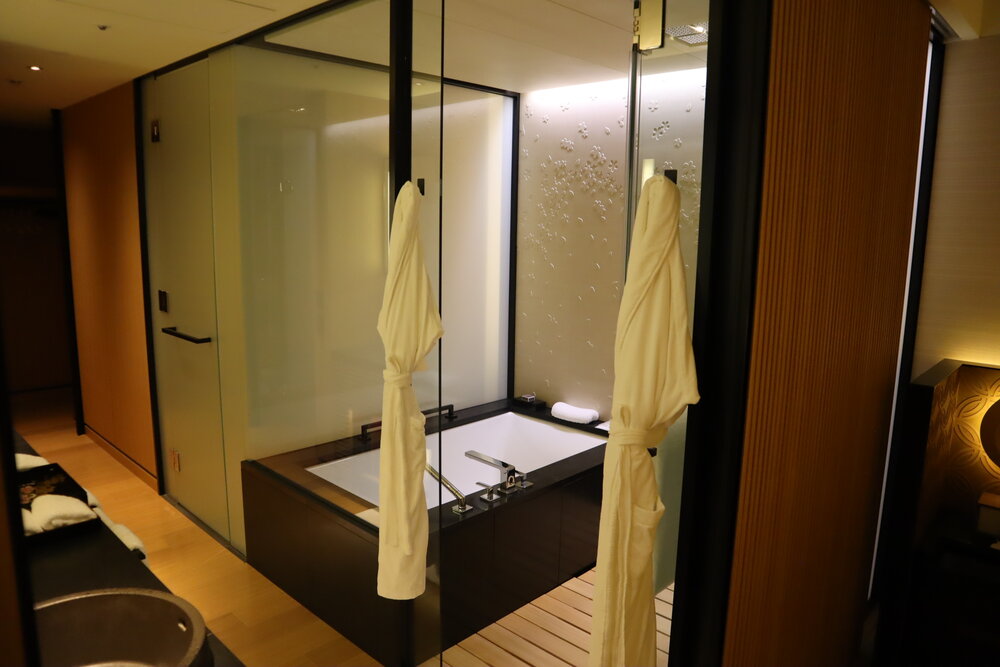
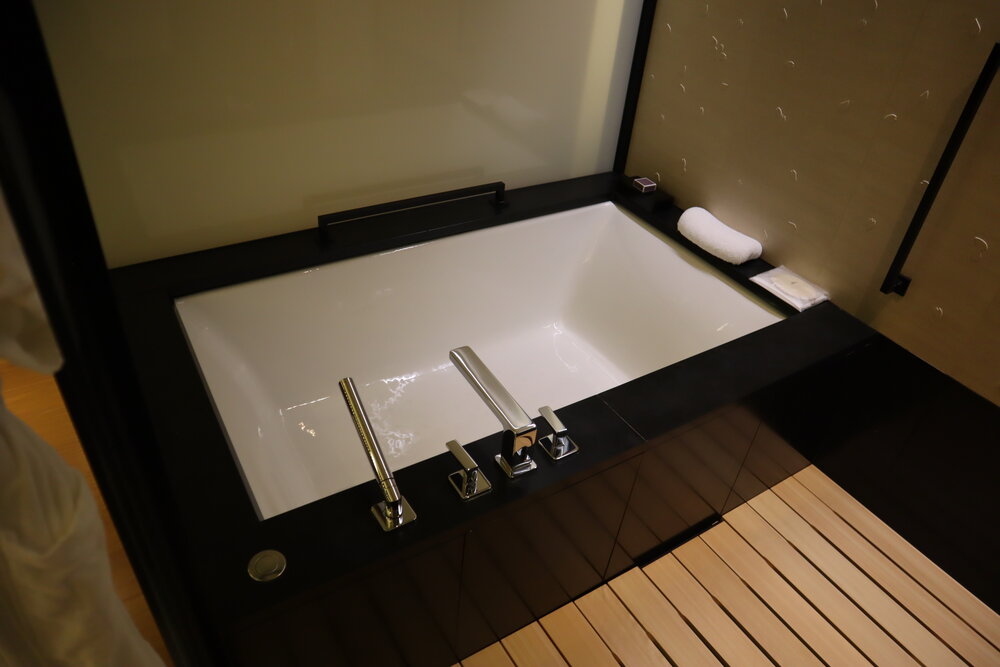
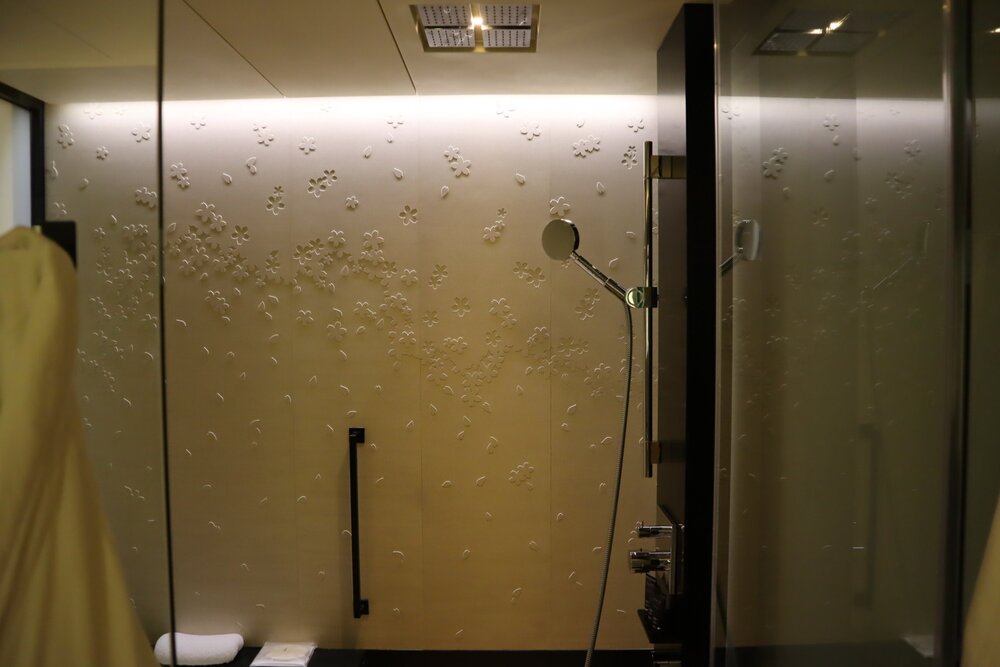
Then there’s a separate room for the smart Japanese toilet.
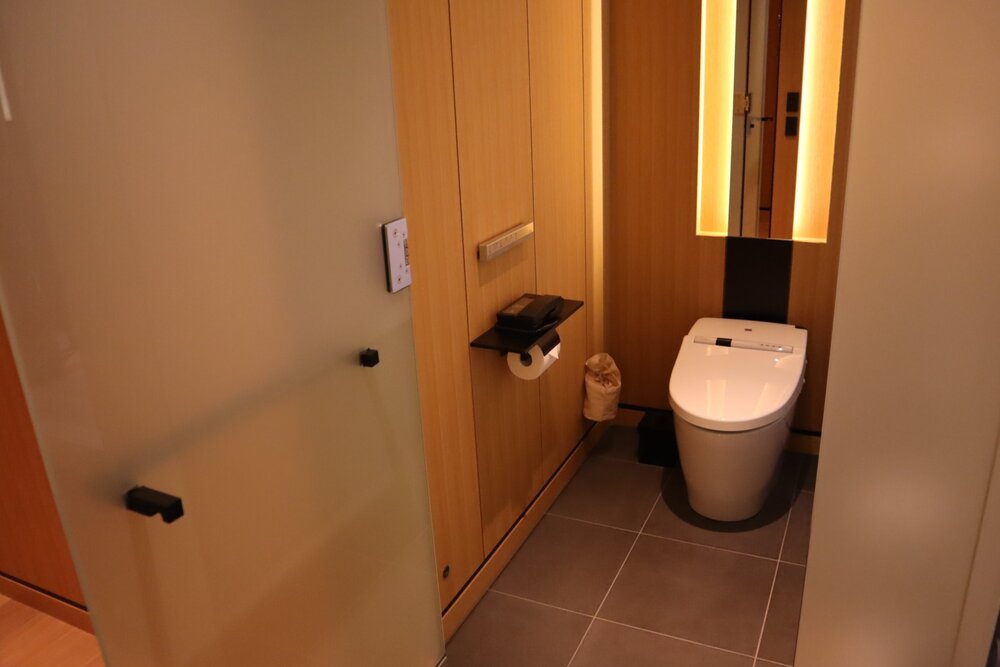
At the very back of the room is a large walk-in closet, where the bellhops had proactively placed our baggage. One thing I really liked was that the Ritz-Carlton offers both the usual fluffy bathrobes for wearing right before bedtime, as well as a lighter set of yukatas (lighter, more informal versions of a kimono) for wearing casually around the room in the daytime.
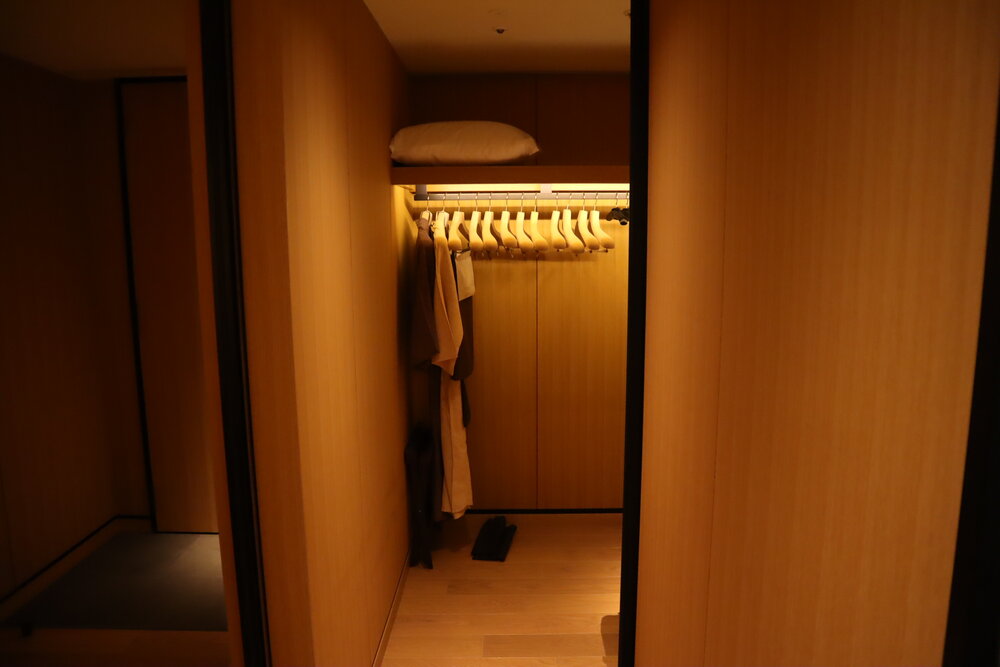
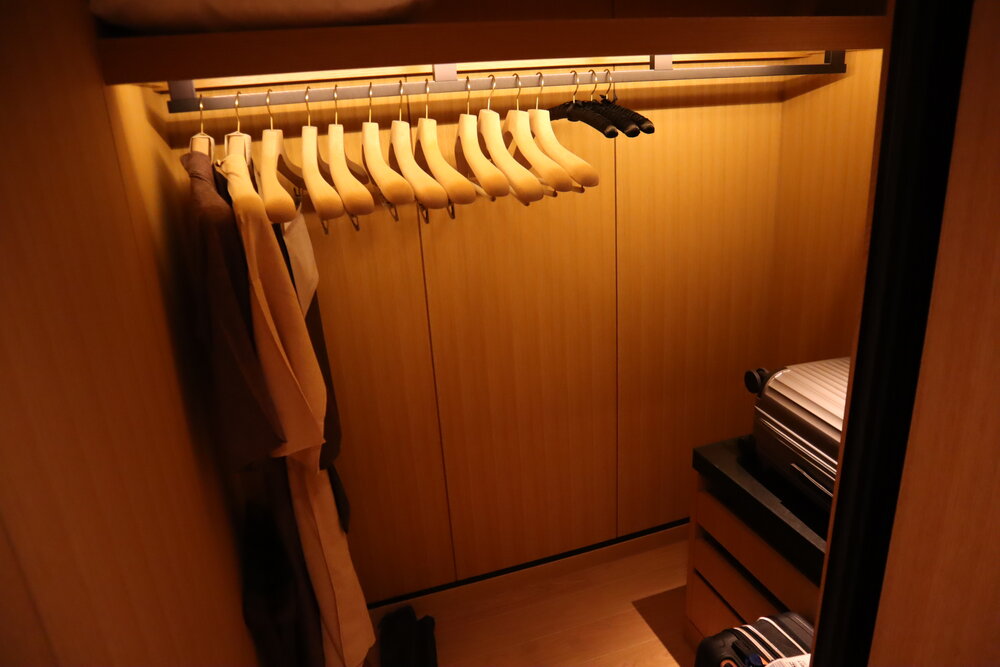
Overall, while I was of course a little disappointed not to receive a suite upgrade at a property I had been so eagerly looking forward to, I was still extremely satisfied with our Deluxe Kyoto Room, whose perfectly soothing décor – as with the rest of the hotel – made you feel wonderfully at ease whenever you were inside.
Jessy and I quickly fell into a long, deep sleep after our arrival, and we awoke at around 5:30am. We hung out for a while before heading down to our breakfast reservation at Mizuki restaurant 9:30am.
The Ritz-Carlton, Kyoto – Grand Deluxe Kamogawa River View Rooms
The Ritz-Carlton, Kyoto underwent a soft renovation in Fall 2022. All the accent fabrics and carpets in rooms were changed, and the carpeting is now a dark brown with lighter motifs throughout, as opposed to the old checkered pattern.
Since we had to book two rooms, we asked if the hotel could put us in adjoining rooms, which they were happy to do. The rooms were both from the same category, but one had a king bed and the other had two double beds.
The main part of the rooms feature a couch opposite from the bed, which has a minibar located just beside it.
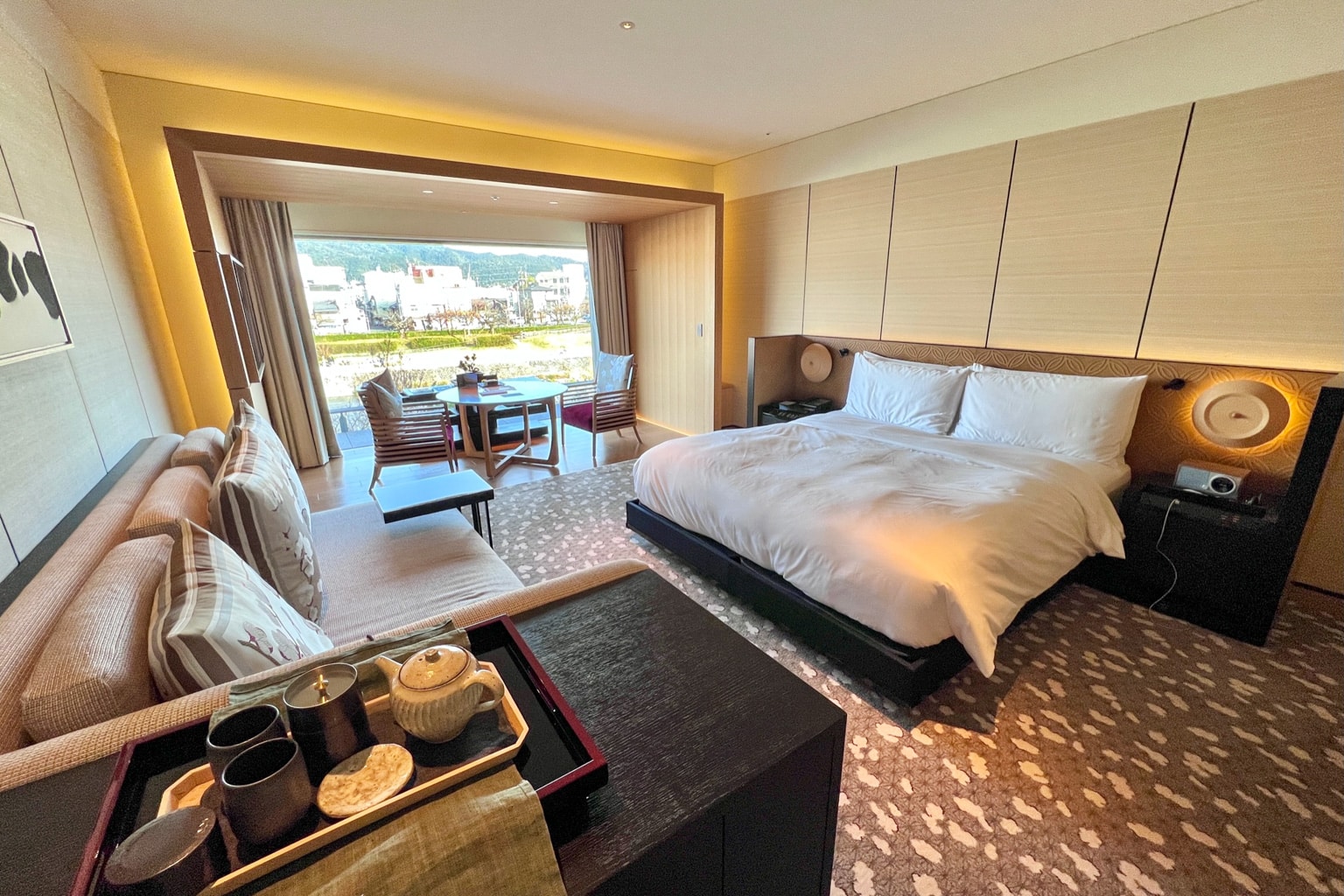
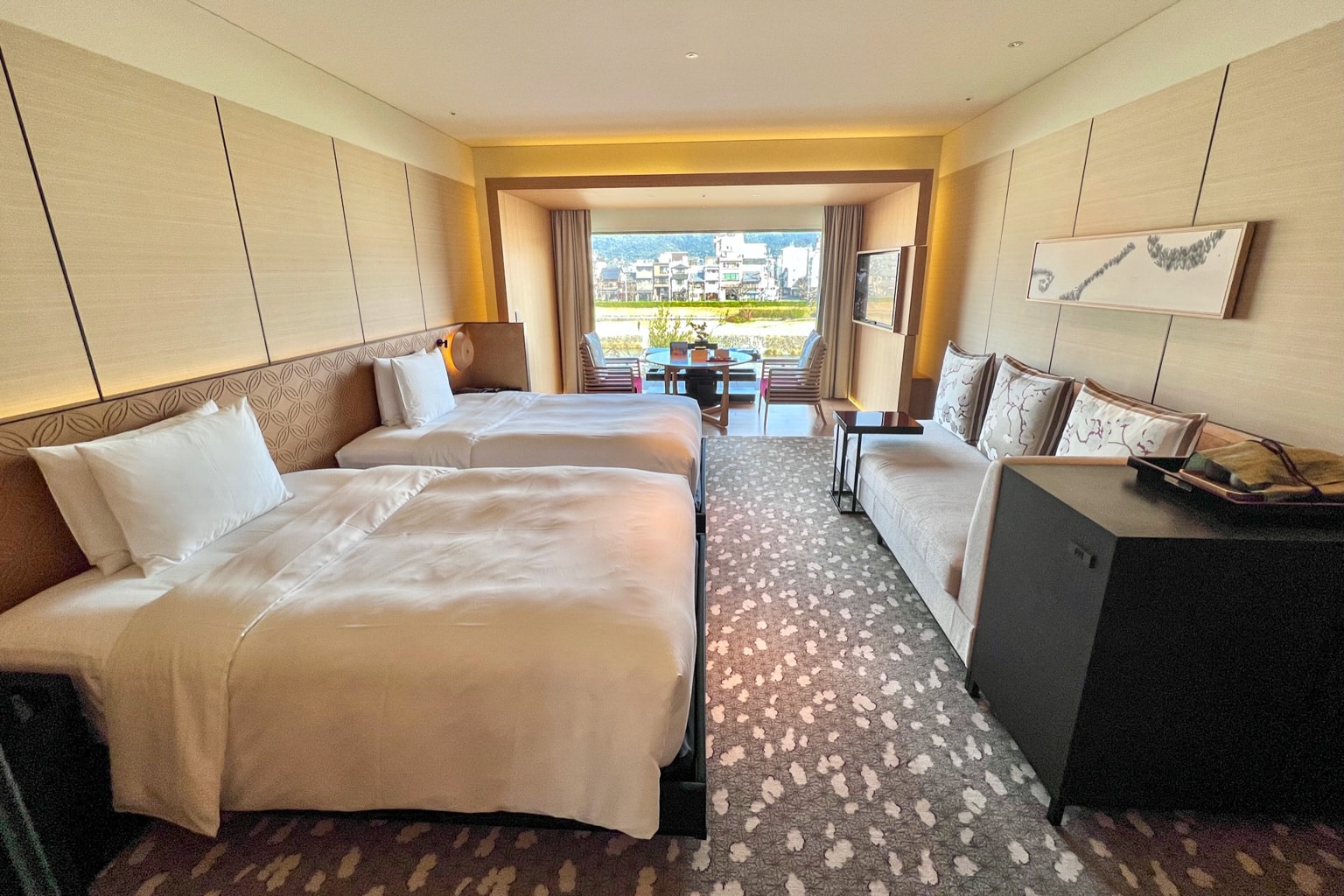
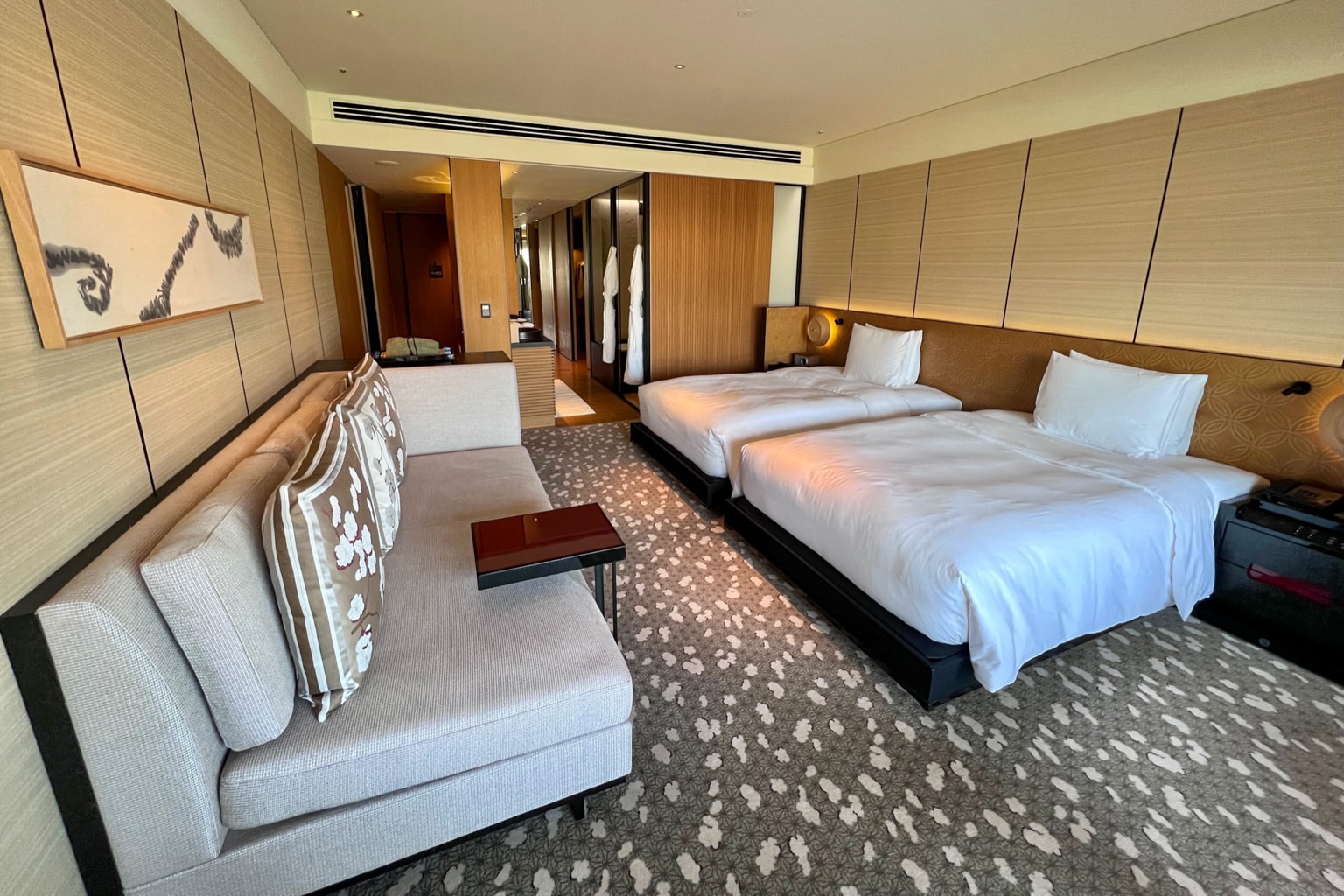
In front of the windows, both rooms feature a delightful table which overlooks the nearby river.
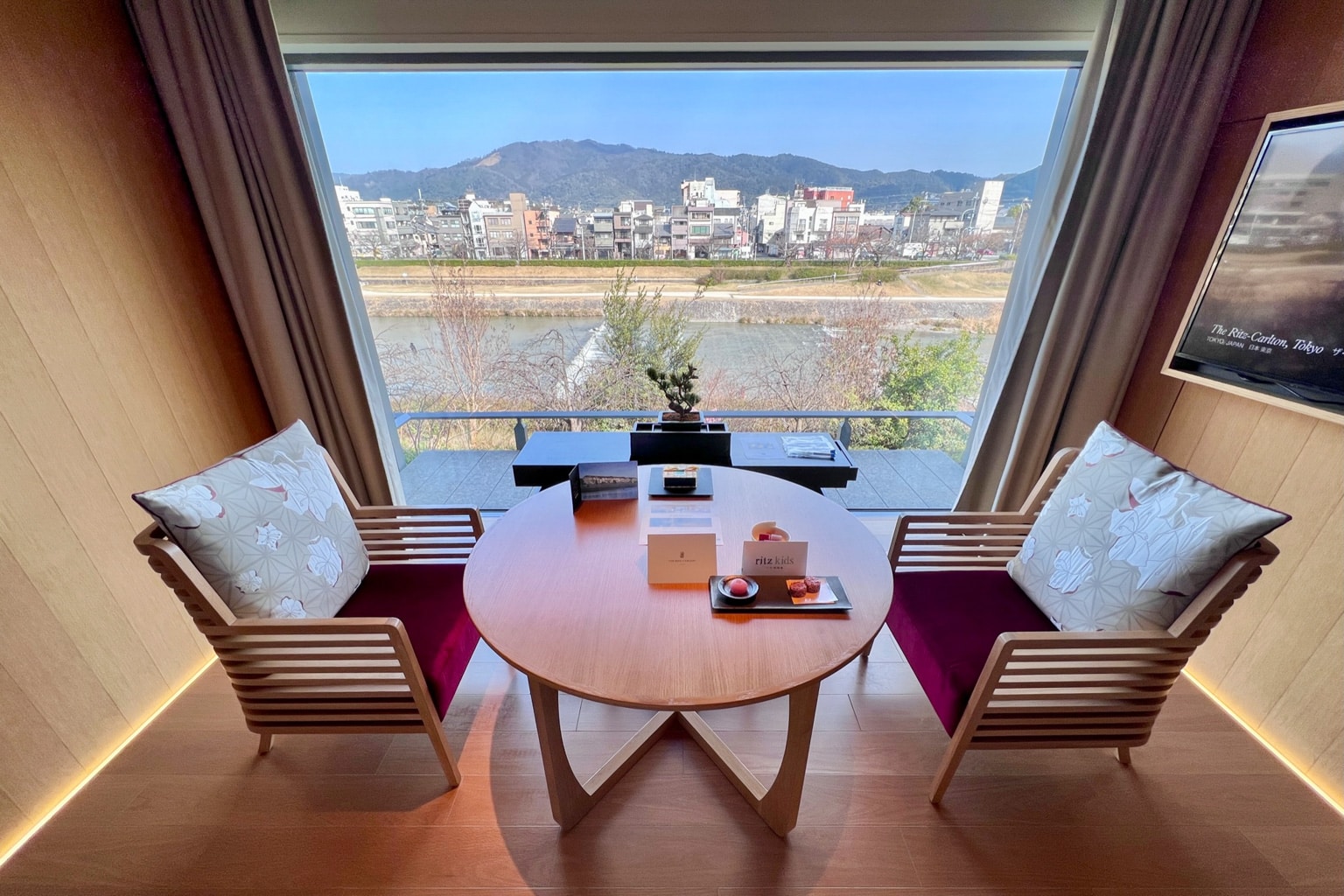
In the bathrooms, the hotel now uses refillable toiletry bottles, in line with becoming more eco-friendly.
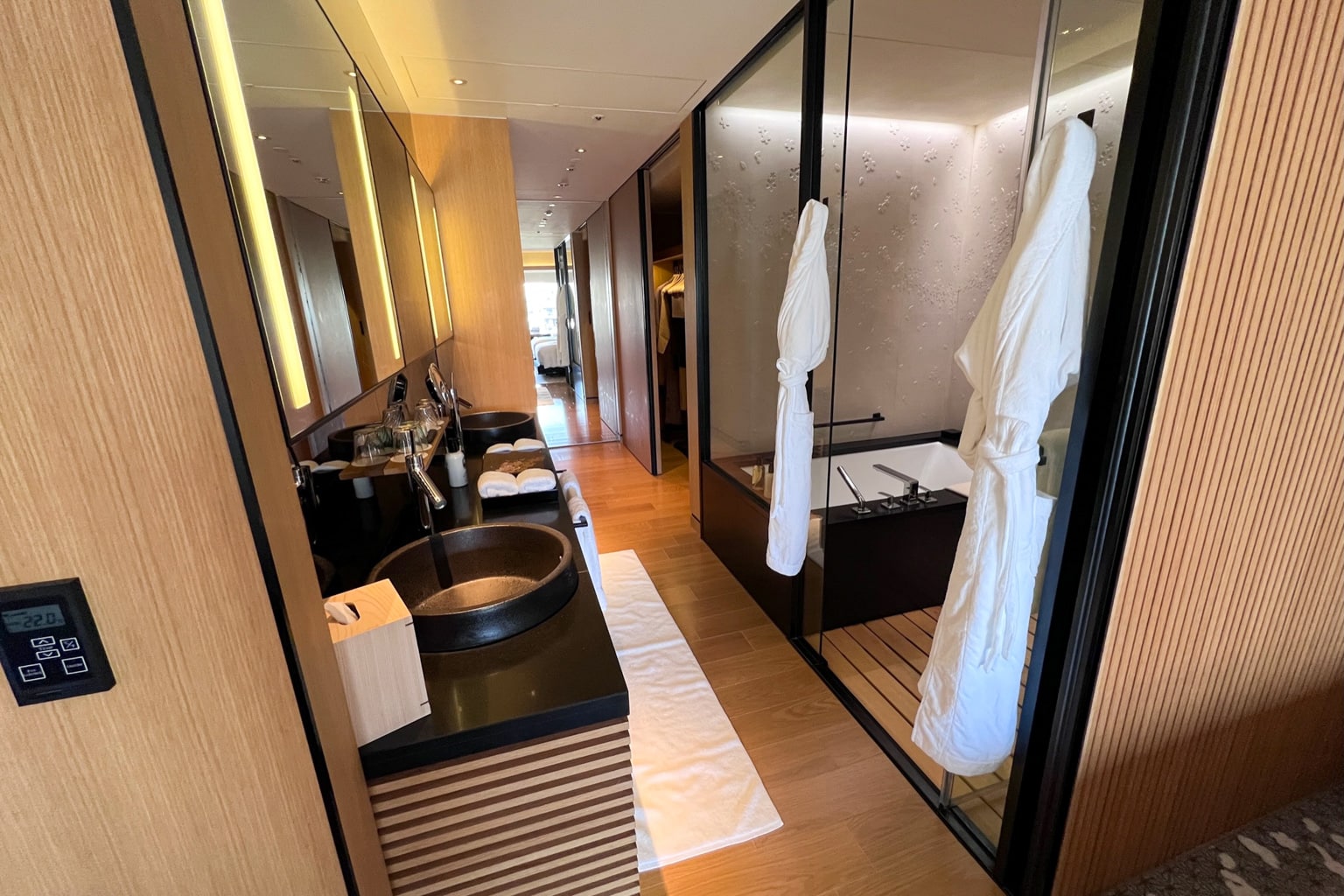
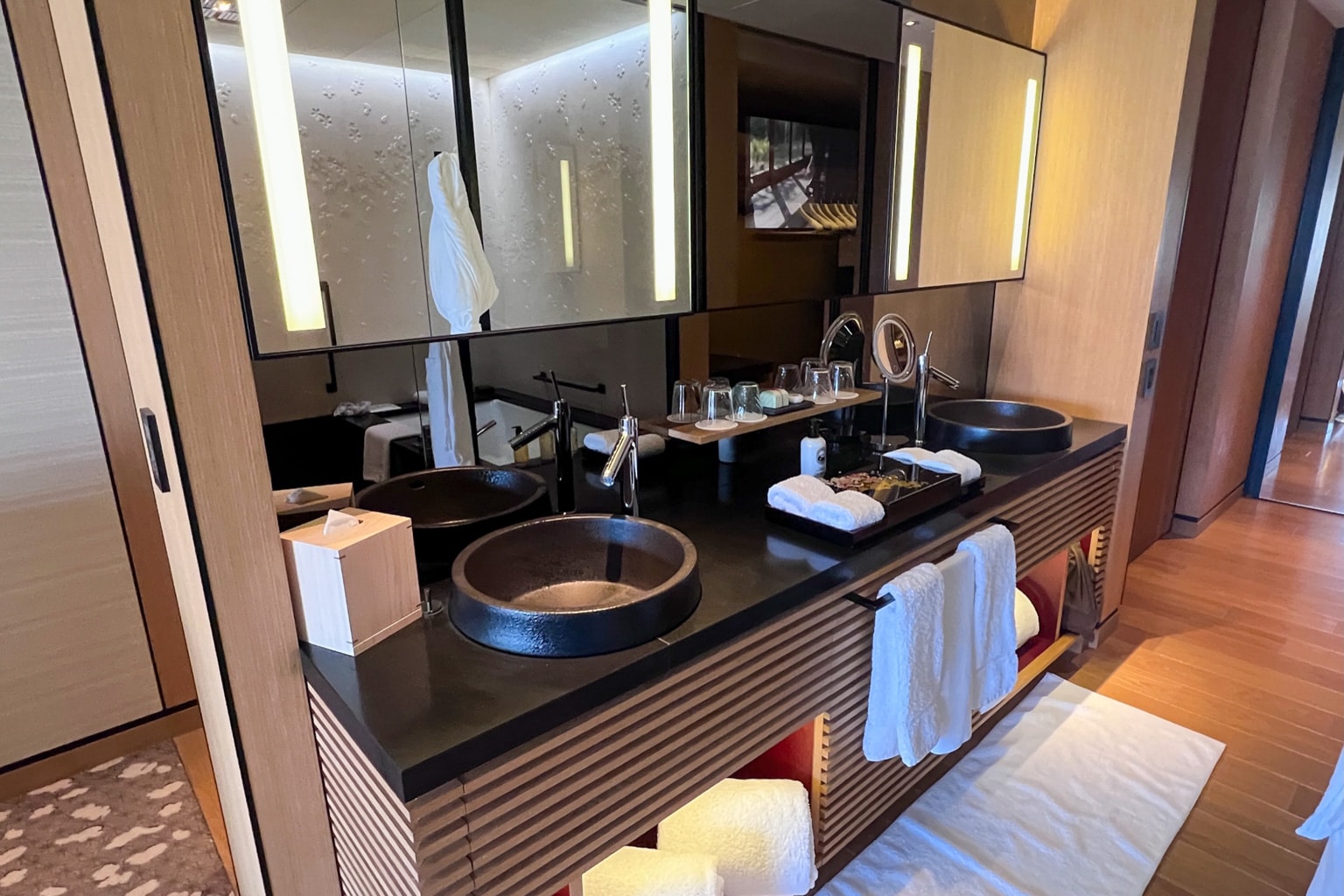
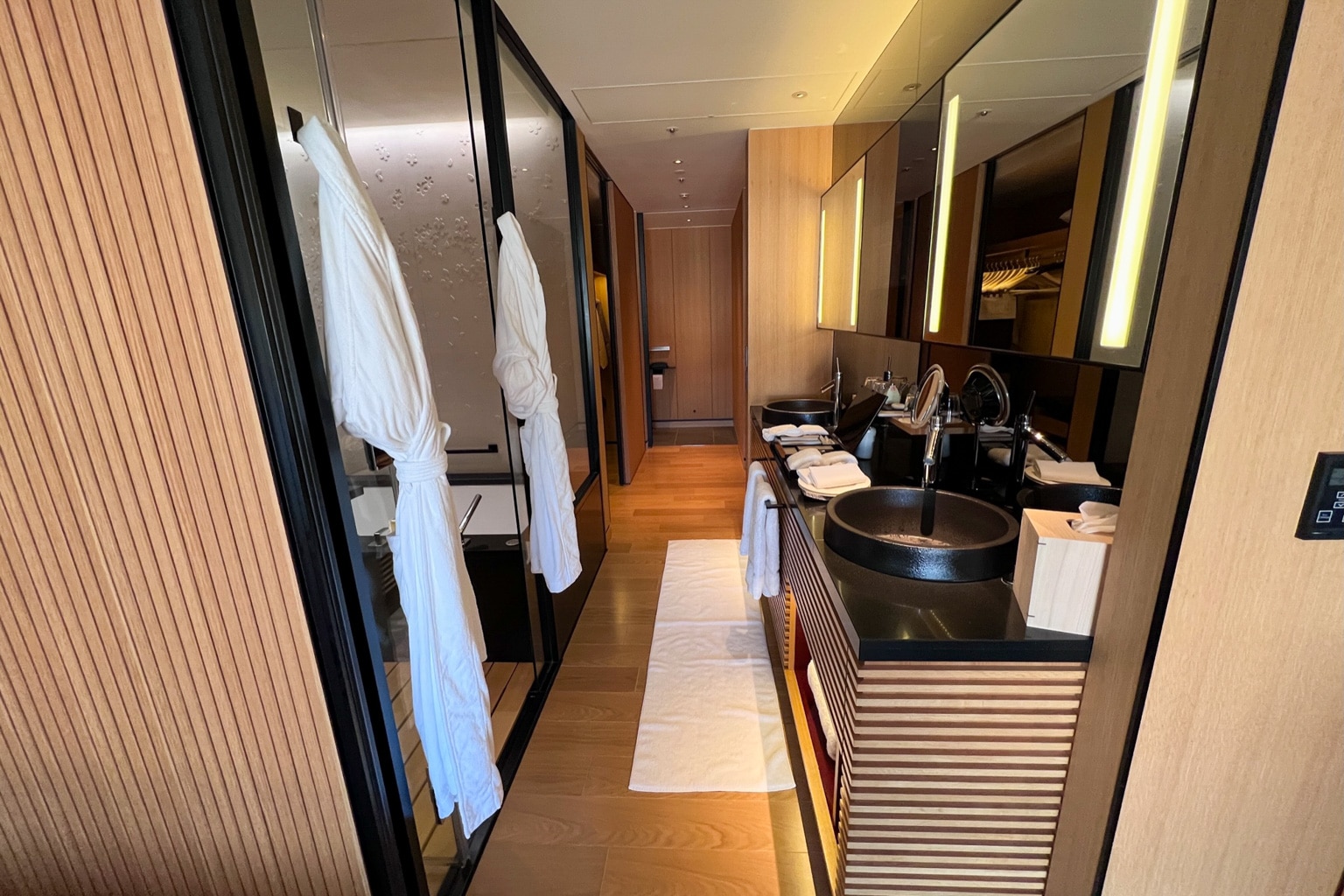
The Ritz Carlton Kyoto is a family-friendly hotel, offering several amenities and services for children.
When we made our reservation with the children, the hotel emailed us ahead of time to find out their ages. Upon arrival, our rooms had kid-sized slippers and robes for all the kids.
They also had special bathroom amenities, including children’s toothbrushes and puppy-shaped sponges for bathing.
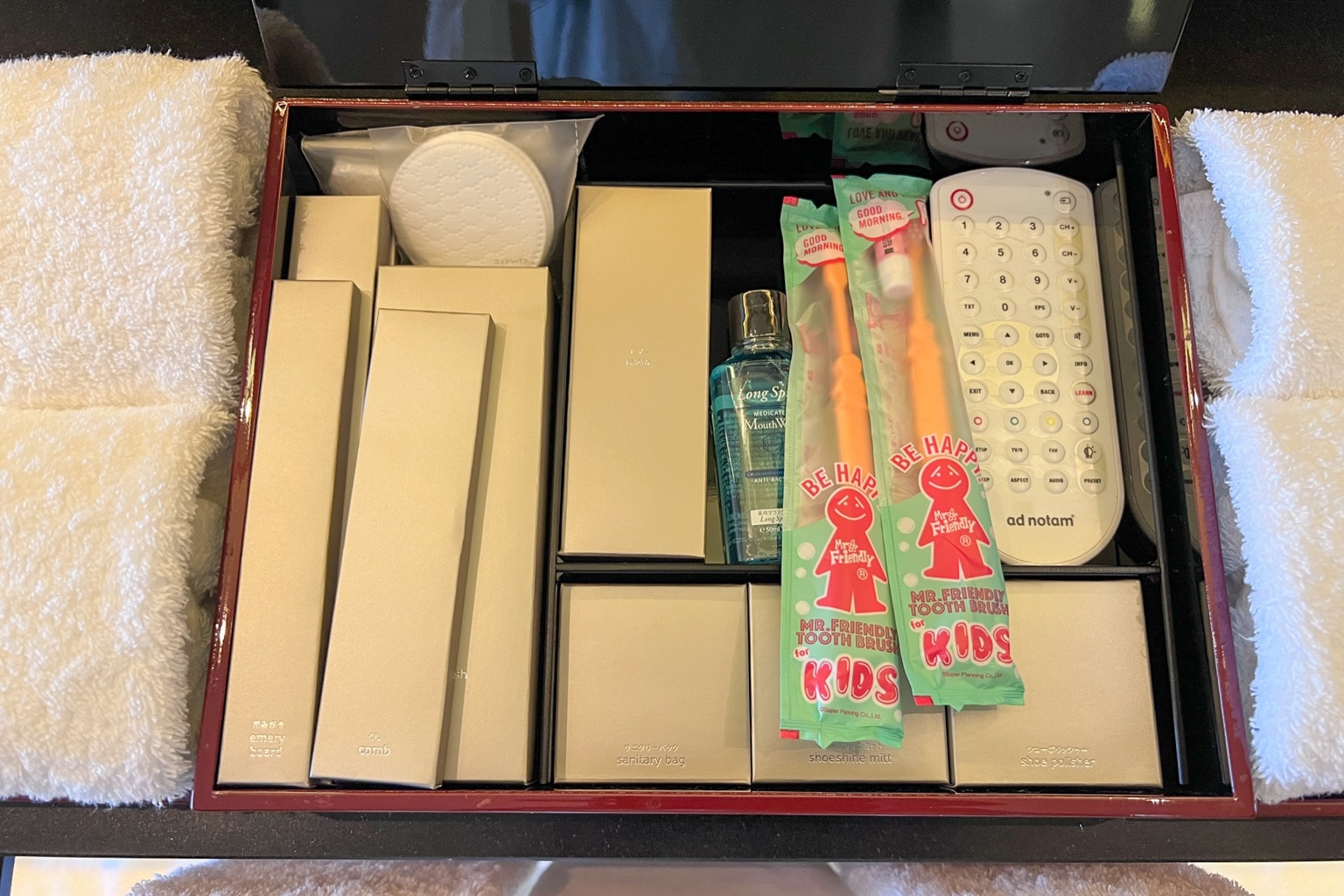
These touches were really appreciated, especially since we had to book two rooms to accommodate our entire family.
Overall, we found that the rooms were spacious and bright, which is not always the case in hotels within Asia. If you are a family of three or four, you can easily fit in one room; however, if you’re a family of five or more, you’ll need to book a second room, as they are quite strict in their maximum occupancy policy.
The hotel offers a variety of connecting room options, but the cost of having to book two rooms may outweigh the benefit of the kid-friendly amenities they offer.
The Ritz-Carlton, Kyoto – Breakfast
One of the ways in which the Kyoto location truly sets itself apart from other Ritz-Carltons around the world is in offering complimentary breakfast to Marriott Bonvoy Platinum Elite members and above, which Ritz-Carlton hotels are not obligated to offer under the program’s terms and conditions.
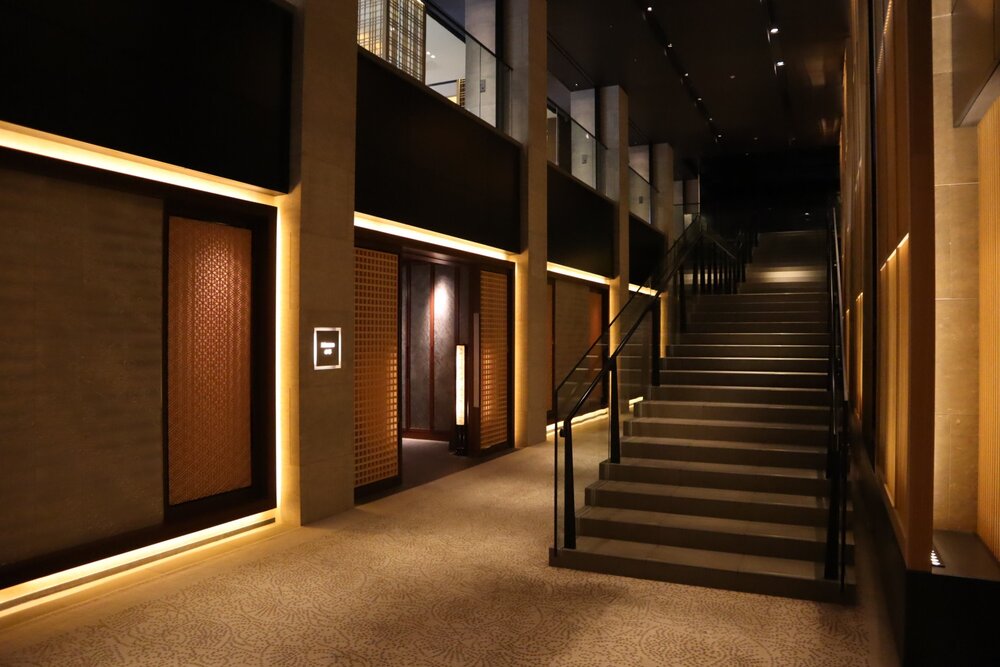
Indeed, not only are Platinum members and above treated to any complimentary breakfast, but they have their choice of the Japanese set breakfast in the Mizuki restaurant, the Western buffet breakfast in the La Locanda Italian restaurant, and either a Japanese or Western breakfast delivered via room service at no additional charge.
It’s crazy to me that the Ritz-Carlton, Kyoto offers one of the most generous elite breakfast offerings of any hotel I’ve stayed at, and they don’t even have to in the first place – they simply do so out of their own generosity. It’s such a simple way to stand out from their peers and leave a fantastic impression on the brand’s most loyal guests, and I can’t help but wish that more Ritz-Carltons around the world would follow suit!
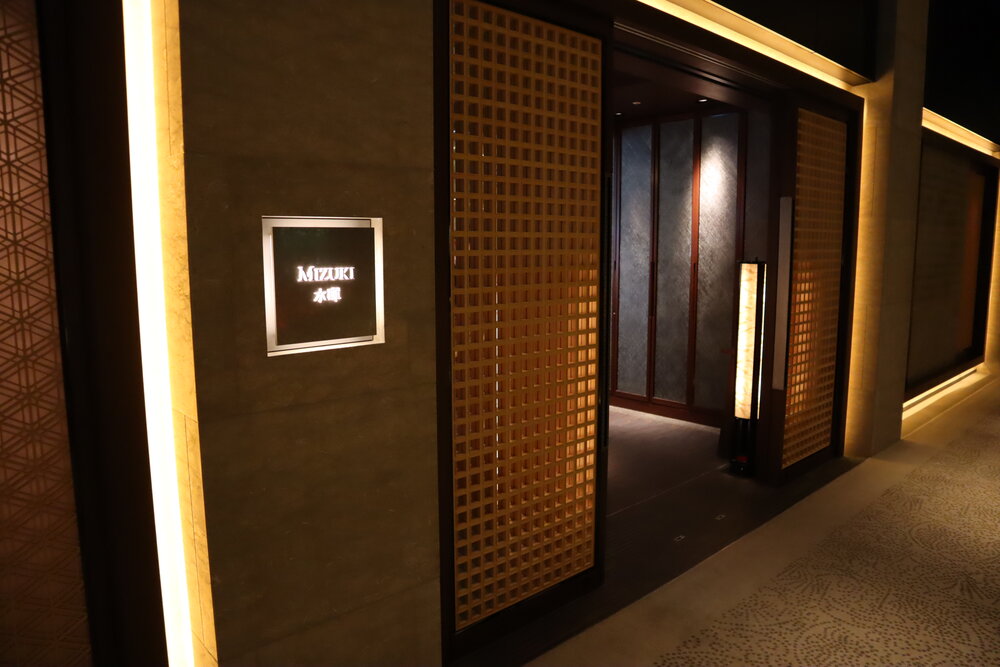
Now, since the Japanese set breakfast requires a bit of preparation time, guests are asked to make reservations in advance based on when they plan on heading down for their meal. We arranged our breakfast times with our check-in associate the previous night, having decided to enjoy the Japanese breakfast on our first two mornings, and left the third morning open.
The traditional Japanese breakfast is a highly unique ritualistic experience, and definitely made for one of the highlights of our stay.
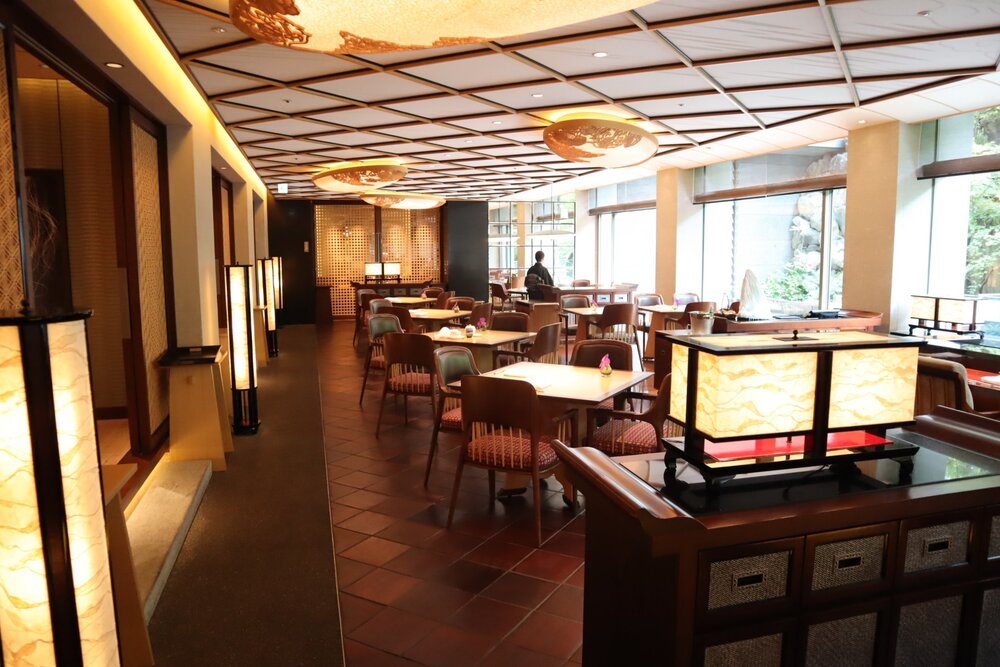
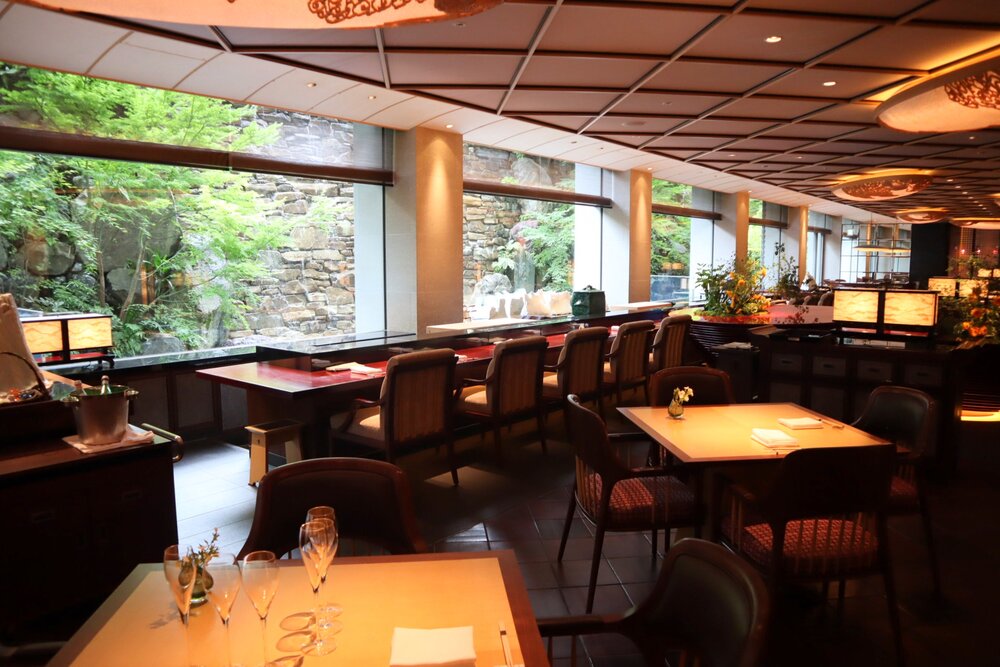
After taking your seats, servers dressed in long black yukatas will begin by pouring you some hot tea, before handing you a couple of cleansing juice shots – grape juice and apple cider on this occasion – to kick off the meal.

Next up is the warm tofu bath appetizer, which is served in an ornate wooden bath consisting of a pool of hot water, in which you’ll find a few pieces of tofu floating around. You pour yourself some soy sauce from the kettle, before using your hand-held metal net to scoop out some tofu and mix it in your sauce bowl with some condiments on the side.
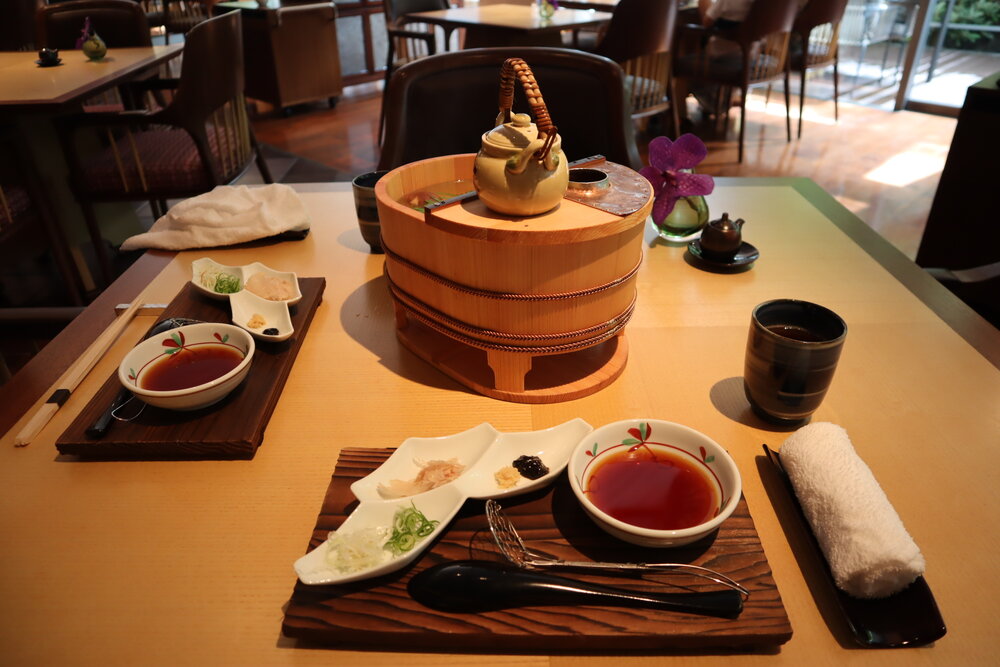
Needless to say, we were blown away by the presentation of the breakfast, and we had lots of fun fishing for the tofu every morning (even though a simple large bowl of tofu probably would’ve sufficed in practical terms).
The main course took the form of a classic Japanese breakfast bento box, which was presented delightfully in a set of colourful and purposeful dishes and ramekins, all arranged neatly in a fan-shaped tray.
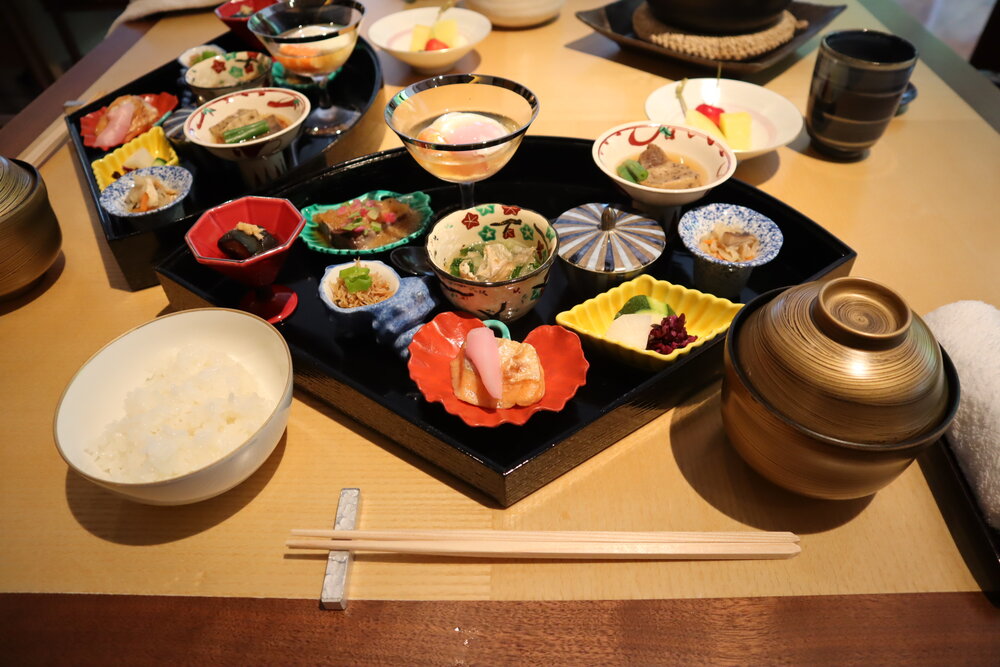
The individual morsels consisted of various creations based on fish (both cooked and raw), seafood, meat, tofu, and vegetables, and it was an incredibly satisfying breakfast experience to make my way around the tray, sampling a few bites of each portion before moving on to the next. A bowl of miso soup and some fresh Japanese rice – the slightly sticky kind, where you can virtually taste the earth on which it was grown – to bring it all together.
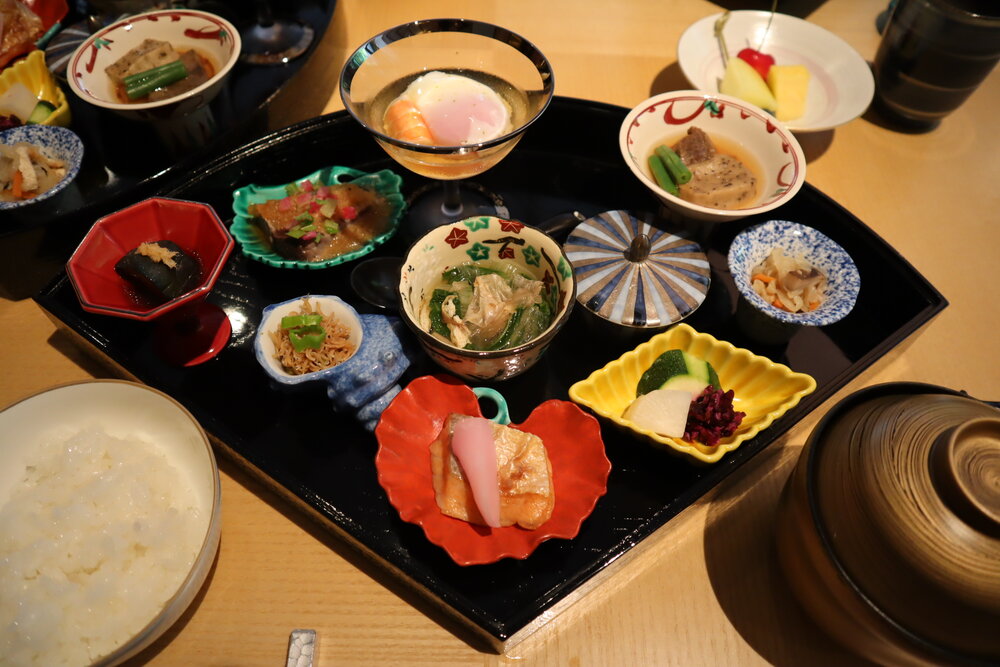

Finally, after we finished our bento boxes, we were offered some tea or coffee to finish off the meal. Unlike a western breakfast, sipping on coffee during the meal would inevitably clash against the flavours, so I would treat myself to a cappuccino afterwards to give me that jolt I needed for the day.

We returned for another round of the Japanese breakfast on the second morning. Then, on the third day, we decided that there was no point trying out the Western breakfast – after all, we could get a nice buffet spread of bacon, sausages, and eggs pretty much anywhere in the world.
Instead, we decided to order breakfast via room service, so we placed our order using the in-room breakfast card – one set of both the Western and Japanese room-service breakfasts – and put it up outside our door the night before.
Right on cue the following morning, our breakfast was delivered by way of two separate food carts, and our in-room server – a man dressed in a full suit – took about five minutes to painstakingly arrange everything on our dining table.

For the in-room Japanese breakfast, we were still treated to mostly the same courses as the Mizuki restaurant, with the exception of the juice shots (and the fact that the tofu came in a smaller warm bowl this time, rather than a full multi-storey wooden bath).
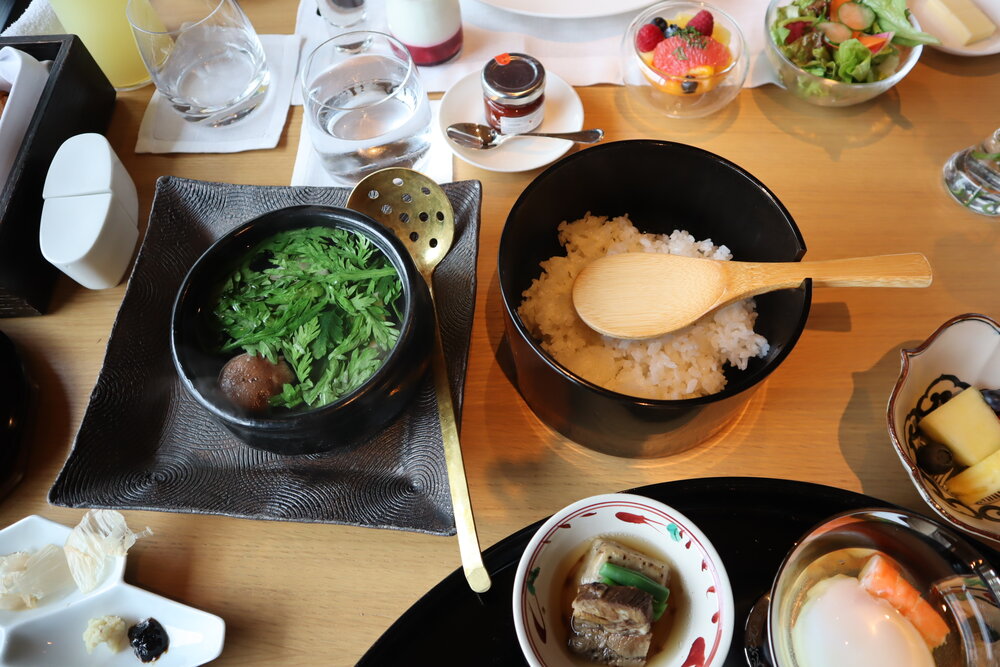
Note that the contents of the bento box changes from day to day; in keeping with the principles traditional Japanese washoku cuisine, the chefs create the spread based on the freshest ingredients available in the mornings.
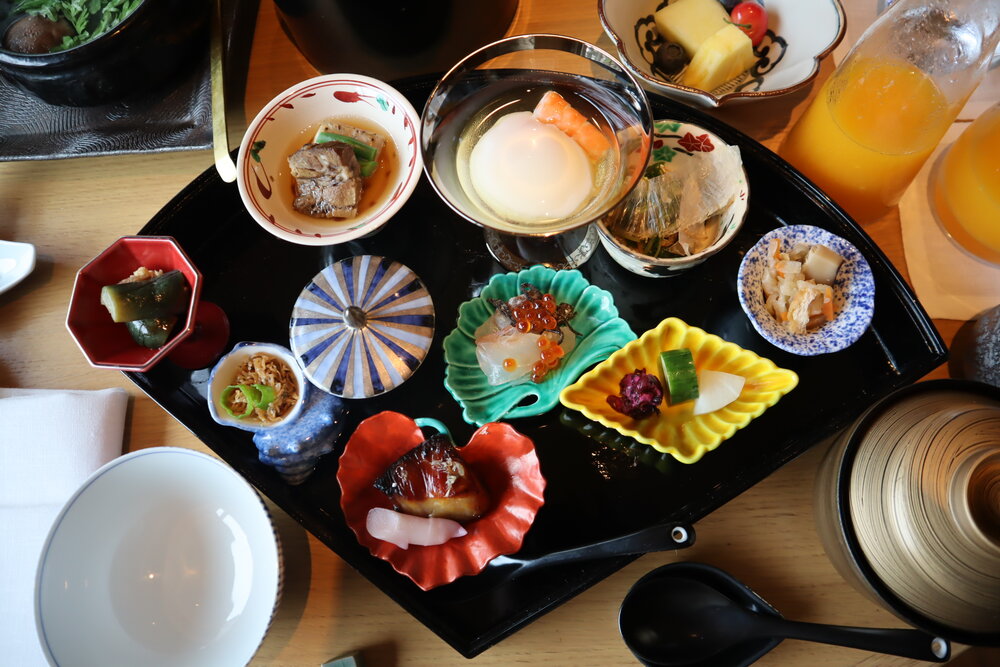
Then, for our Western in-room breakfast, we had ordered some over-easy eggs with bacon and hash browns, a salad, a fruit bowl, a glass of yogurt, and a box of Pierre Hermé pastries, including croissants, pain au chocolat, and brioche.
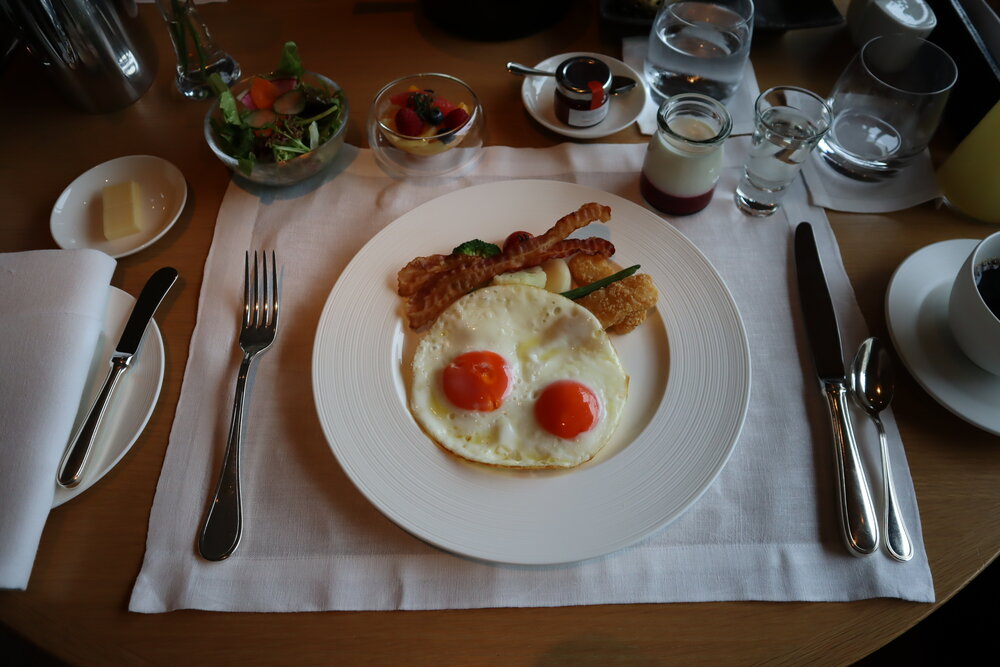
By far the most extravagant part of the breakfast was the fact that it came with an in-room toaster for the brioche, which our server dutifully helped us set up along the countertop next to the bonsai tree.
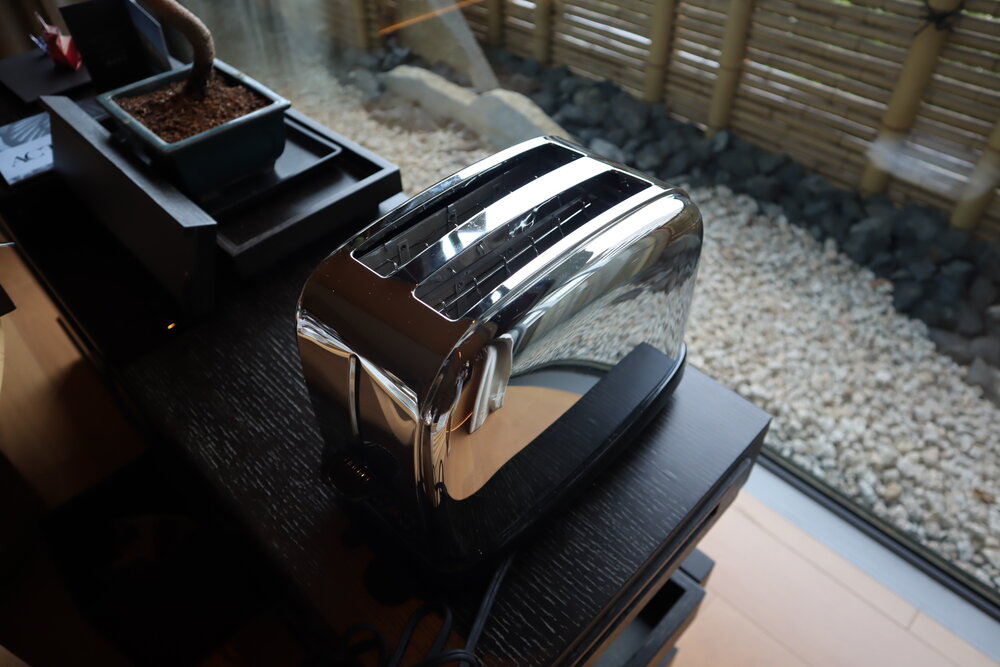
I mean, just look at this breakfast spread – I simply couldn’t believe my eyes that all this was available on a complimentary basis for elite members. I’d give full marks to the hotel for their breakfast offering, and it was easily the best thing about staying here and made me feel the most excited about wanting to return.
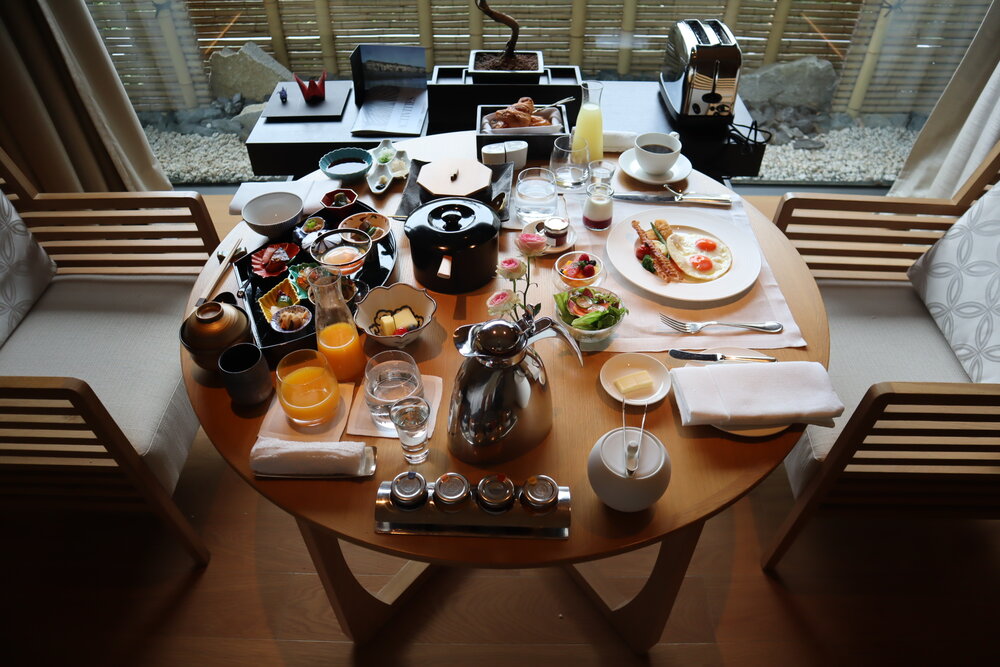
The Ritz-Carlton Kyoto is one of the very few Ritz-Carltons to include breakfast for guests, including kids. The Japanese breakfast for children included a choice of rice or congee along with miso soup, fresh fruit, tamago, the fish of the day, and a side of vegetables.
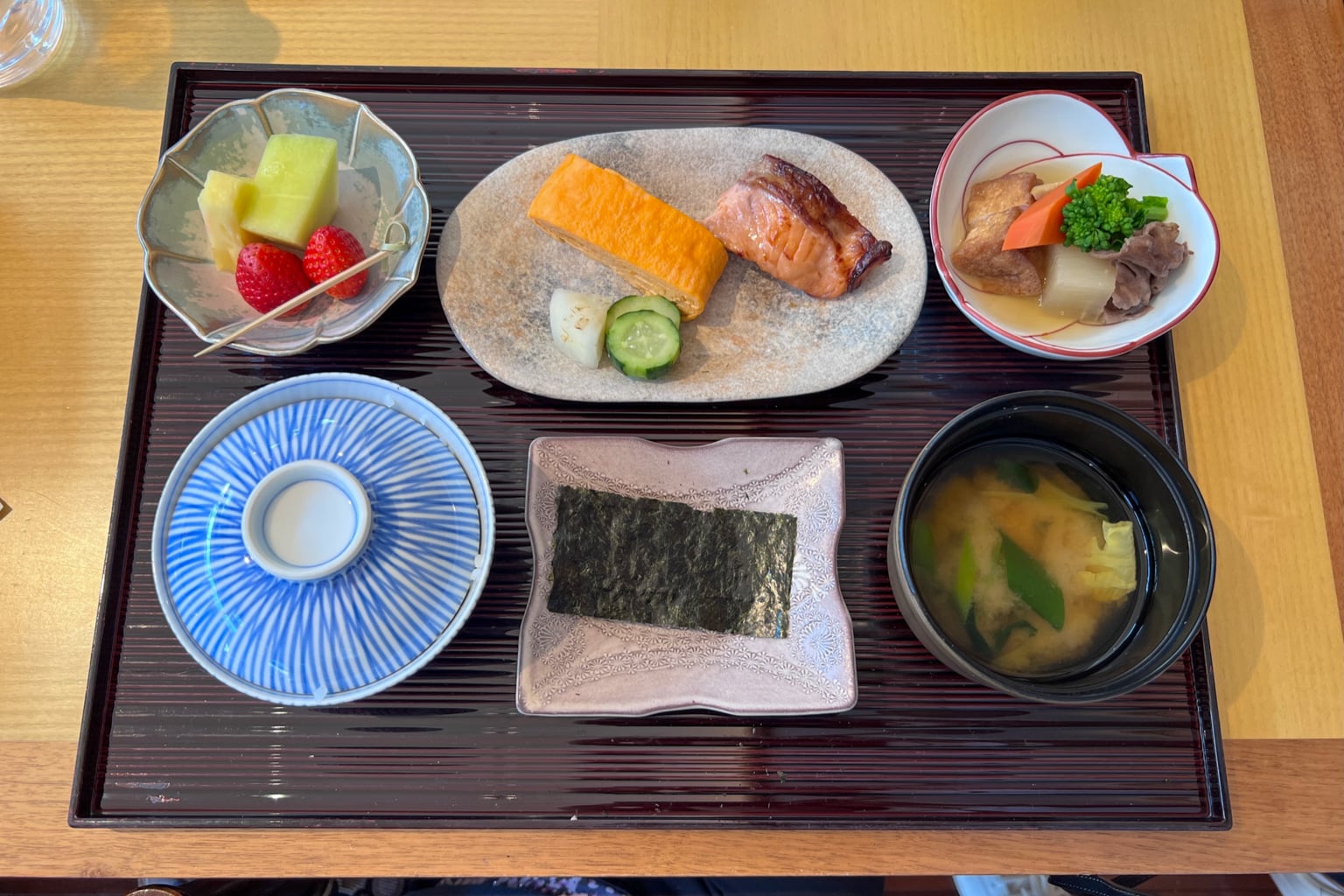
The Ritz-Carlton, Kyoto – Other Facilities
There are a few more things I’d like to point out about the hotel that make it special. First off, there’s the Pierre Hermé pastry boutique located in the lobby, where you can indulge in all of your guilty pleasures from the French patisserie.
Not only is the boutique very popular with hotel guests, but I saw many Kyoto locals dropping in to pick up macarons and sweet treats for themselves during the day as well.
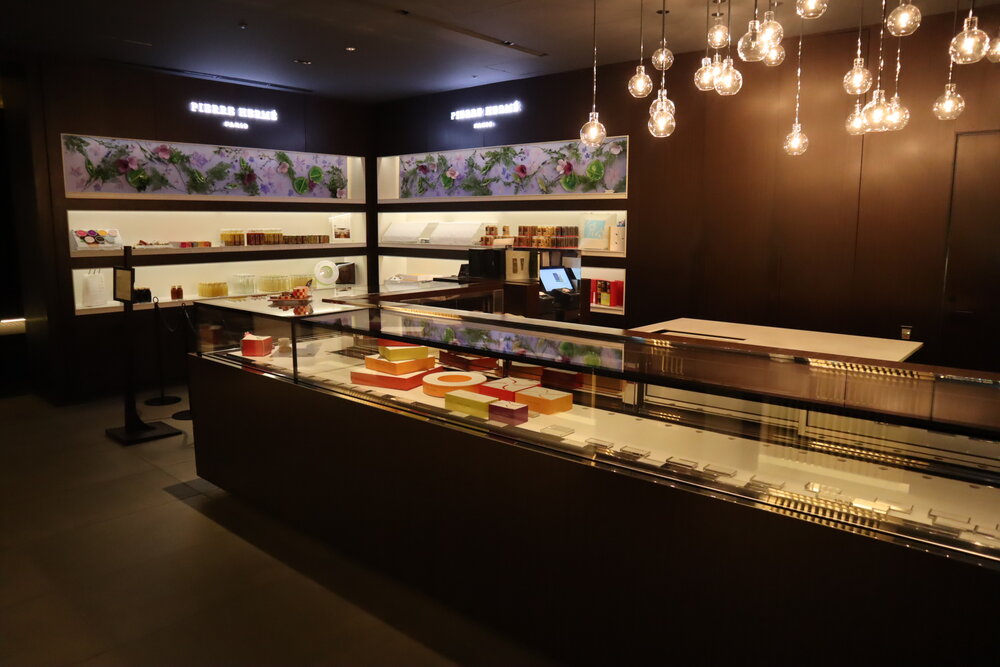
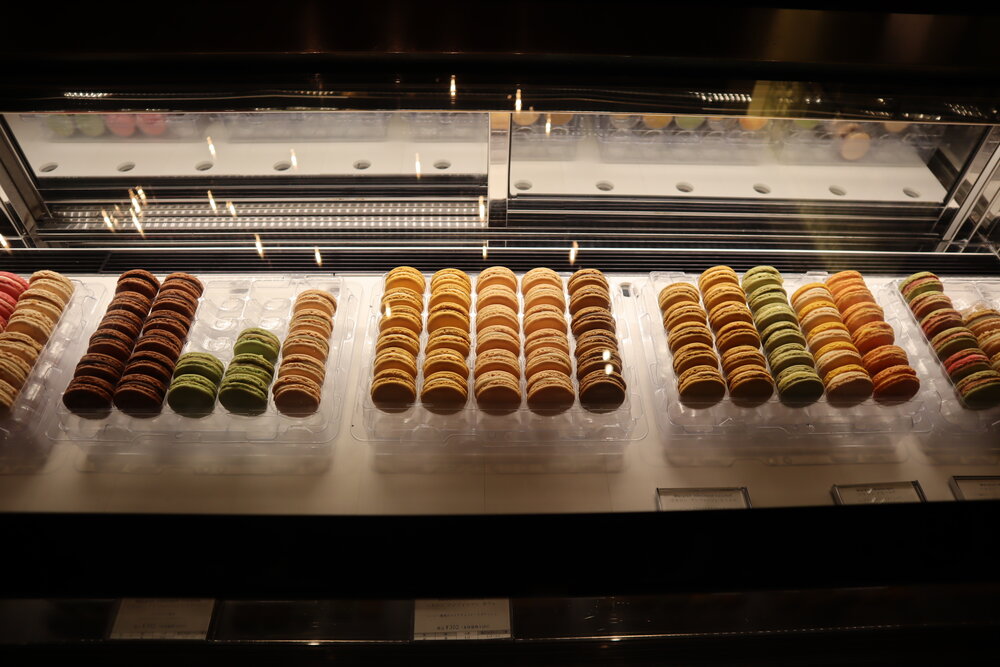
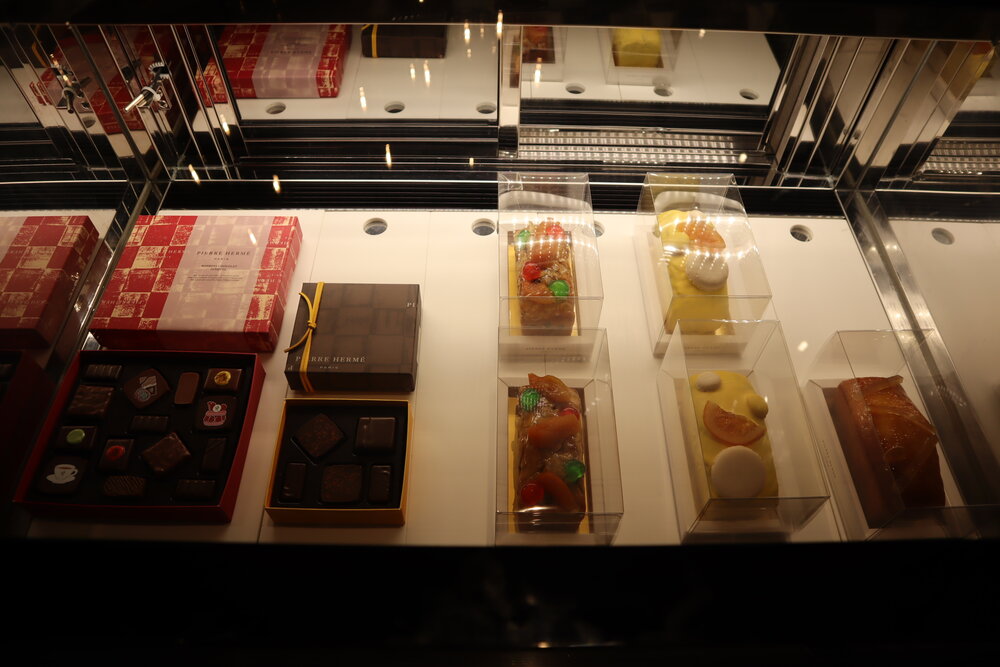
On the hotel’s lower level is the fitness centre, swimming pool, and spa facilities. I didn’t have much time to hit the gym, but I probably should have, given the sheer volume of food we were consuming during our time in Japan.
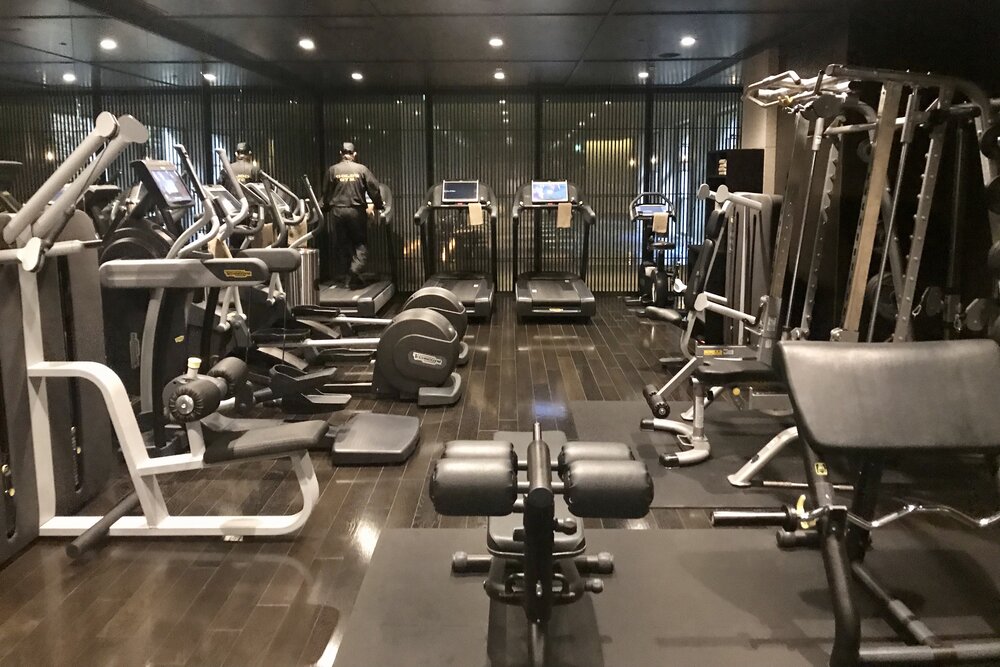
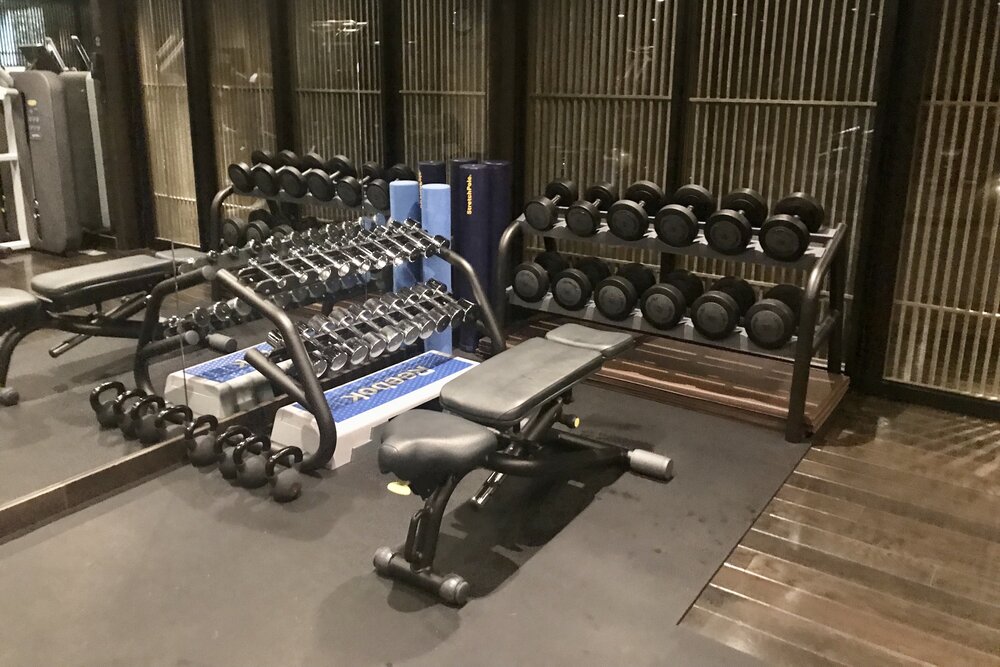
The pool looked like it would be a fun place to take a dip, especially since there’s a sauna right adjacent to it.
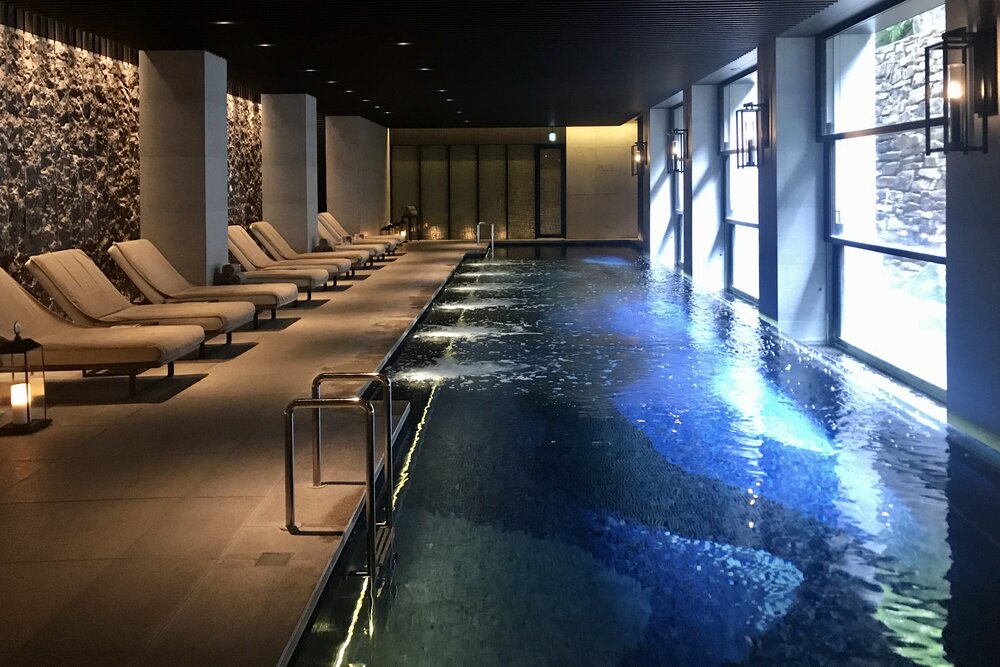
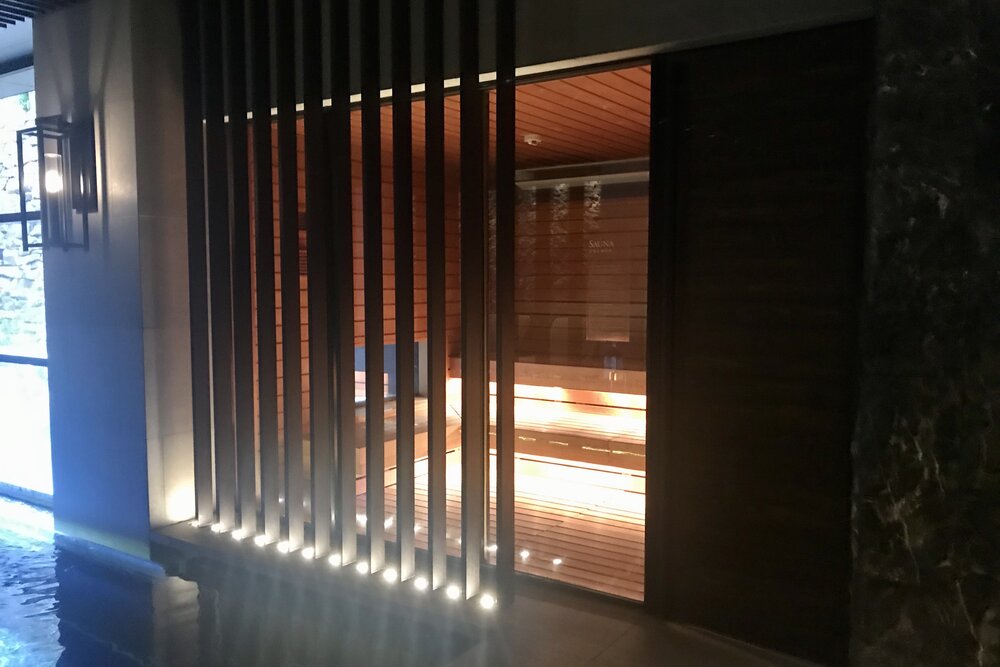
It’s worth noting that unlike many other Ritz-Carltons around the world, the Kyoto location doesn’t offer a Ritz-Carlton Club Lounge. Even if it did, though, we likely would’ve had to pay for access, and I’m not sure if we would’ve chosen to do so anyway.
Finally, even though it’s not strictly part of the hotel, one of my favourite things about staying here was the “secret” set of stone steps leading from the back of the hotel across the gentle Kamo River that flows past the property.
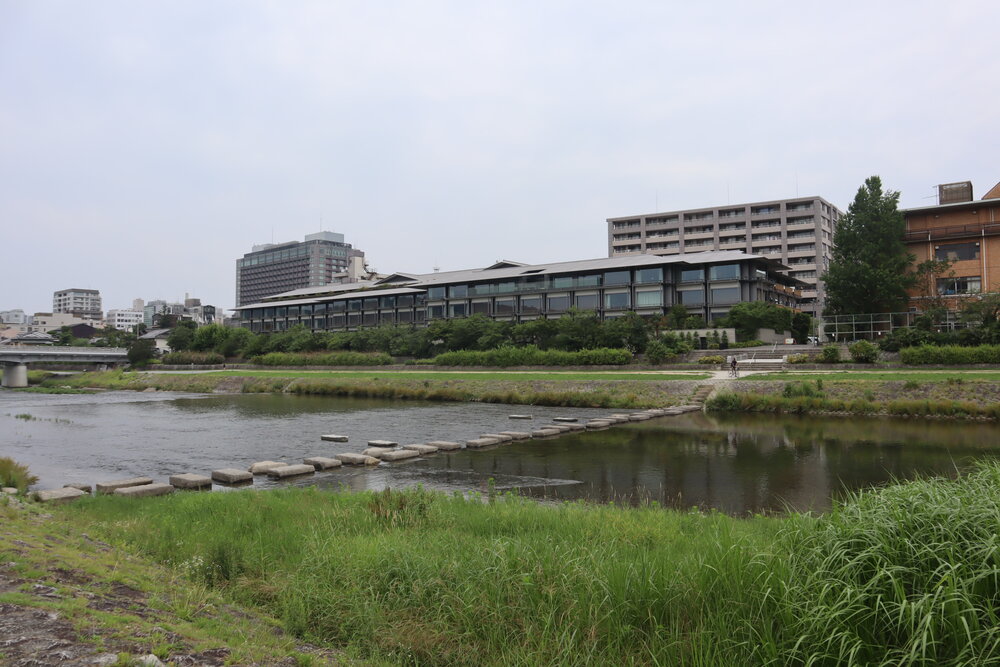
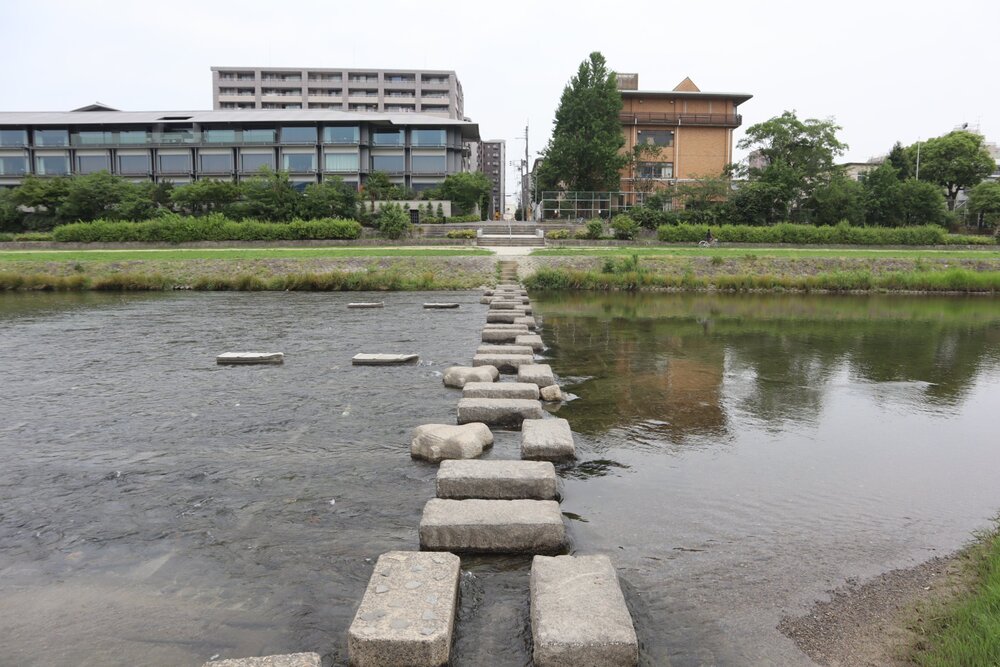
It’s a useful little shortcut across the river to get to the train station (which you’d take to visit the famous gates of Fushimi Inari), and I just thought it was the most lovely thing to have on the Ritz-Carlton’s doorstep, and that it came to perfectly represent the hotel’s emphasis on tranquillity and serenity as we used it to make our way in and out of the property.
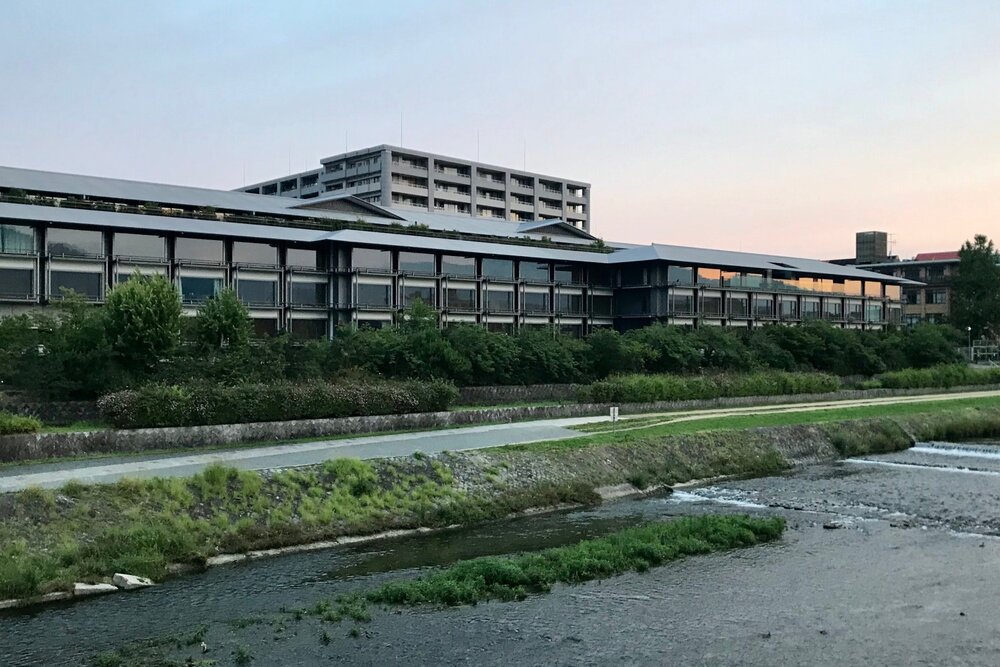
On our final morning in Kyoto, after a truly exquisite in-room breakfast in which Jessy and I kept swapping seats to sample both the Western and Japanese meals, we bid a longing goodbye to our room and hopped back on the airport bus for Osaka Itami Airport.
The hotel offers a number of activities for children, and can arrange balloon twisting, origami folding, and treasure hunts for kids aged 4–12. These are led by their own in-house staff and can be organized individually or as part of their Ritz Kids Night, which is when staff will look after your kids for 1.5–2 hours, while you can enjoy a kid-free dinner.
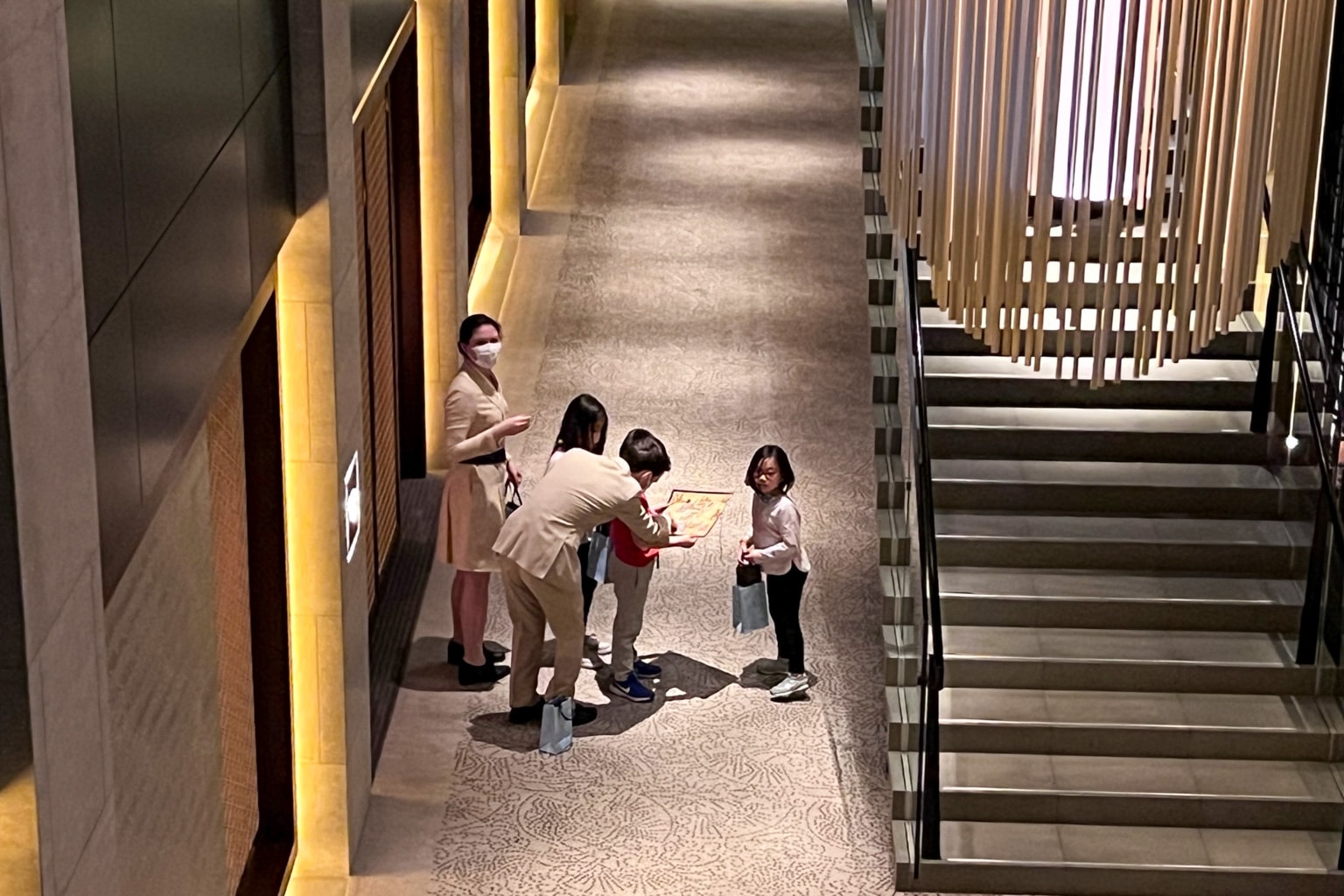
You can arrange for activities via email before your arrival, but you can also book them when you get there.
There also 20 bicycles which are free to use at the hotel, and two of them are sized for children. Advance reservations are recommended due to the limited availability, so be sure to get in touch with the hotel in advance if you’d like to use them.
It’s really nice to go for a leisurely family ride along the Kamo River.
At check-out, the recreation team had personalized thank you and farewell notes for the kids along with a photo of them from the day before during the Ritz Kids Night.

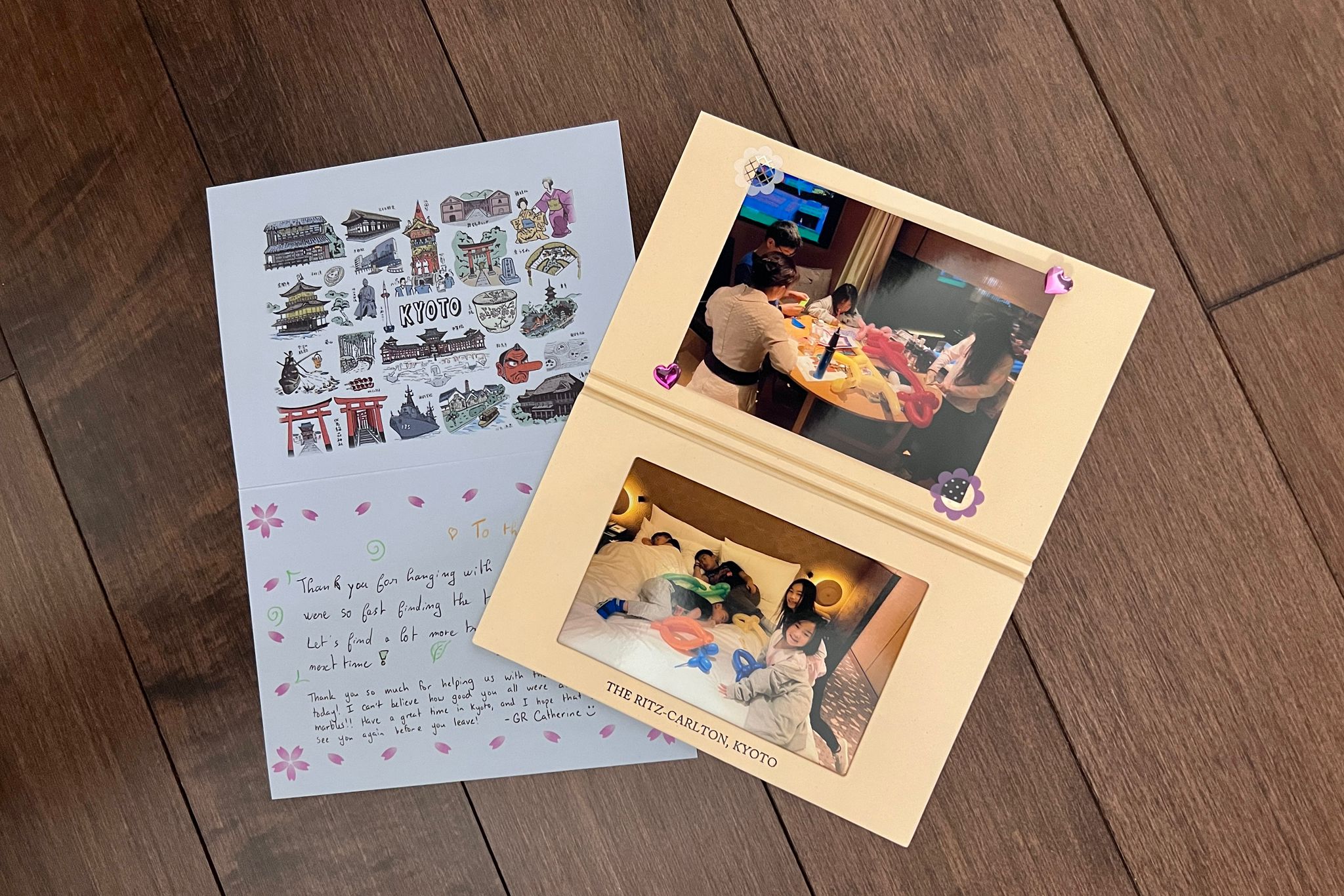
These are all really nice touches that make family stays even more enjoyable.
Conclusion
As far as I’m concerned, the Ritz-Carlton, Kyoto was easily not only the best Ritz-Carlton property I’ve visited, but also the best city hotel that I’ve stayed at so far across all my travels.
Even with no suite upgrade, I felt a sense of unparalleled comfort when spending time in our Deluxe Kyoto Room, as though all the worries on my mind would flitter away with a single glance over at the bonsai tree by the window. Throw in the very generous and highly memorable elite breakfast offering – both in Mizuki and in the room – and this was a near-perfect hotel stay whose memories I will cherish for a long time.
Even if you don’t normally choose to stay at luxury hotels, I’d recommend this hotel as a candidate for a rare splurge if you’re ever in Kyoto, especially if you’re a Platinum Elite member or above and can take advantage of the tremendous breakfast offering.
I’m definitely looking forward to returning to the Ritz-Carlton one day, although the next time I’m in Kyoto, I may also be tempted to try Suiran, a Luxury Collection property in the mould of a traditional Japanese ryokan that’s also known for being one of the best luxury redemptions that Marriott Bonvoy has to offer.








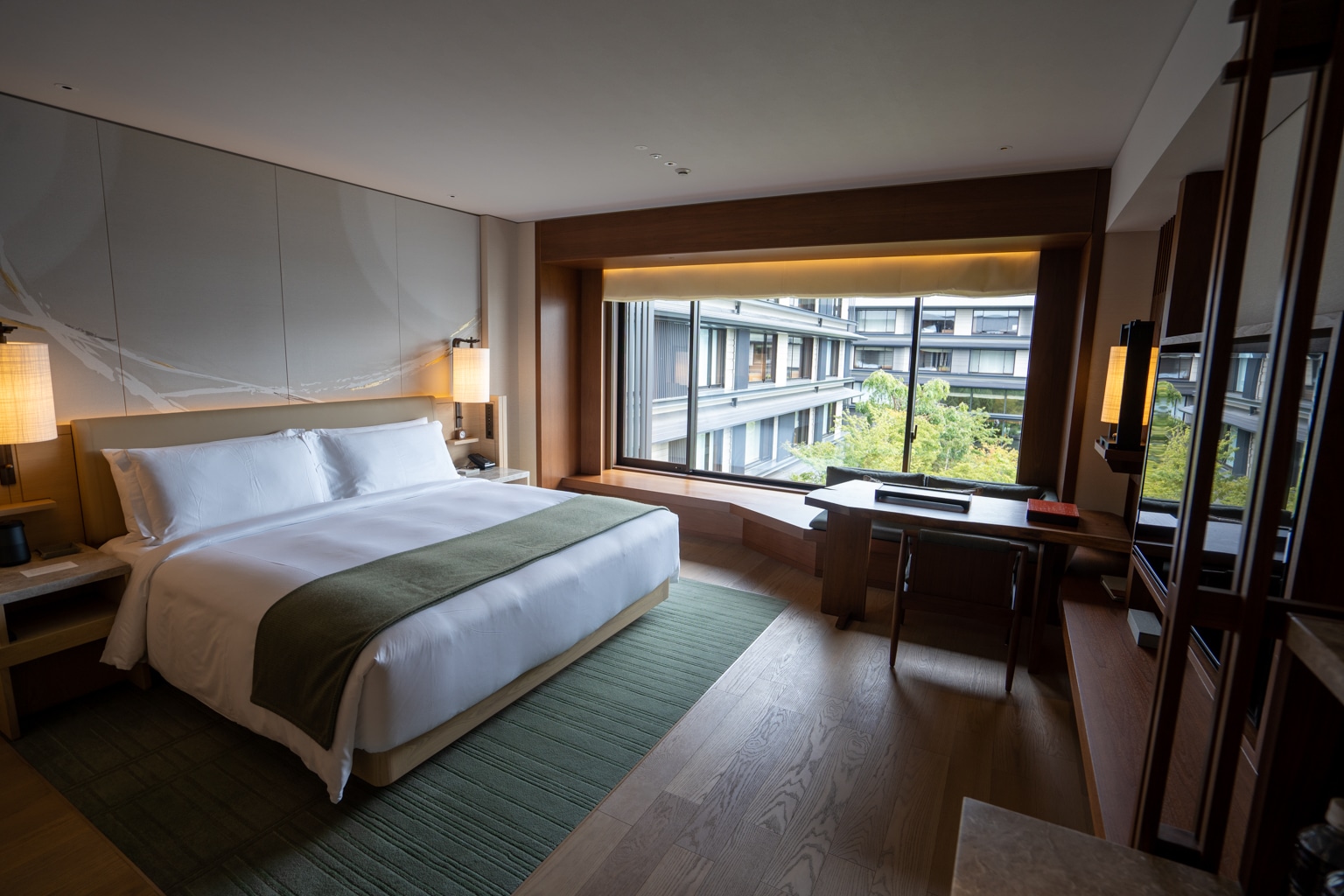
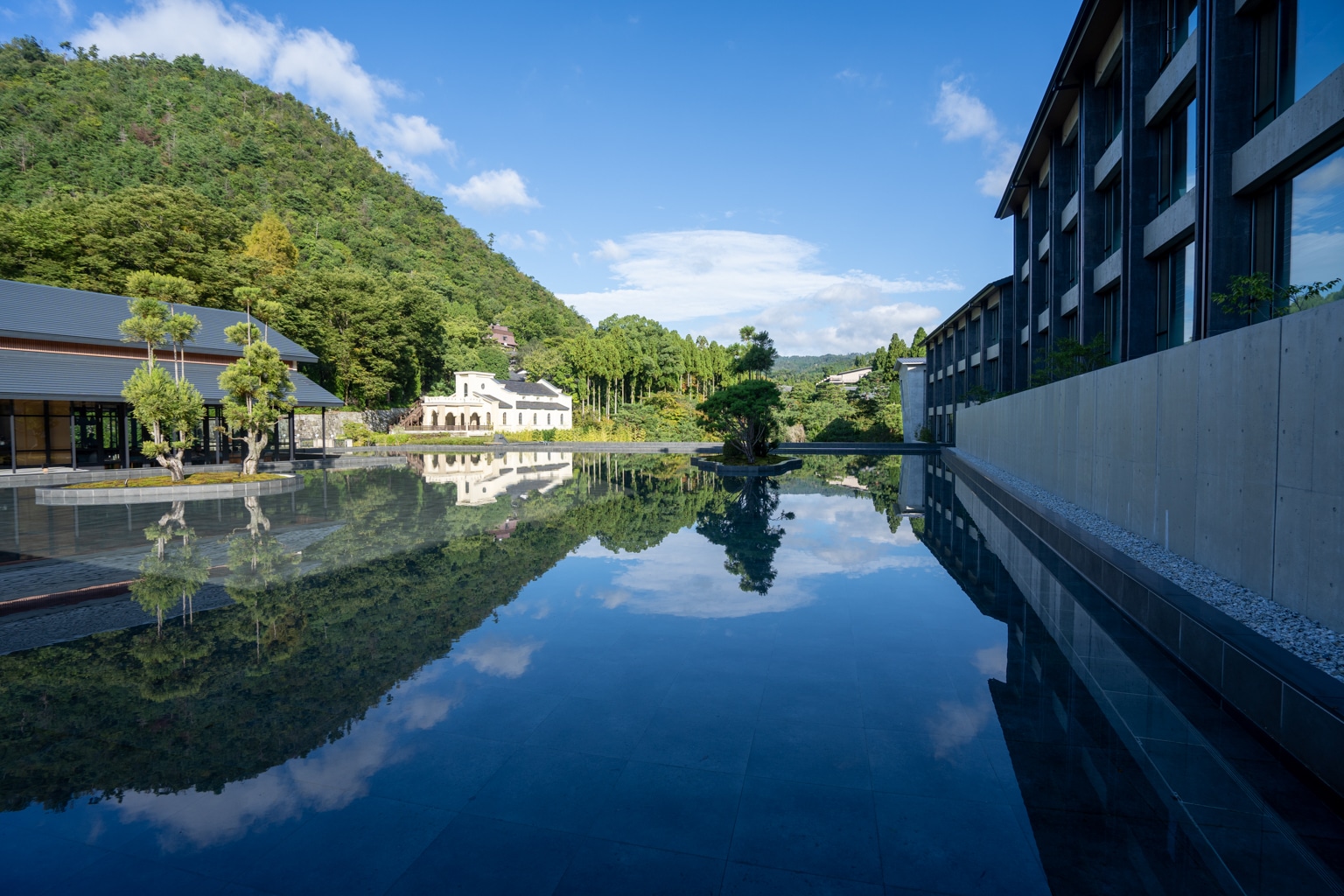
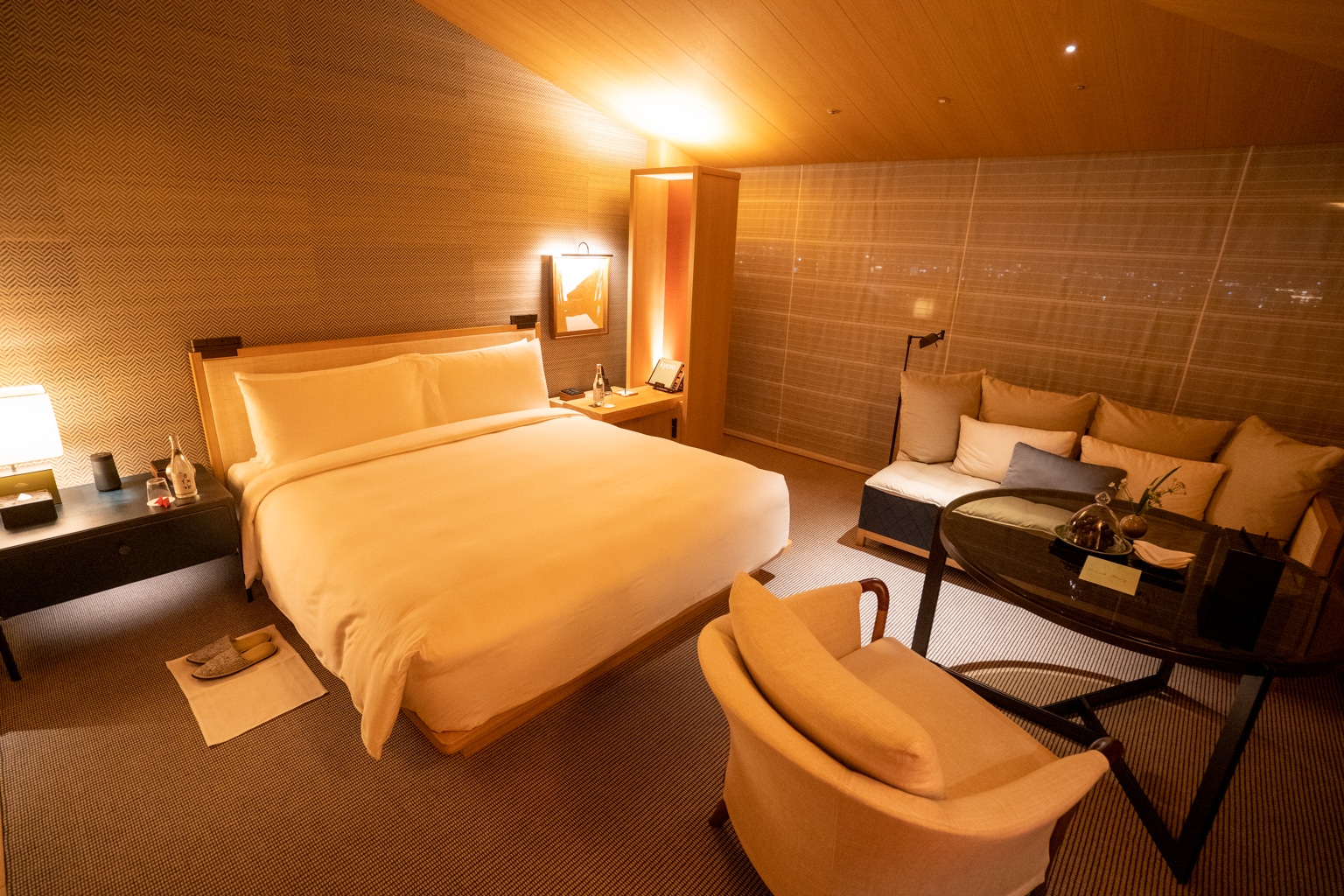
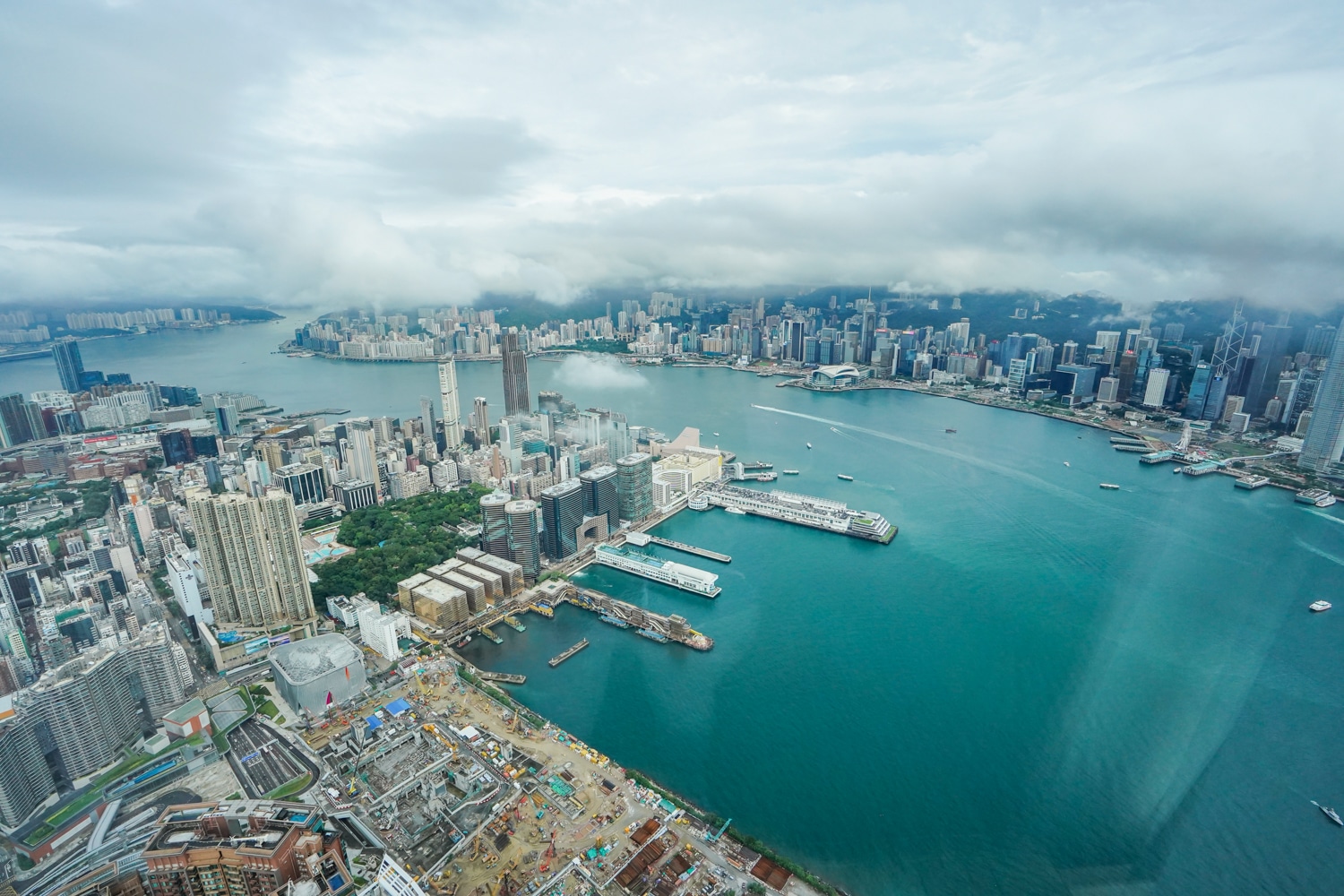

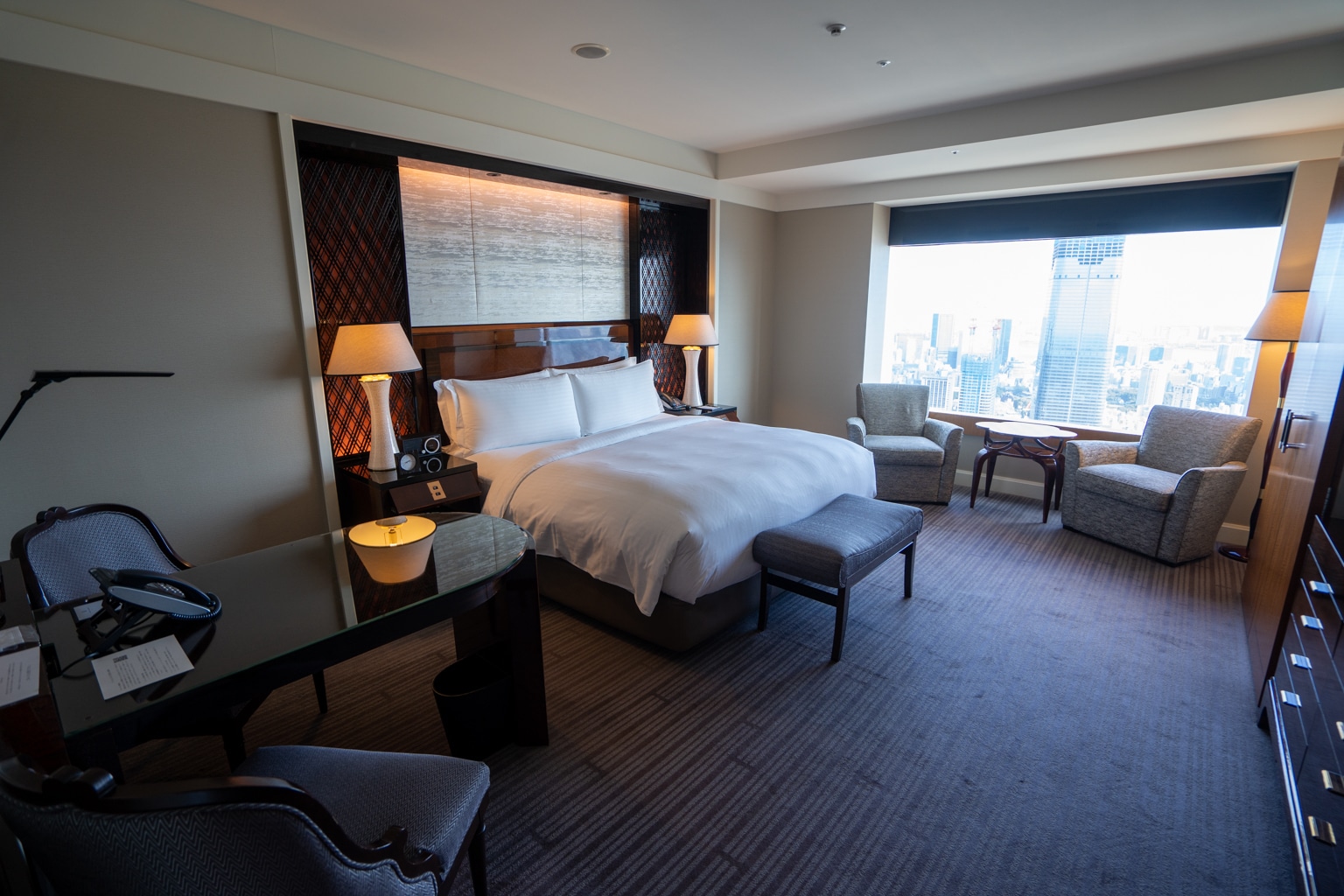
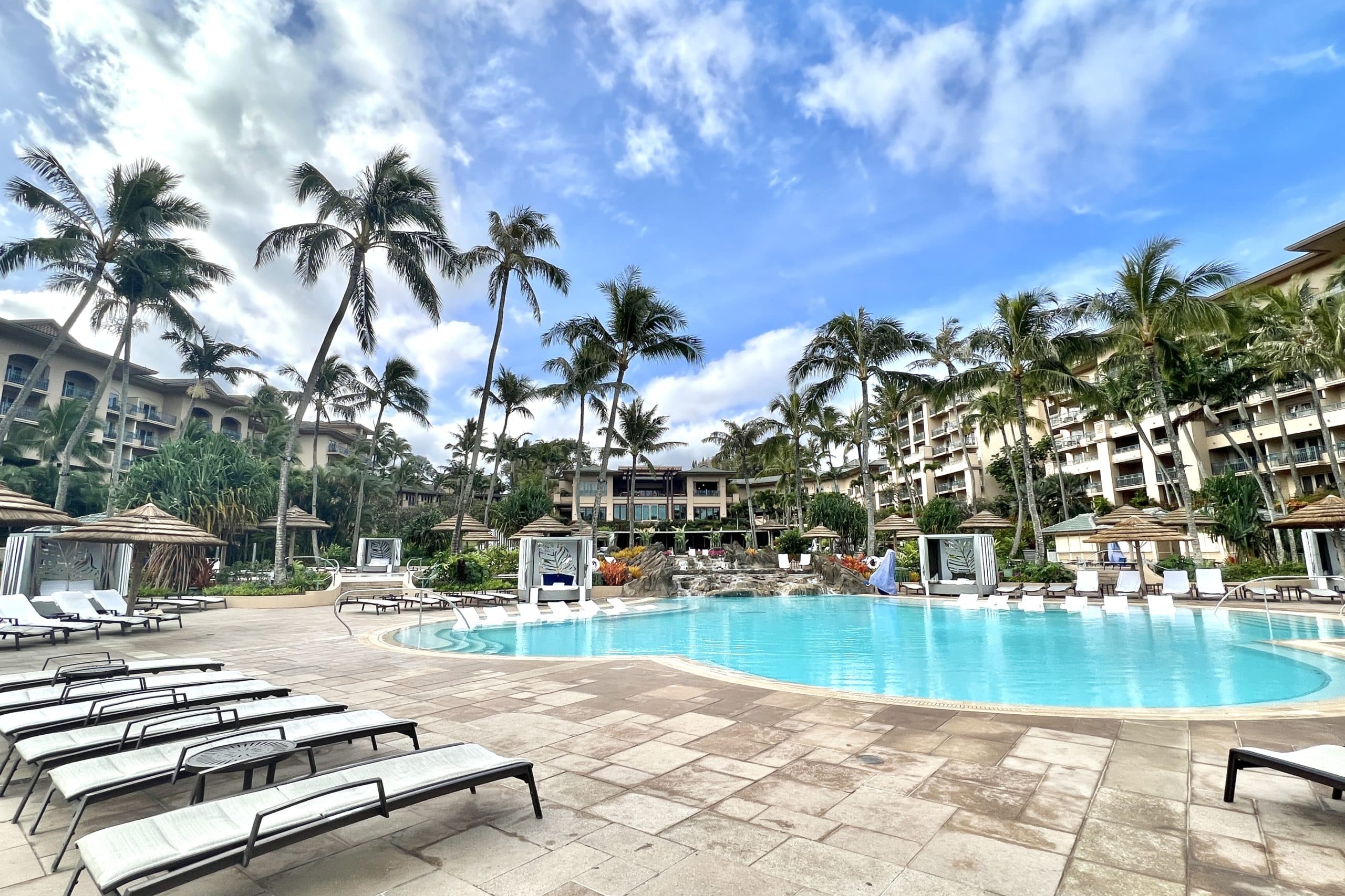
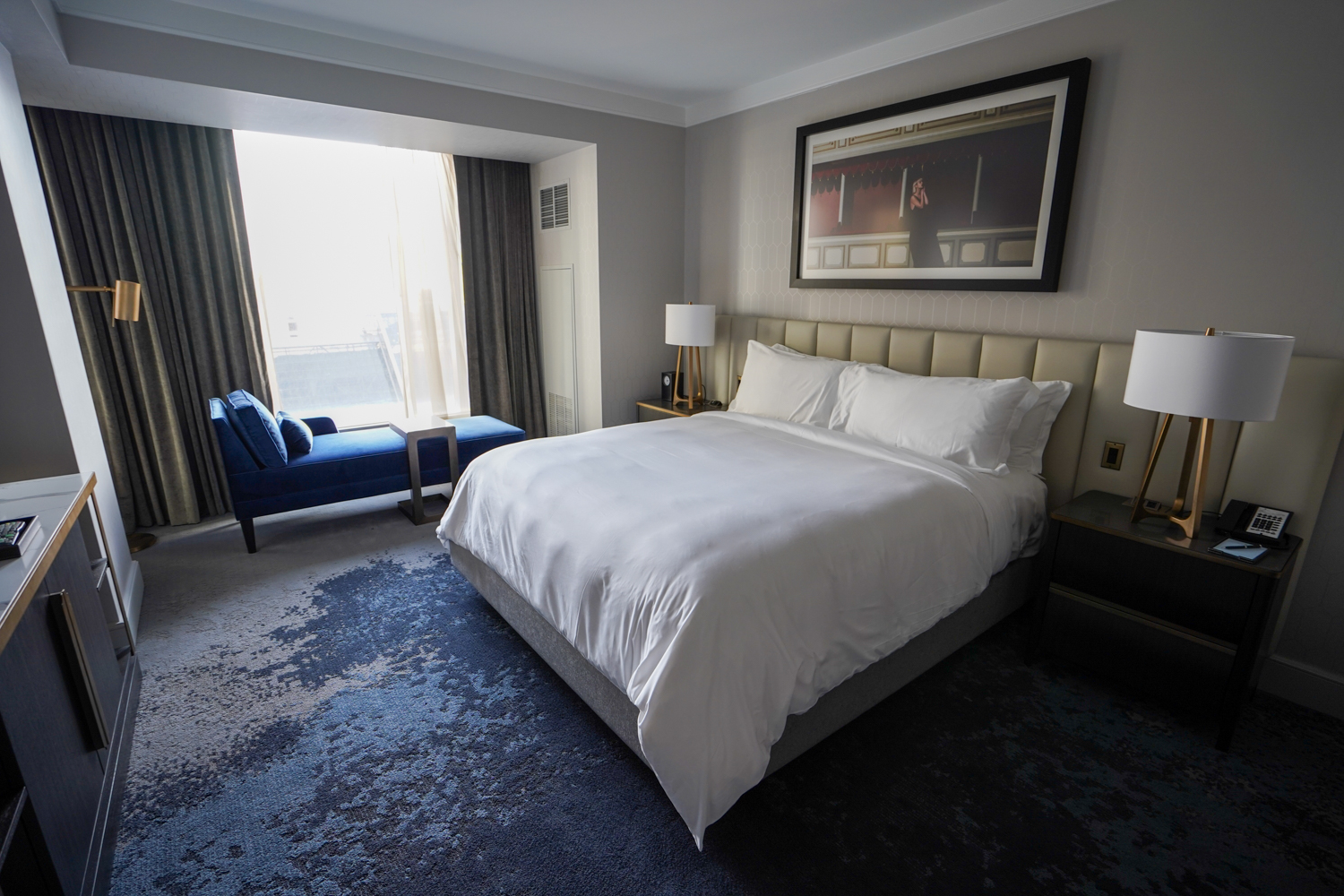
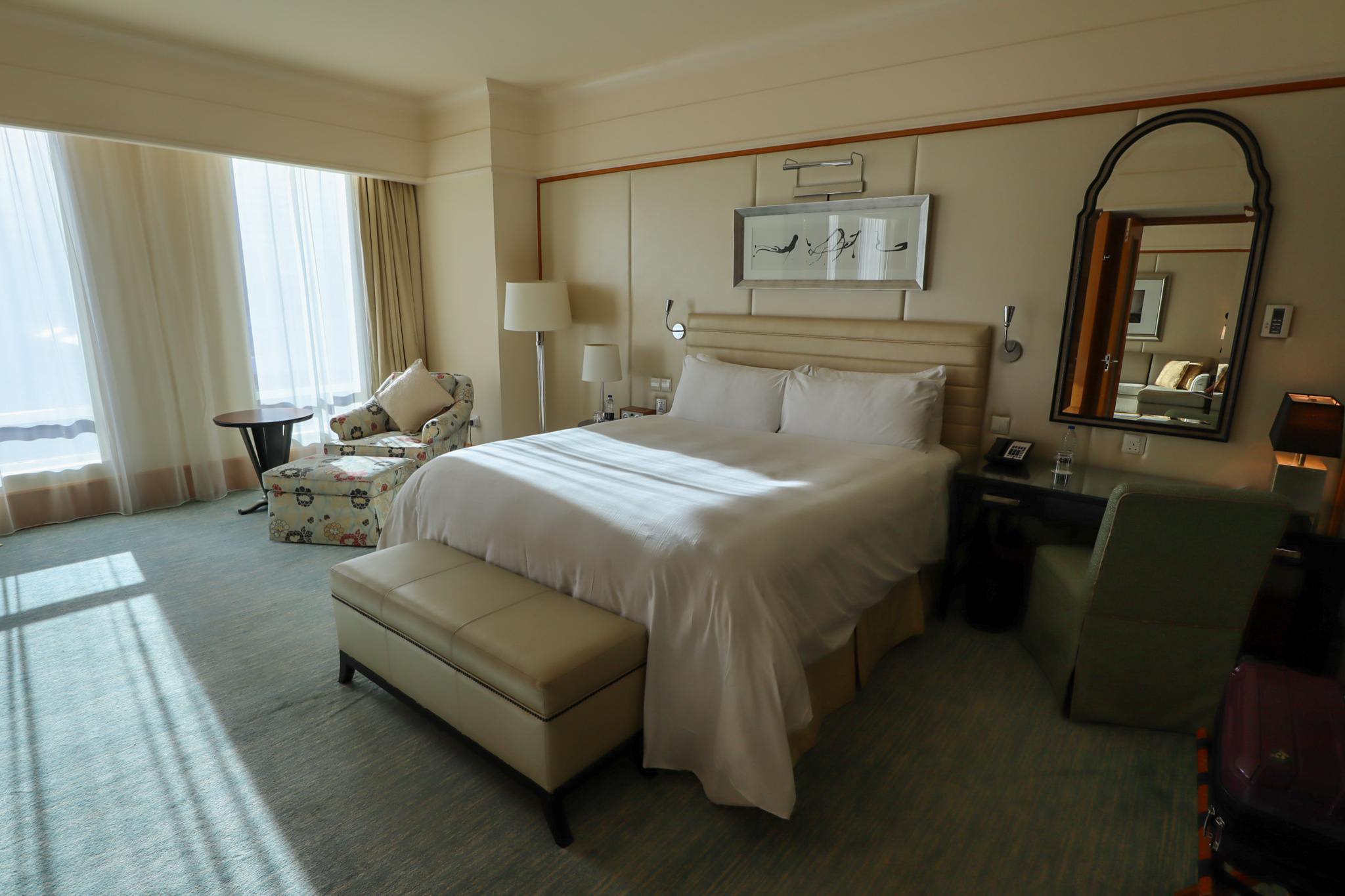
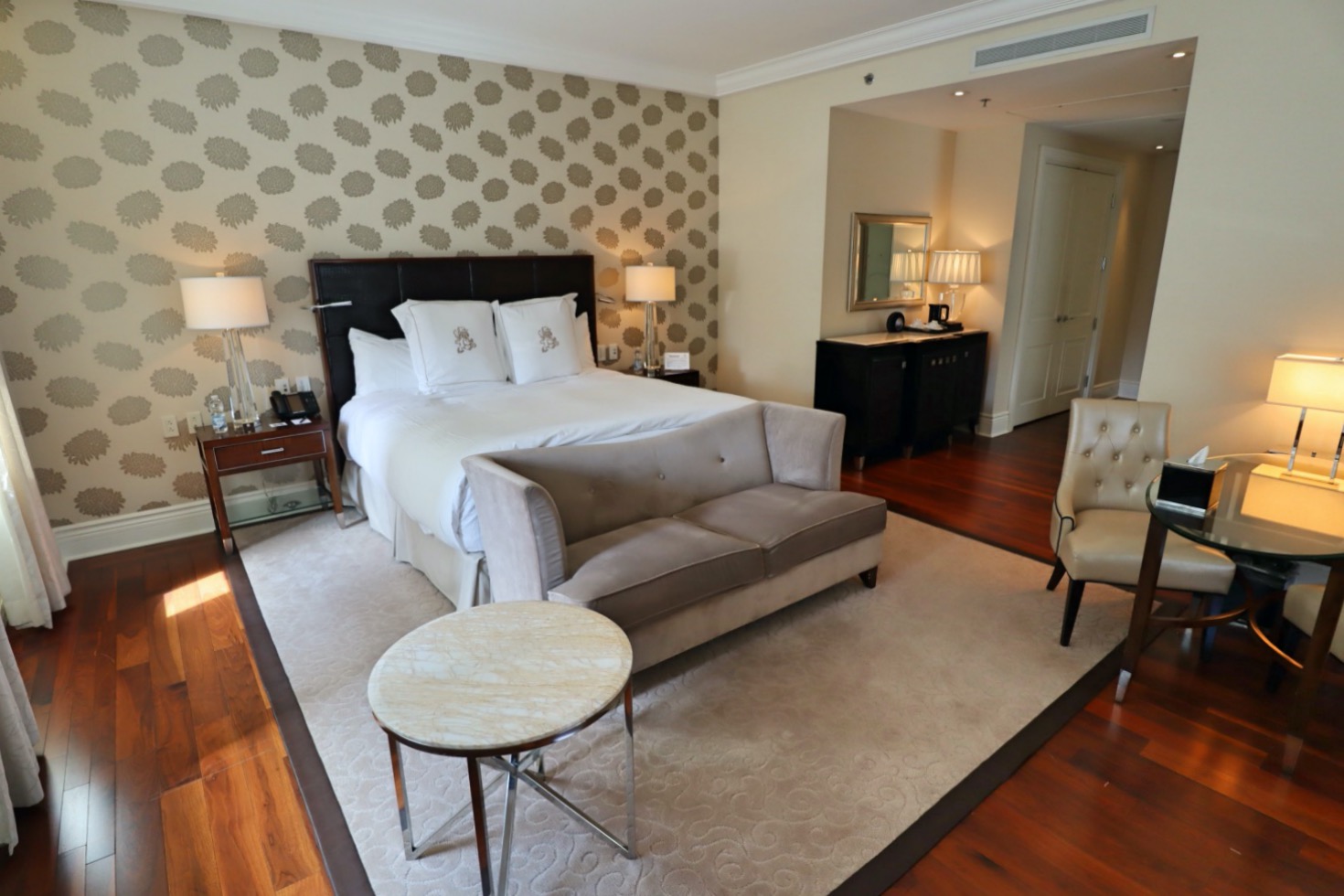
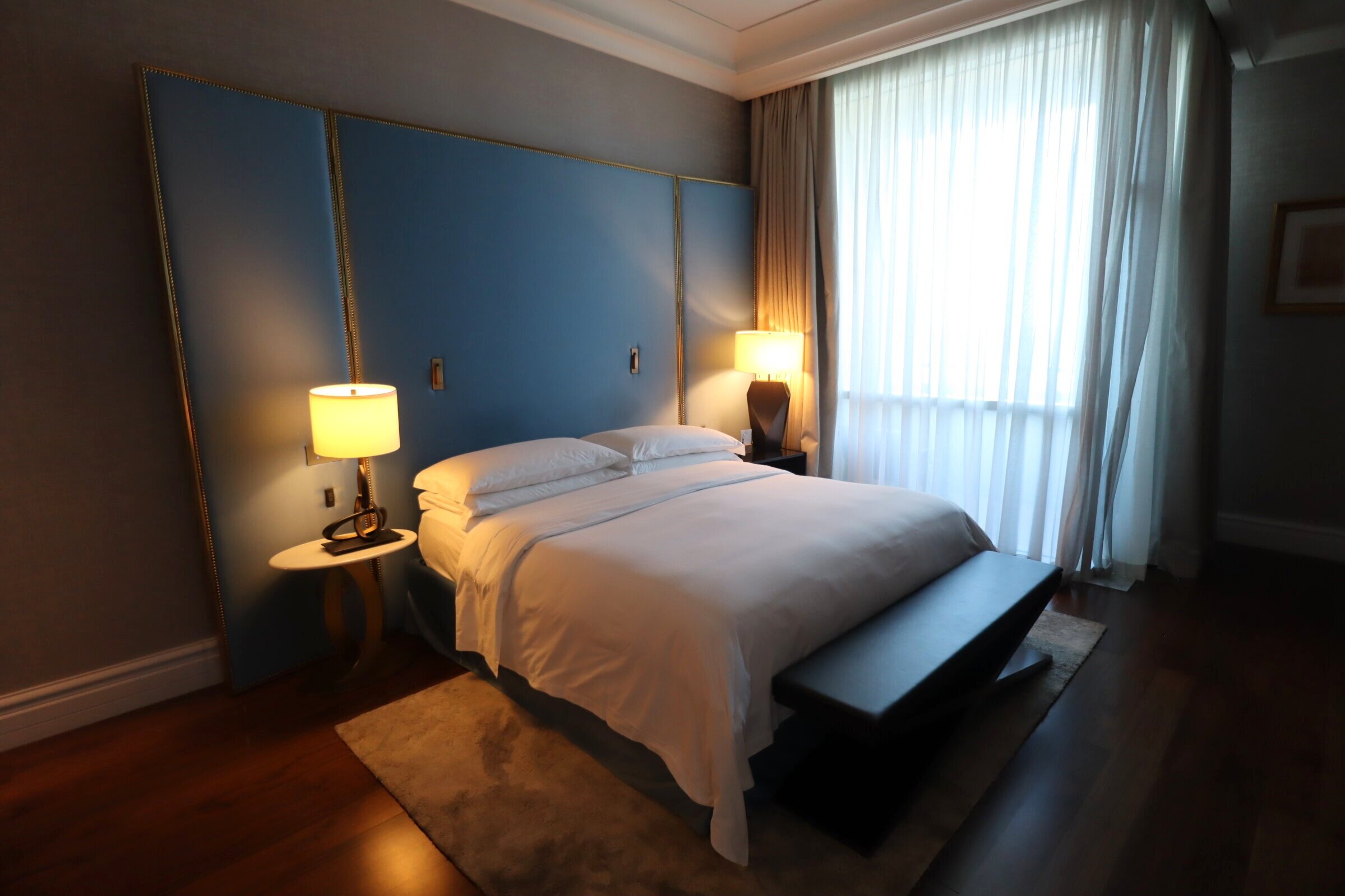
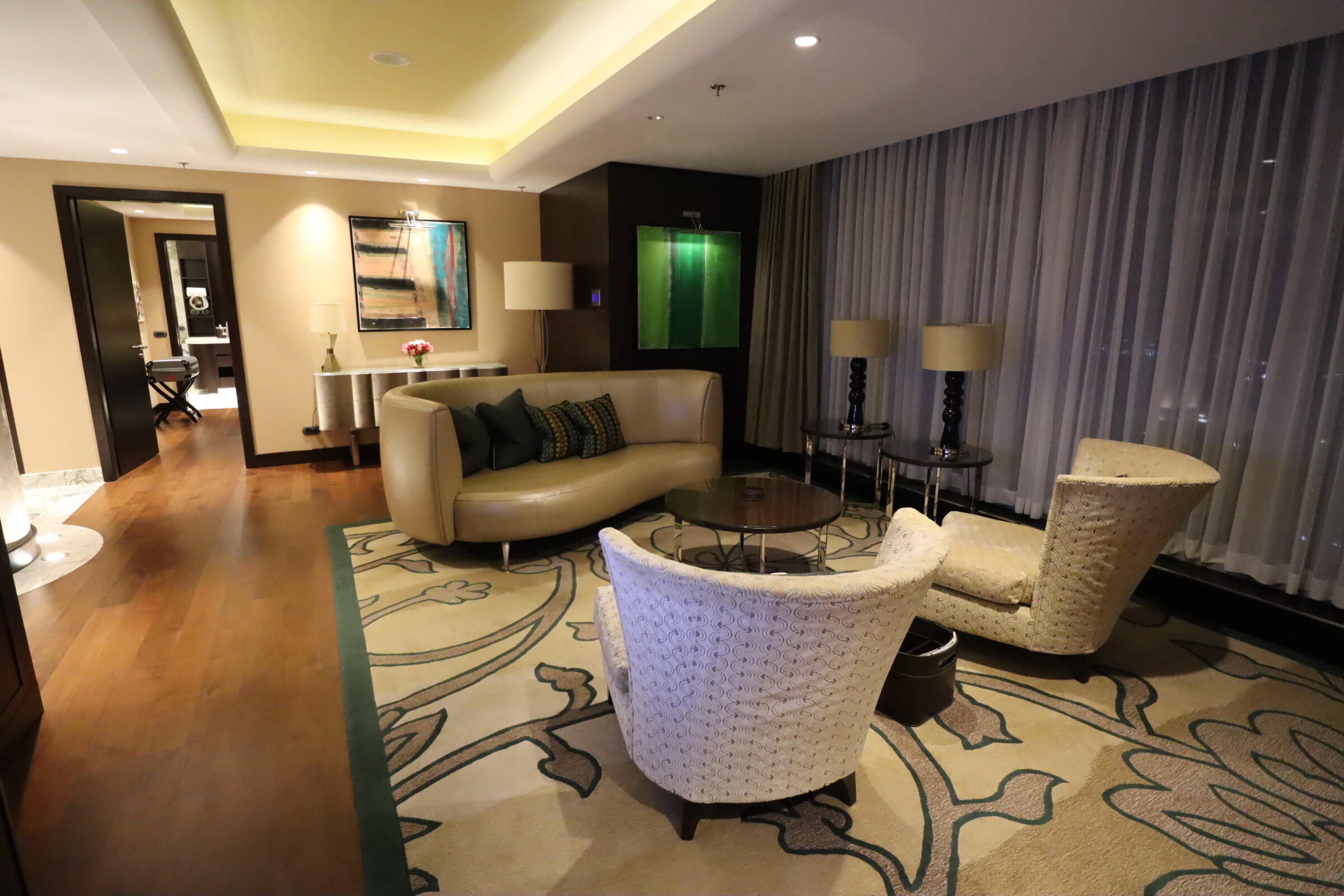
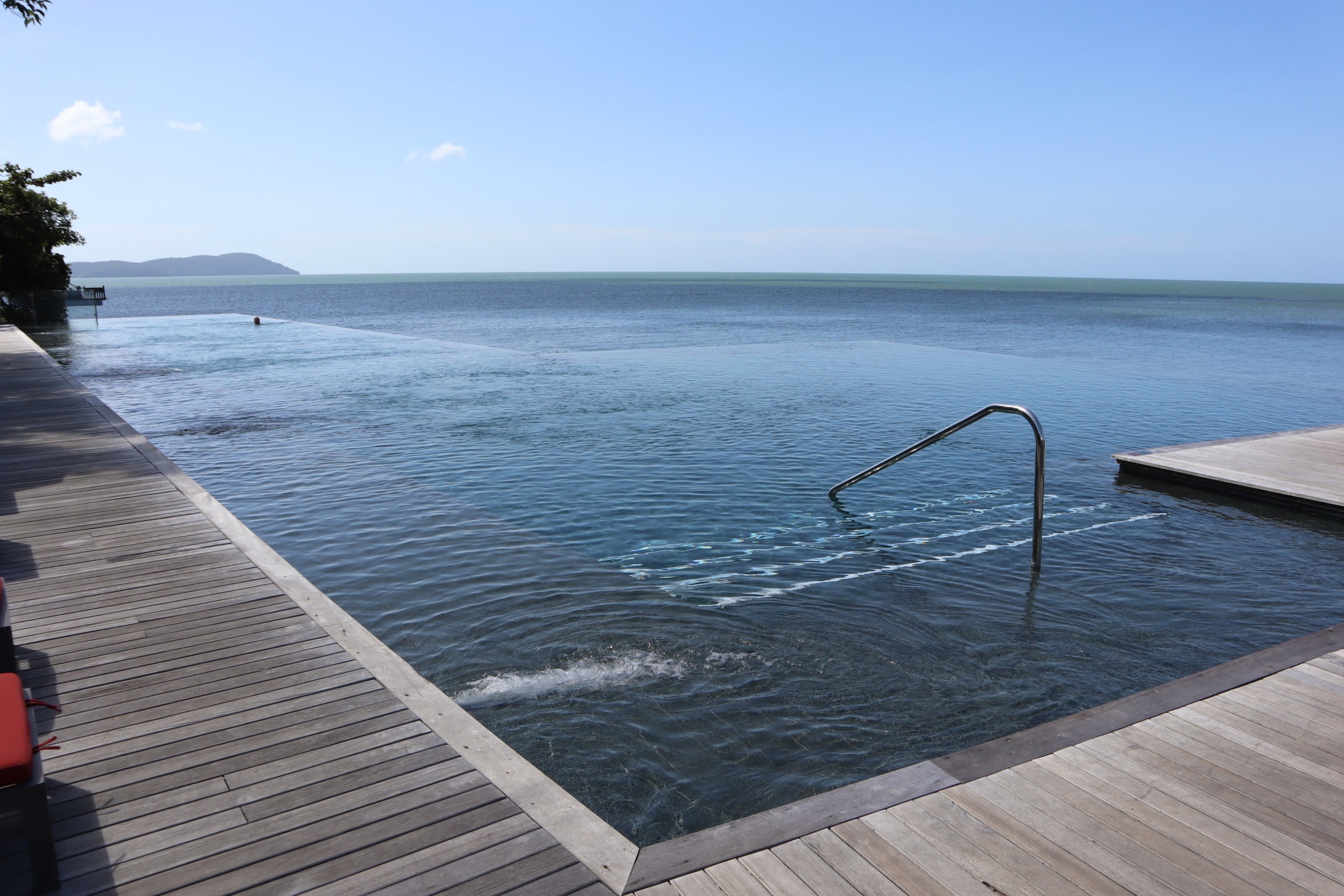












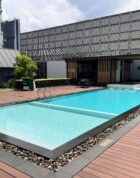

Great review and after staying there myself this is one of my favourite Bonvoy properties ever.
Couple things to add, you absolutely must take advantage of the free bicycle tour that the hotel offers. It was a great couple hours seeing the city and gave us plenty of options of places to go back to if we wanted.
Also, Japanese breakfast fit whatever train doesn’t excite me, but the western breakfast here was top notch. The French toast is a must and is the great I’ve ever had in my life, no hyperbole.
Overall, this hotel is with every penny or point you spend on it
I agree about the bicycle tour. My wife Samantha and our two young kids loved it. We preferred the Japanese breakfast over the Western one though- more to our taste as someone of Asian origin.
Ricky, this was a great review. I definitely want to stay there for a night or two on my next trip to Japan. Small correction: those will be yukatas, not kimonos.
However, I will say that some elements that you mention are remarkably quite common throughout Japan (especially outside of the American hotel chains).
Including breakfast is quite common in Japan ( and dinner as well at Ryokans ), and I suspect that the Ritz-Carlton is competing with non-Marriott Higher-end Ryokans, which all include outstanding washoku breakfast…
Japanese also tend to like to stay at properties with an onsen. Hot Springs are practically synonymous with relaxation and luxury in Japan… and this Ryokan doesn’t have one. I’ve stayed at Kagaya onsen hotel in Wakura ( Kyoto pref. ) and it was just breathtaking. It was part of a bus tour with family in the off-season, so it was an amazing price, but we were taken to our room, asked what time we’d like dinner, and then went down to the hotel’s hot springs. We came back, got into our yukatas, and had what must have been an 8-course dinner served us. I’m pretty sure each server would be handling one… maybe two rooms that whole night. The hotel itself has someone on a koto in the lobby when we entered. It was magical and right on the Japan Sea.
This was 12 years ago and I still remember the meal… sea cucumber cocktails and all! It’s a pity I have relatively few actual photographs.
I’ve also been to small places like Kawa-yu in Wakayama and stayed at a cheap Ryokan and had both fantastic food and service.
Heard great things about Hoshino-yu in Karuizawa as well.
Thanks for your insightful input, Gary, and it now makes a lot more sense why this Ritz-Carlton in particular goes above and beyond with the elite breakfast offering.
On this visit to Kyoto, it was definitely a tough choice deciding between the Ritz-Carlton (and the Suiran) and one of the excellent traditional ryokans in the area. Your comment has inspired me to make some time for a ryokan on the next trip.
Quick etiquette question….do you tip when you receive a complimentary platinum/titanium breakfast? or is it "included" within the free benefit?
As Ricky mentioned, you would not tip,
This is particularly so in Japan, where in some cases, it could be considered inappropriate ( to accept ). Although they DO appreciate the gesture and understand that’s how you’re showing appreciation, it actually can be difficult to accept.
I can’t speak for the rest of Asia, but in Japanese culture the reason they won’t accept it is because they don’t view themselves as giving the service… but rather service is a product of the whole hotel working. The server presented the food, but the experience ultimately was a product of the kitchen, the host, the ones who set the table, the ones who went to buy the ingredients, the ones that decided the menu, the person who trained them on service etc. They view themselves as representing the whole and their service is a product of the whole hotel, not them alone.
If they did accept it how would they split the tip? How much would each person get and who gets it… it just adds another thing to think about. As such, people prefer to be paid by their employer rather than directly by the customer.
Of course, this isn’t universal and there are definitely ways of "tipping" in Japan, but they’re more based on long-term relationships and have a gift-giving element to them.
Usually not, unless the service was truly exceptional (and I also usually don’t have cash on me). Like Kevin said, it’s always a relief when travelling in Asia where I know people aren’t expecting a tip.
A few people have asked about this recently, so it could be a worthy blog post sometime soon.
Well, this is Japan so Ricky had the easy choice of not tipping.
For NA, thats a good question, but I would lean to "yes" as I bet they would expect a tip even if the food is free…
I hear you there, Kevin… I’m annoyed by the automatic expectation of a tip even at what amounts to fast food restaurants.
Remember kids, when it’s considered mandatory, it’s not a gratuity, it’s a service charge.